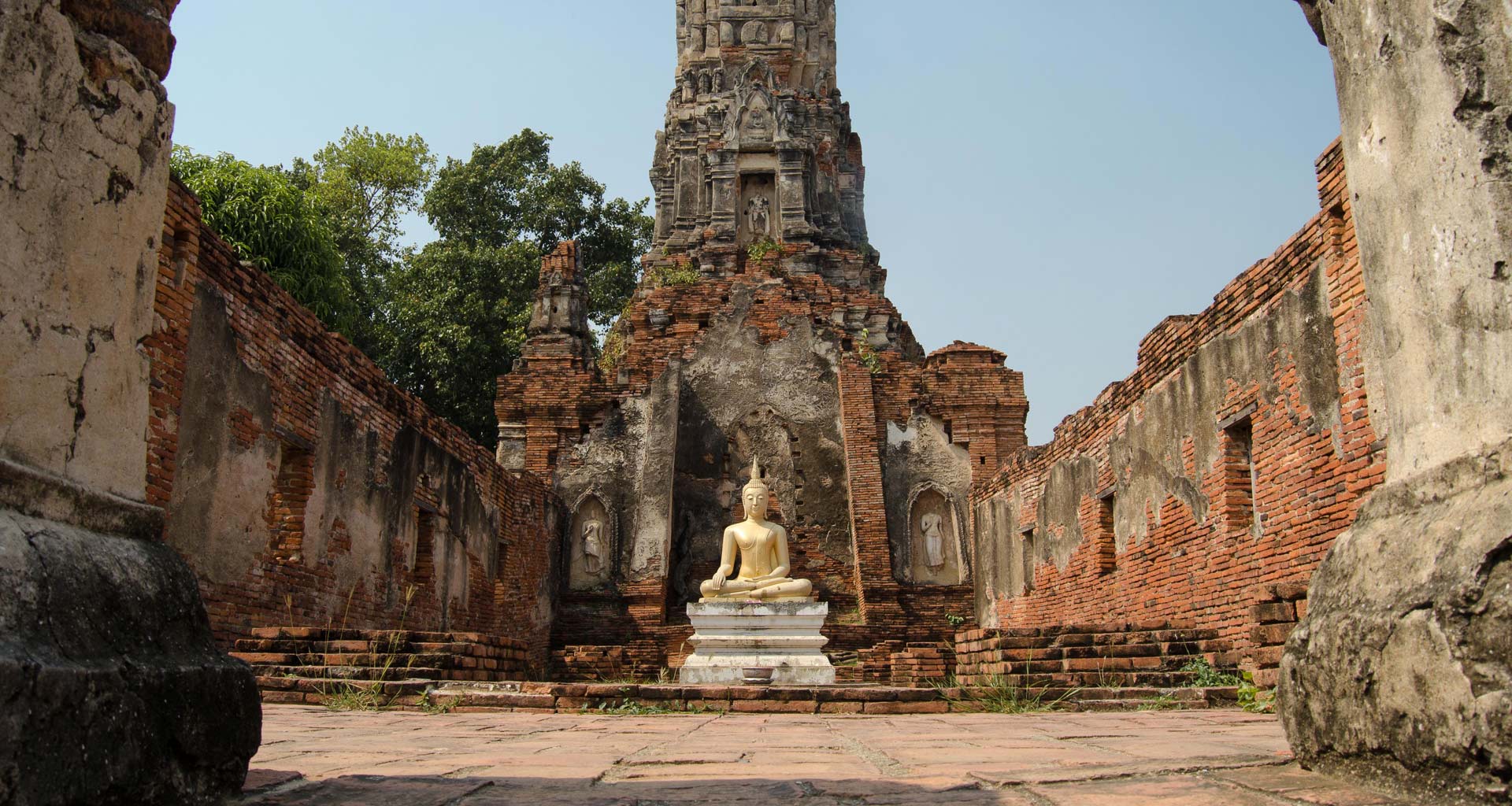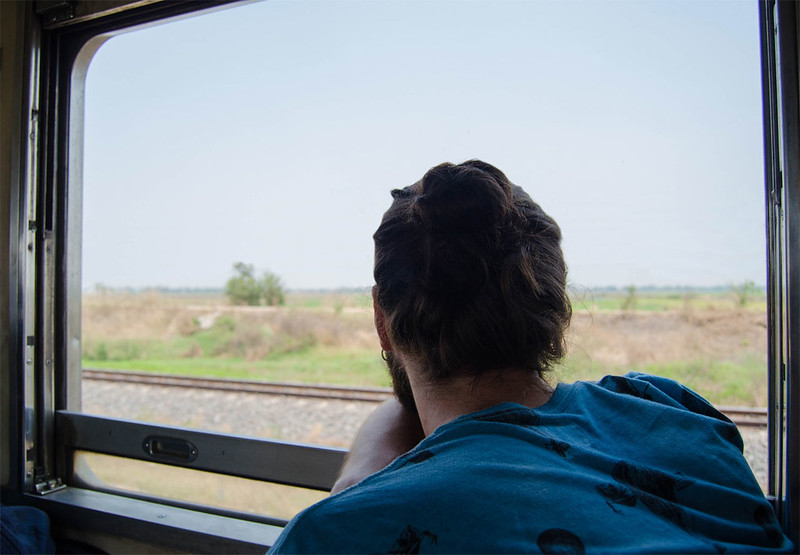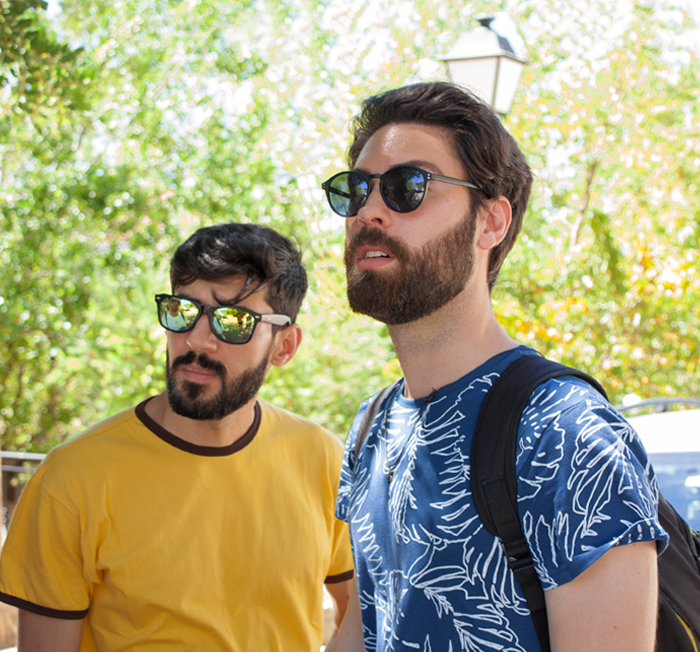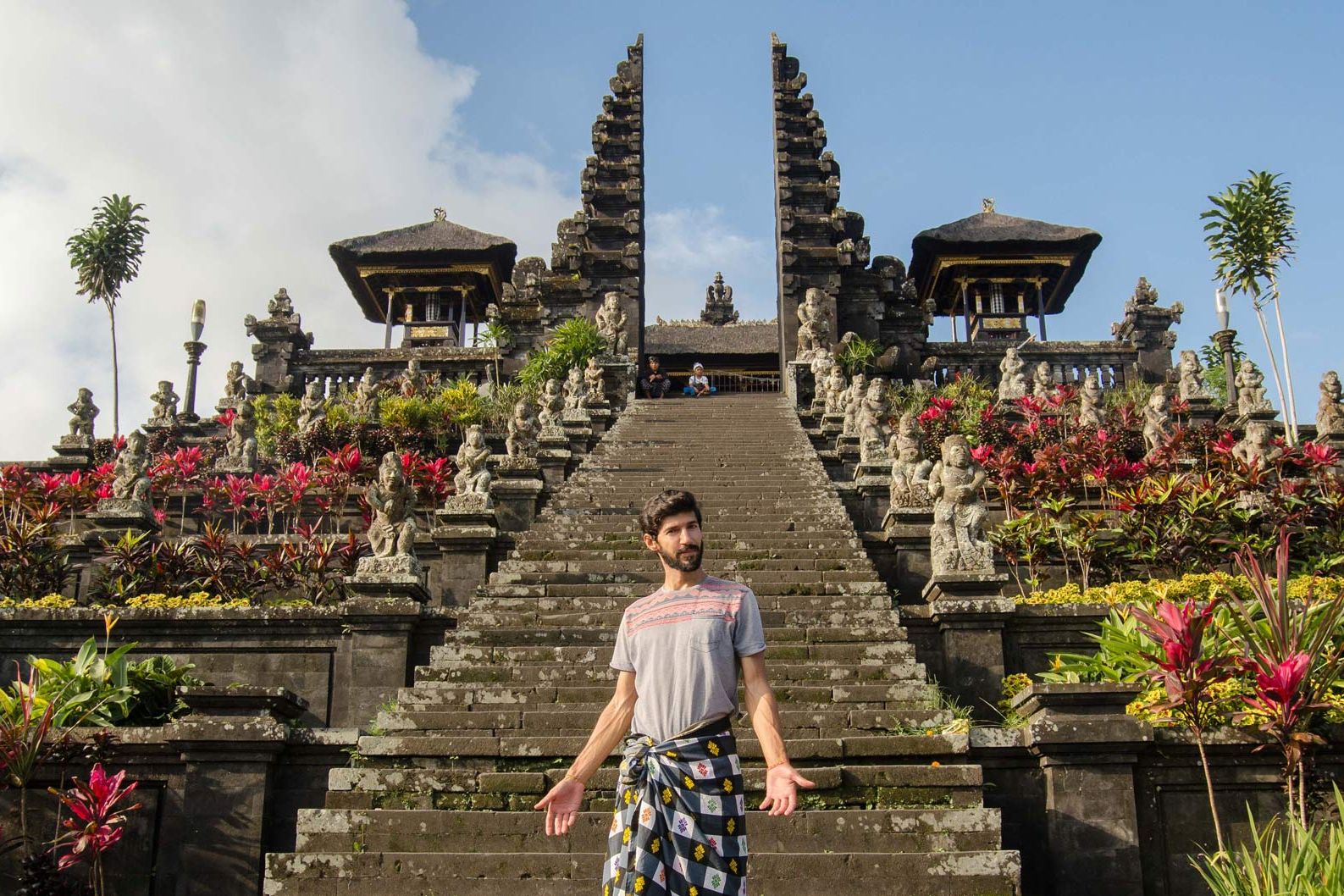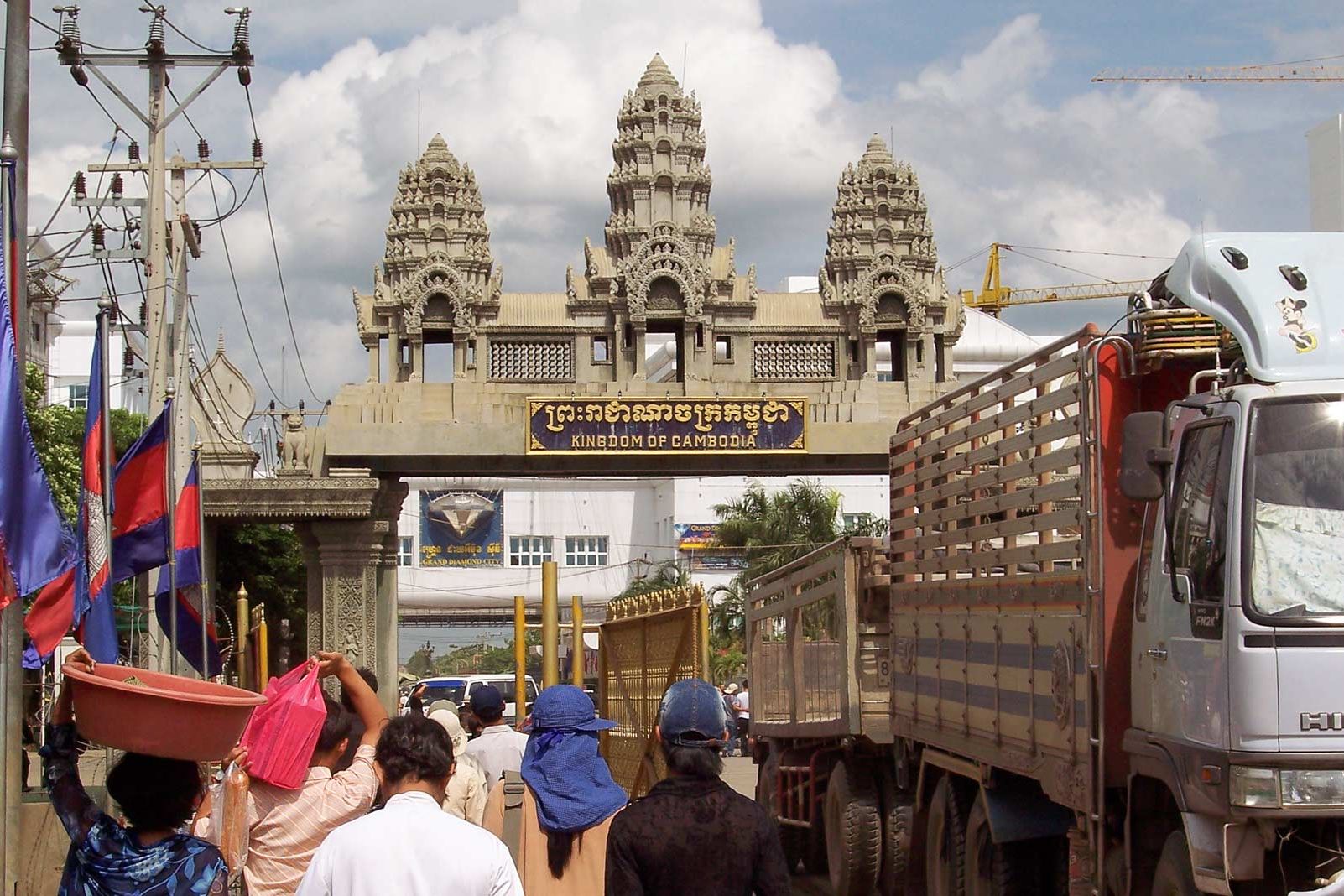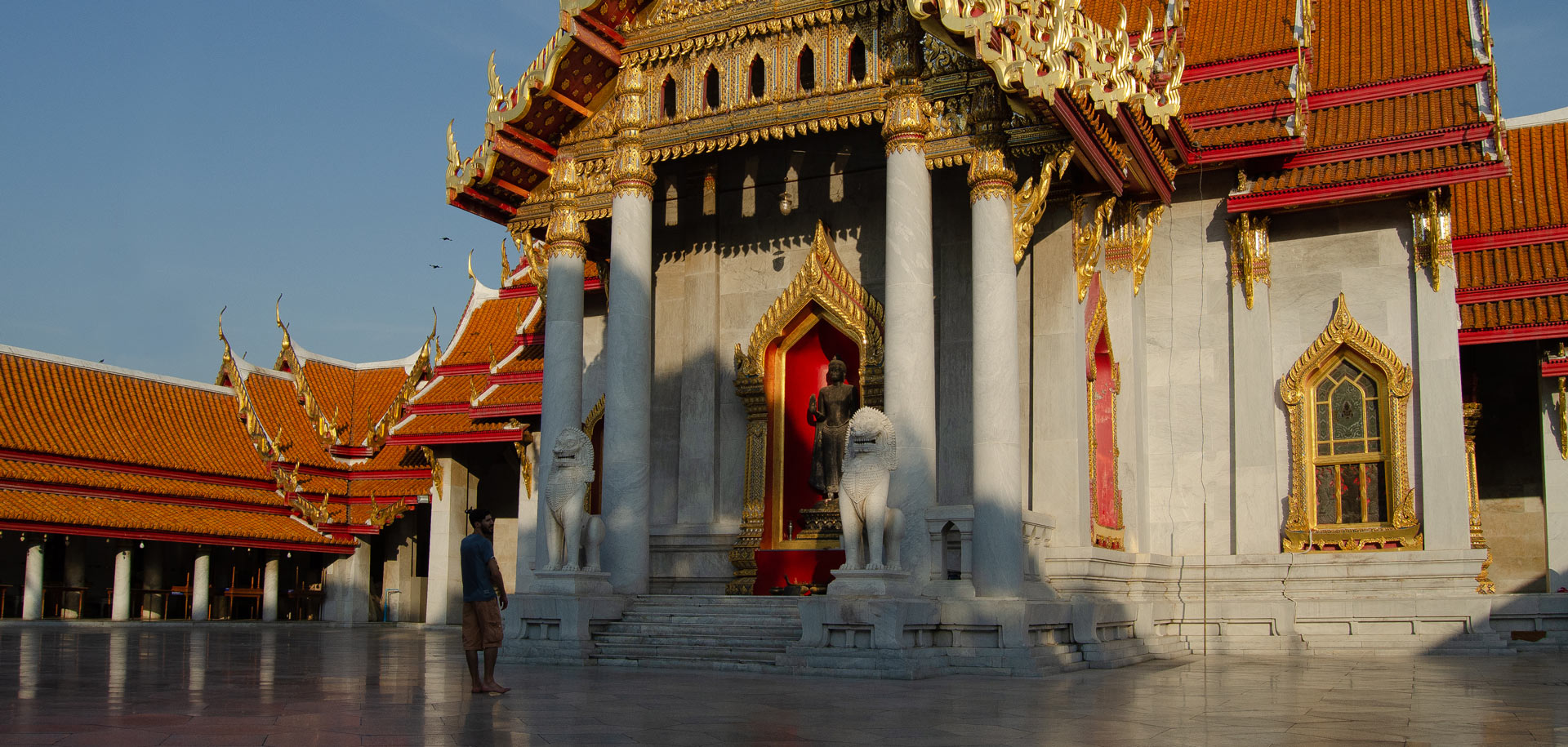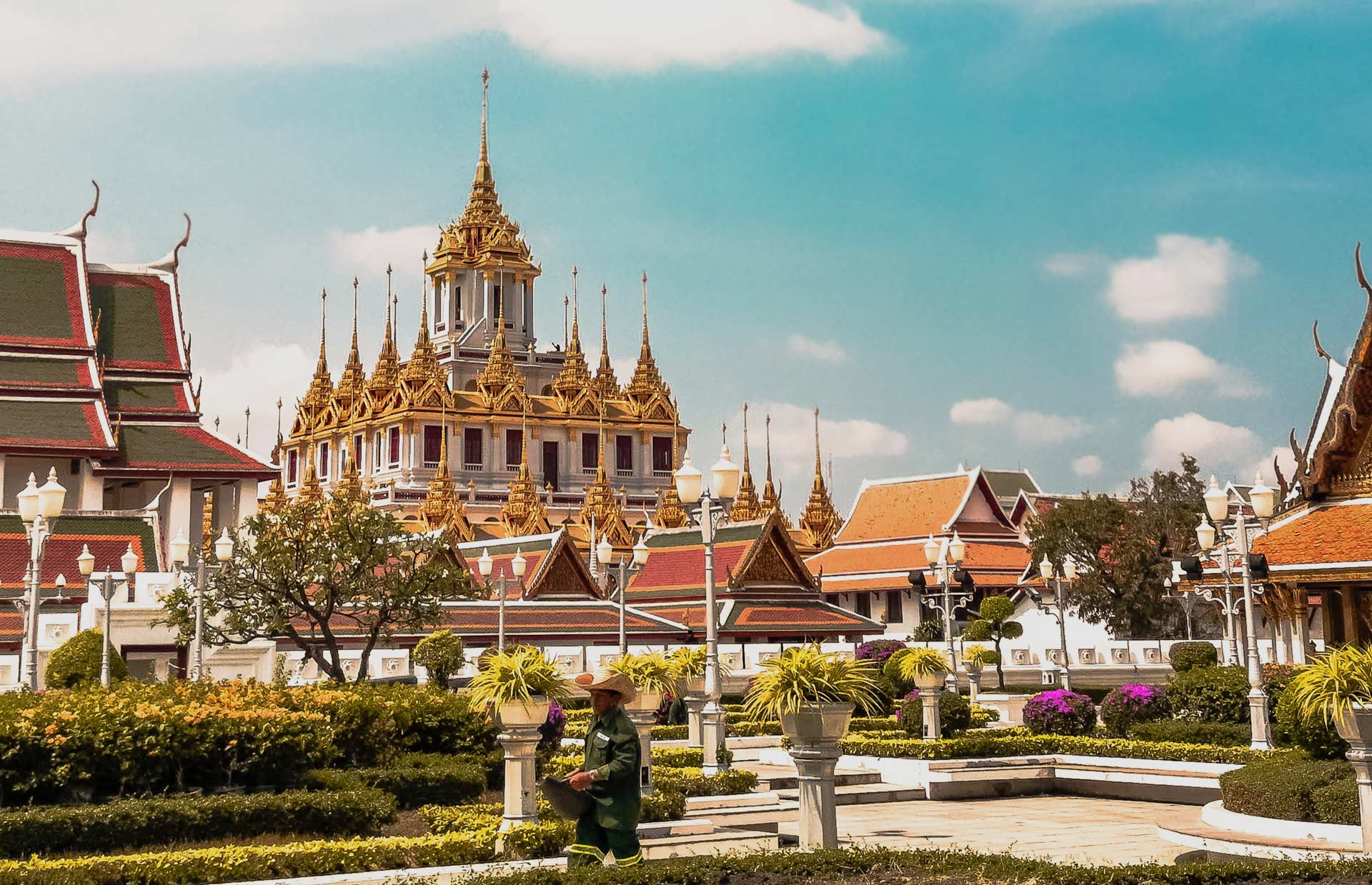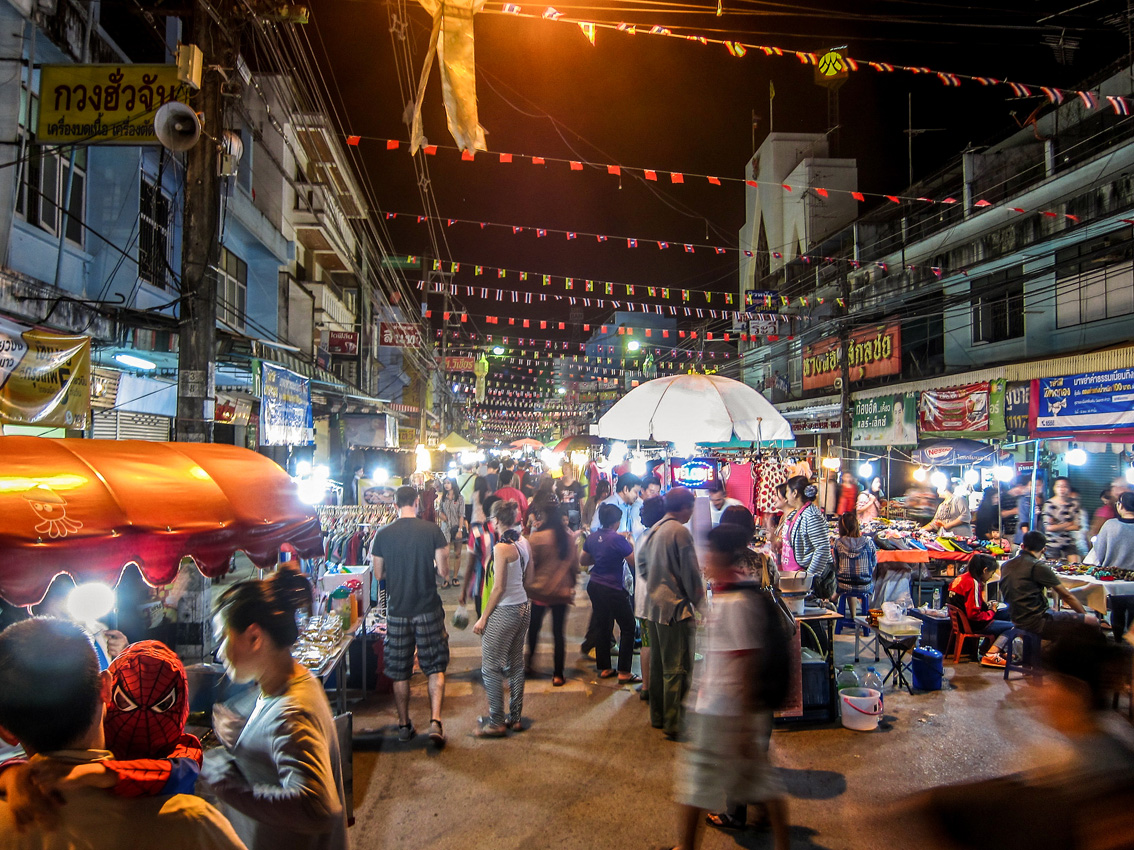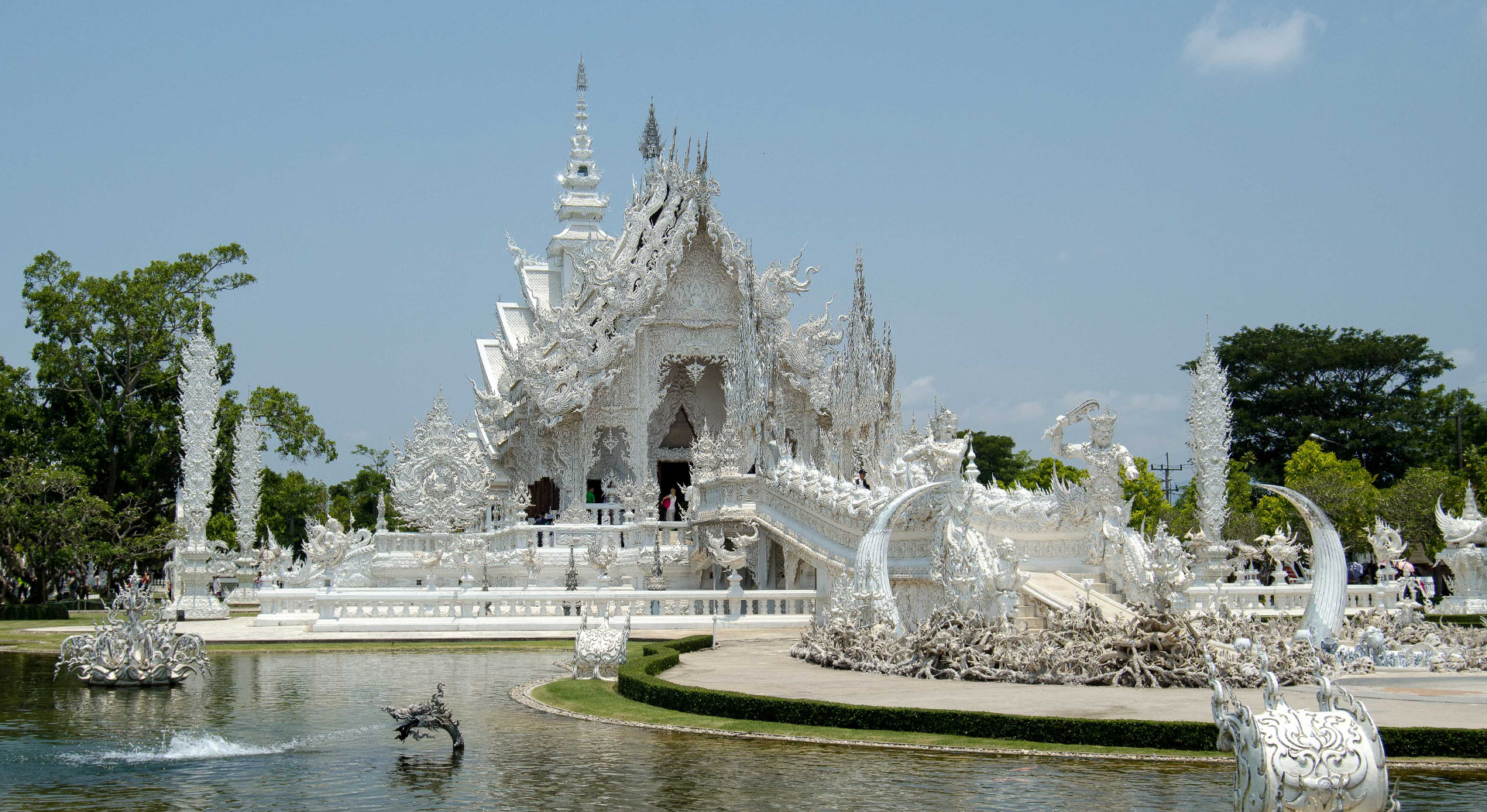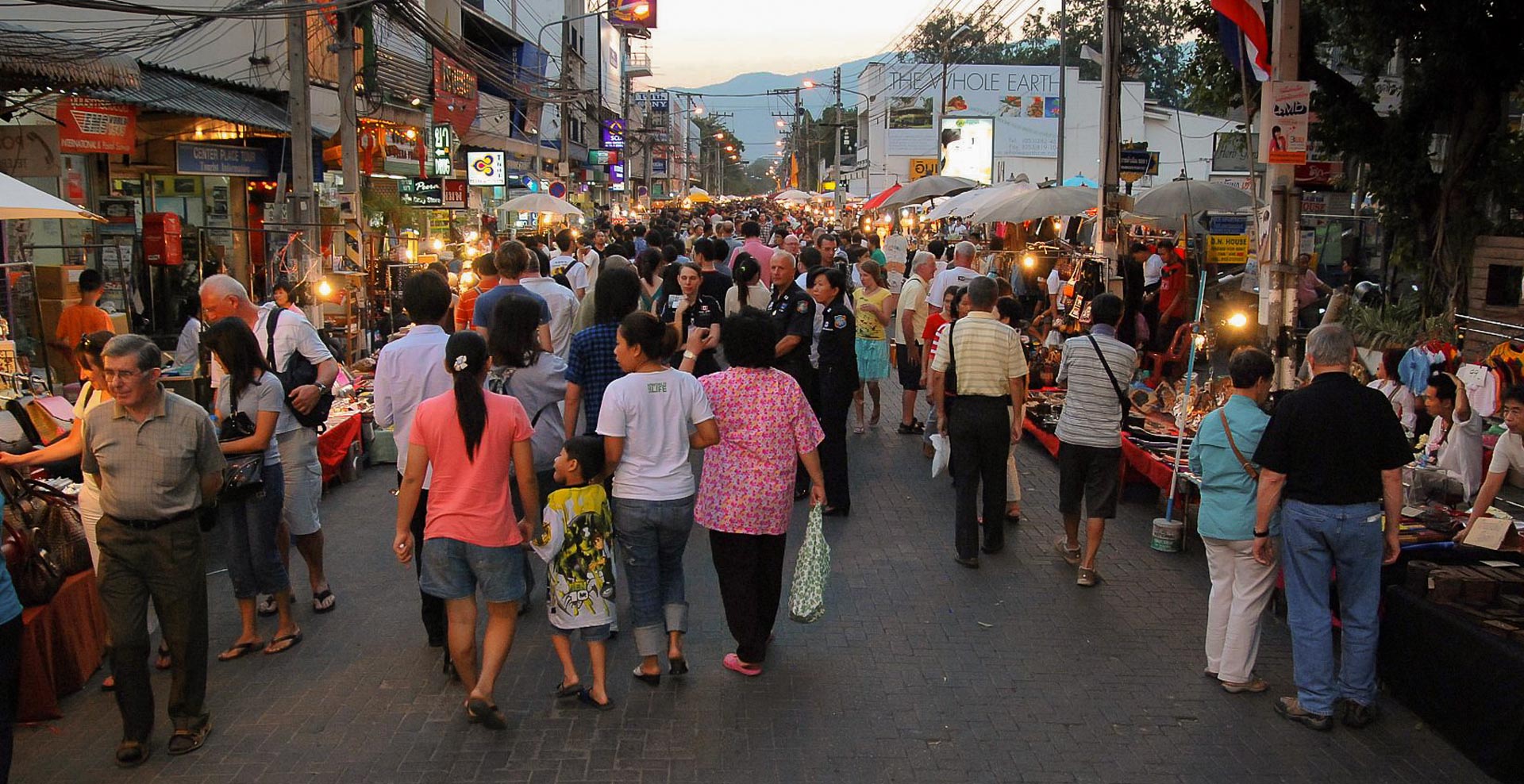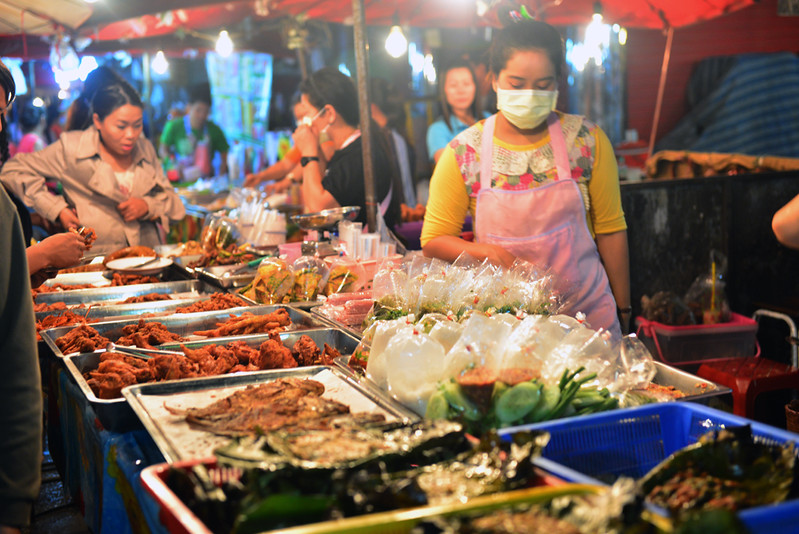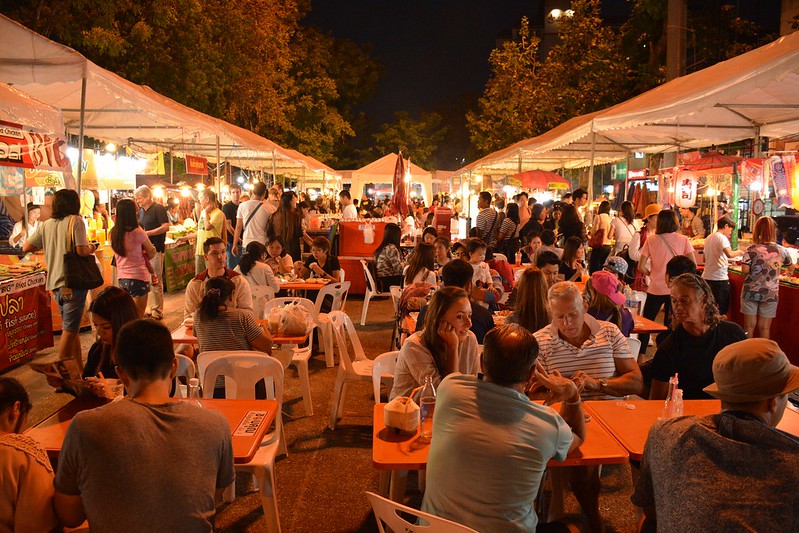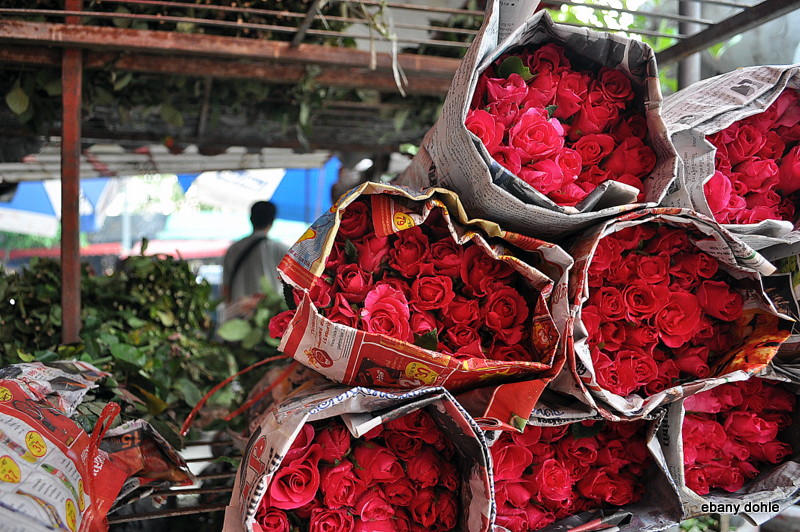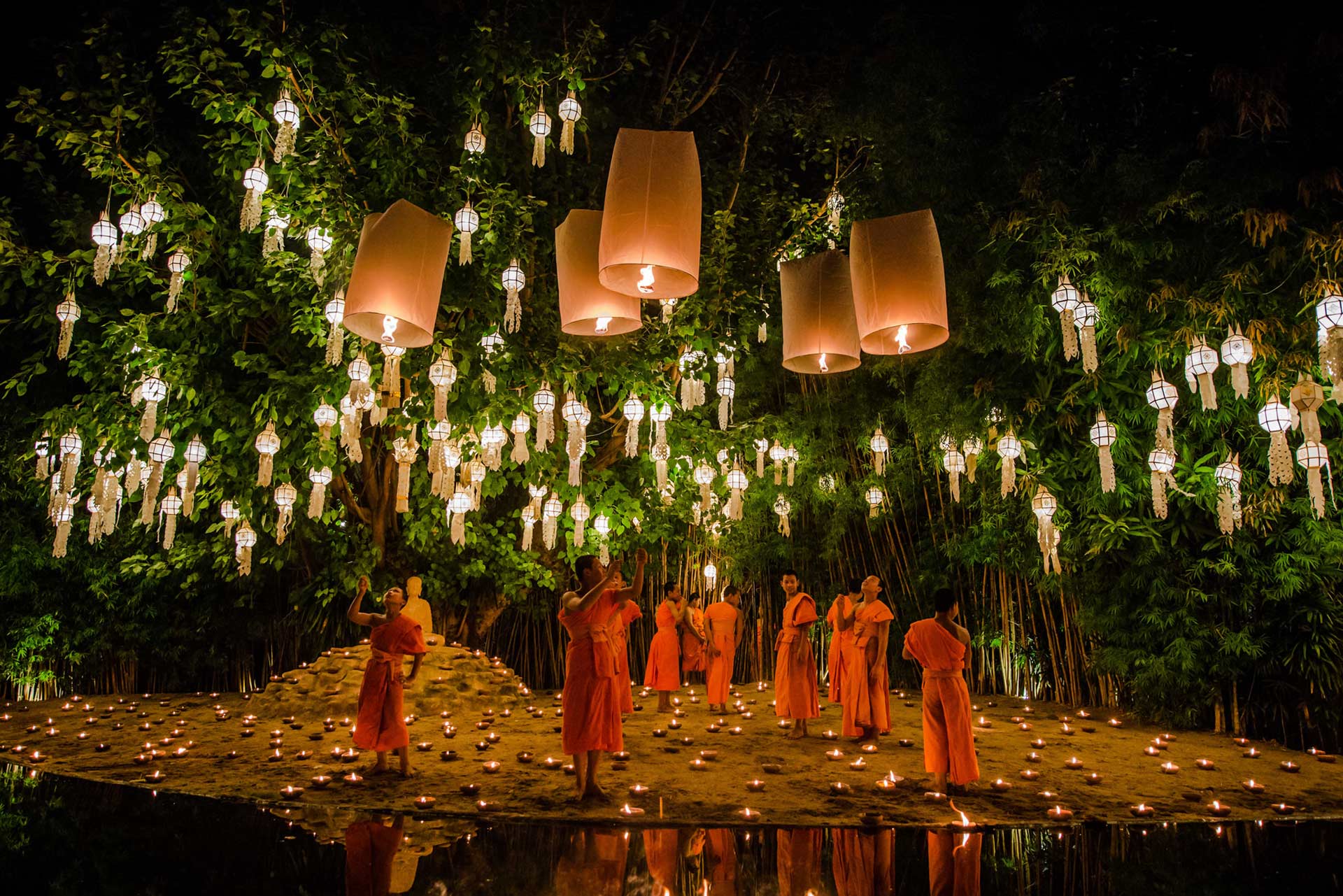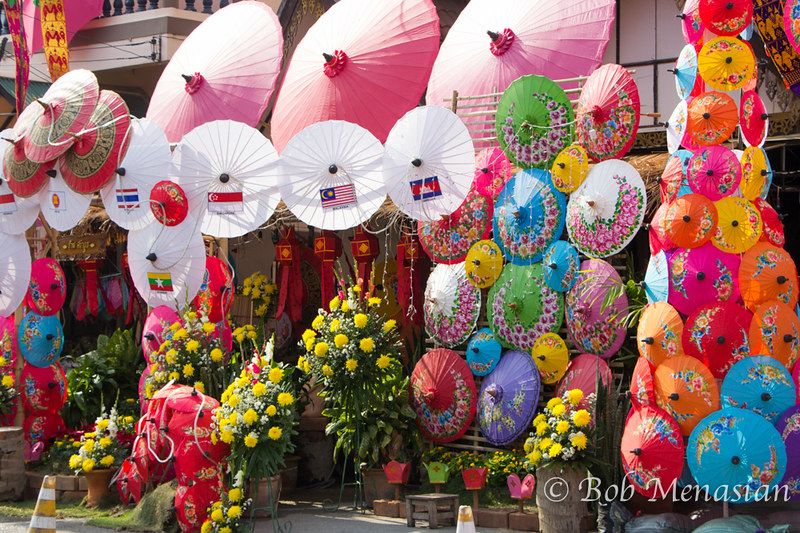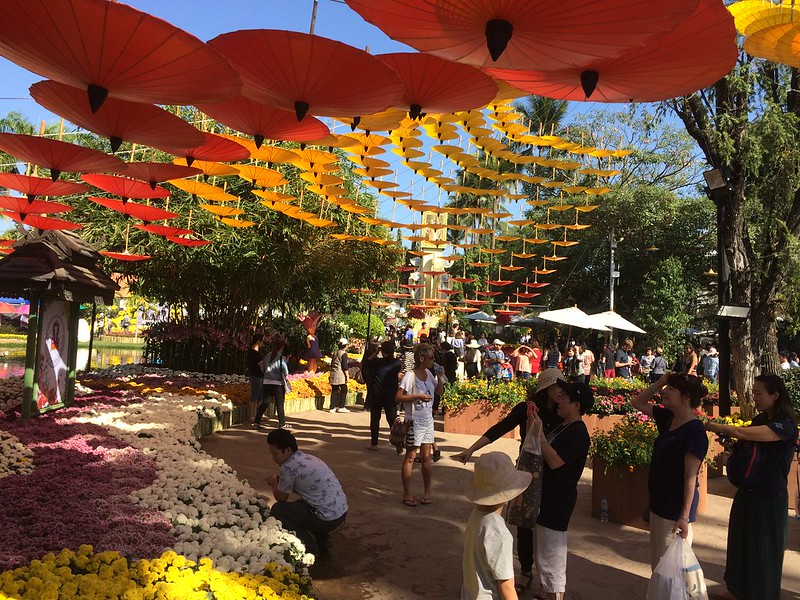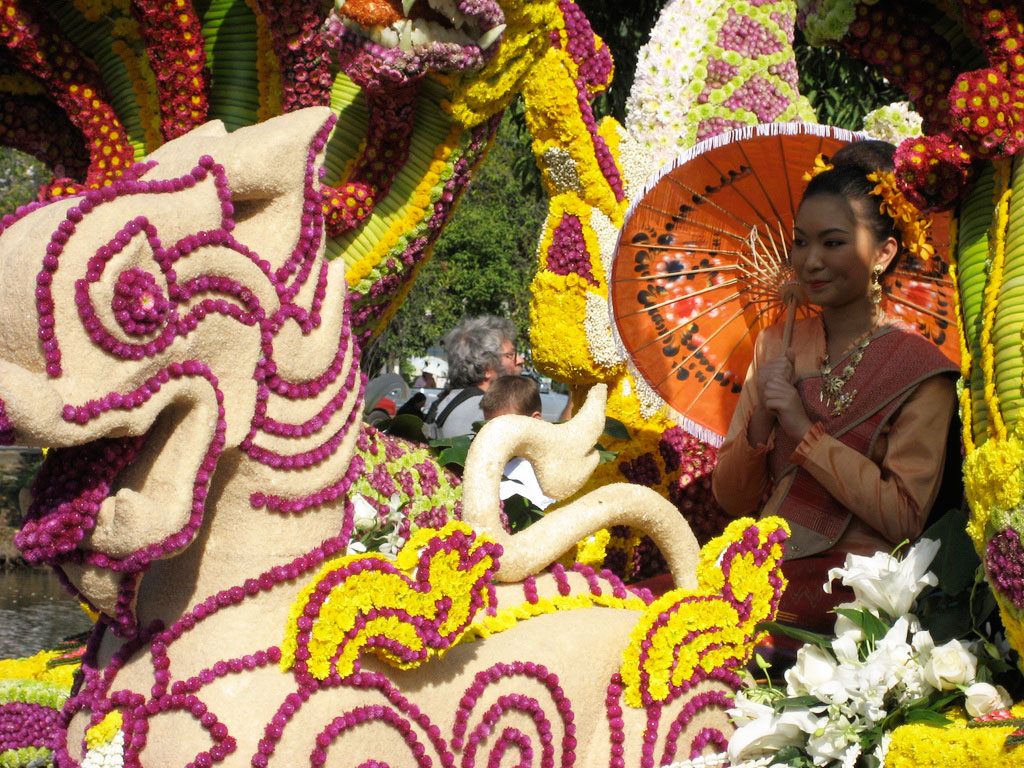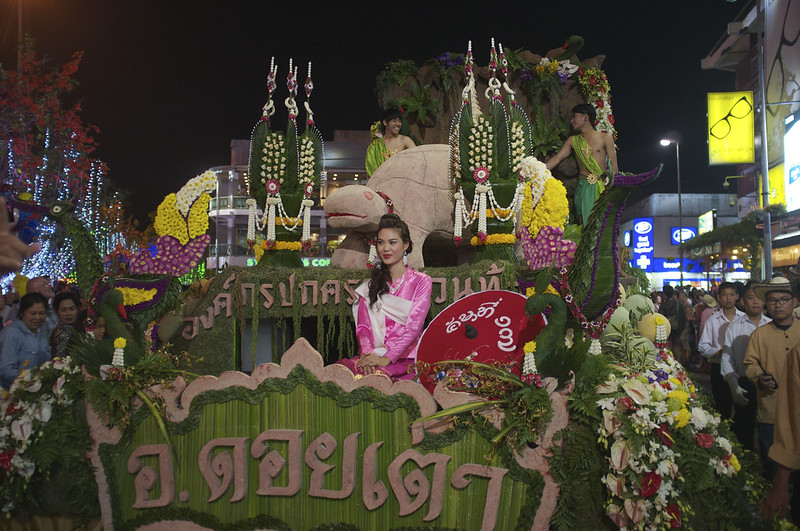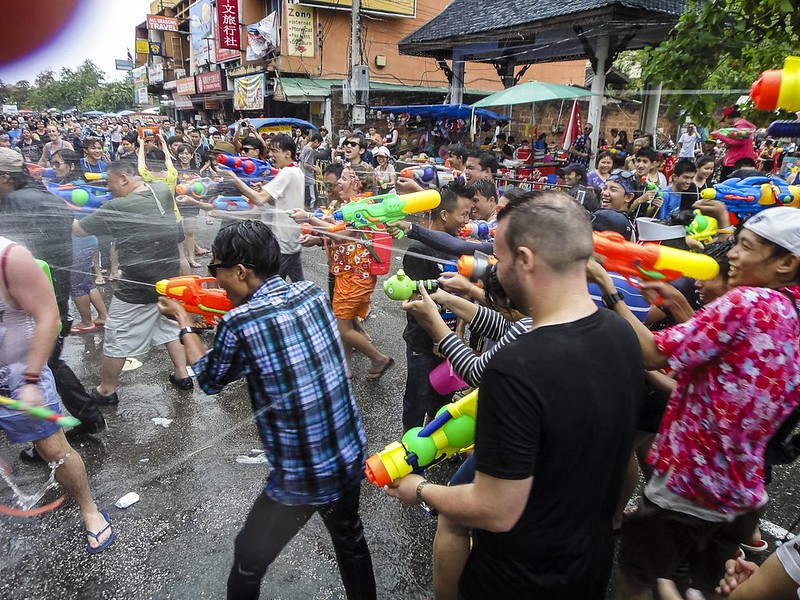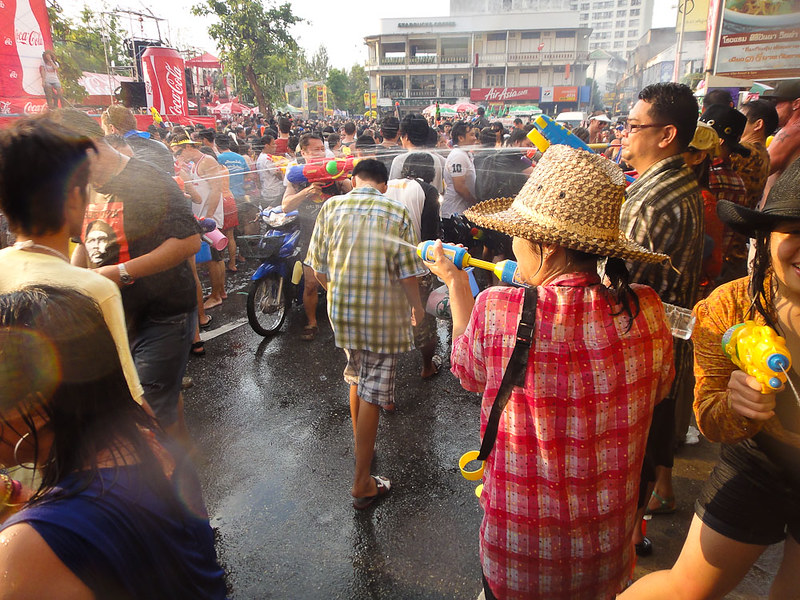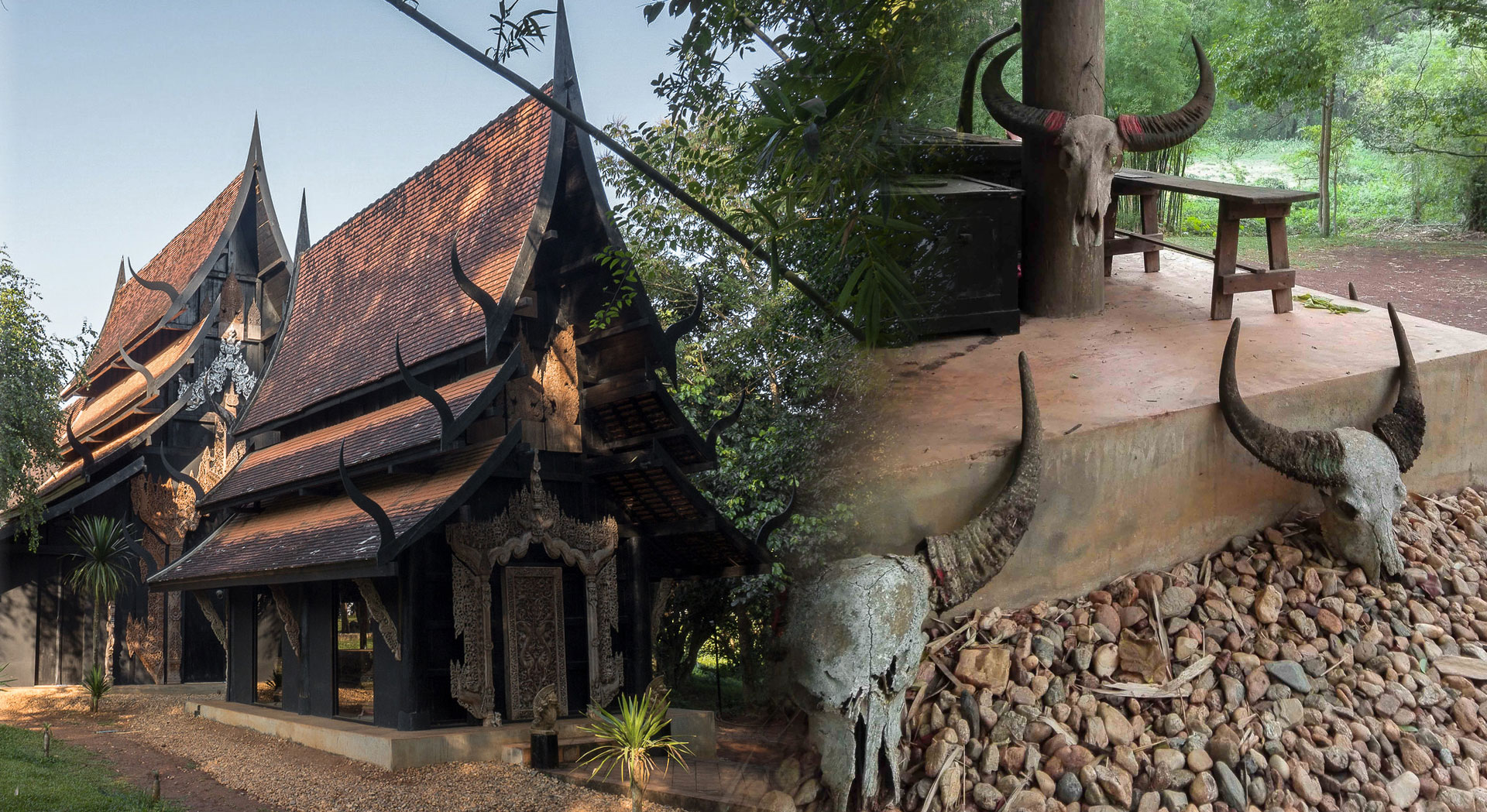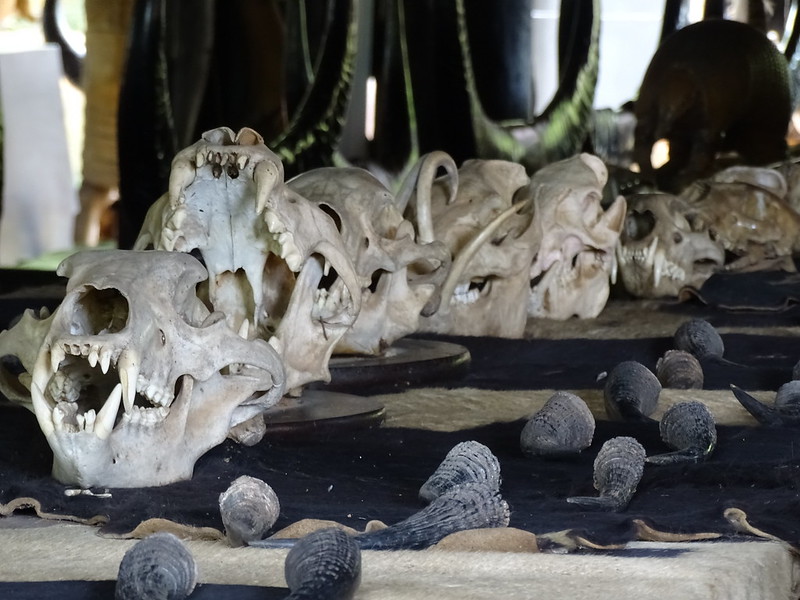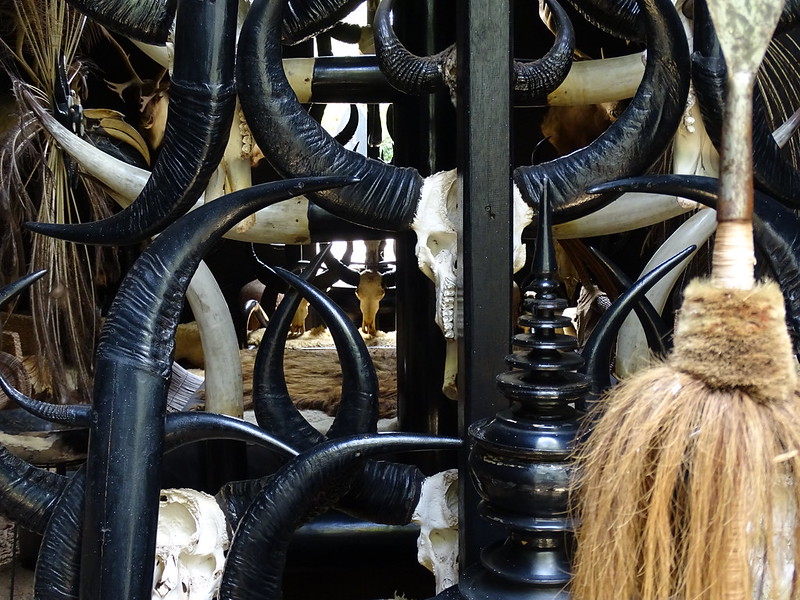The ancient town of Ayutthaya
The town of Ayutthaya is a great place to visit for a few days if you feel like resting from the nonstop buzz of Bangkok.
Ayutthaya is a small town surrounded by three rivers and it once was the state capital of the Kingdom of Thailand, only a 76 km train ride away from Bangkok.
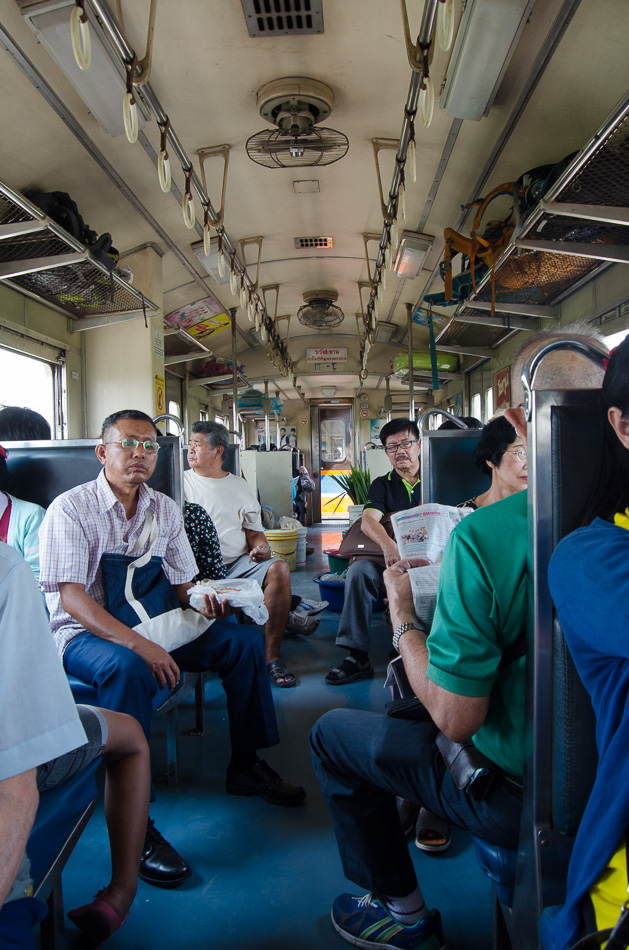
It’s a picturesque 1.5-hour train ride that only costs 15THB in 3rd class, on an old train filled with Thais of all ages. The train passes through sugarcane fields, small villages, temples, rice paddies, and plains.
Being dry season we got to do the entire trip with windows opened, feeling the breeze in our faces, smelling the dust from the land, and listening to birdsongs. We reached Ayutthaya painted in black freckles from the dust.
If you need a snack during the trip, there will be enough vendors with food and drinks to sell at every stop. Some inside the train and others from the outside, through the windows.
As soon as we got to Ayutthaya train station, a flock of tuk-tuk drivers started touting to every tourist in sight, including us.
– Sir, Tuk-tuk? Where are you from? Where are you going?
From the train station to the city
To get into town, you need to cross the bridge or get a boat (4THB).
Stubbornly, we decided to decline every tuk-tuk offer, taxi, and boat crossing opportunity, and did it all by foot, carrying 4 backpacks under intense heat, at 12:00 PM. Did we mention the dry season? Yeah.
We ended up walking for 40 minutes until we found our hostel: One Baan Love.
Ayutthaya Temples entrance fee (2023)
Even though it is free to enter the Historical Park, there’s an entrance fee at almost every temple in Ayutthaya. So the alternatives are: buying a full ticket for 220 Bahts that grants you access to 6 temples:
• Wat Phra Si Sanphet,
• Wat Chai Wattanaram,
• Wat Phanan Choeng,
• Wat Phra Mahathat
• Wat Ratburana
Or you can pay 20 to 50 Bahts at the entrance of each temple.
We decided not to buy the full ticket and chose the ones we wanted to get in.
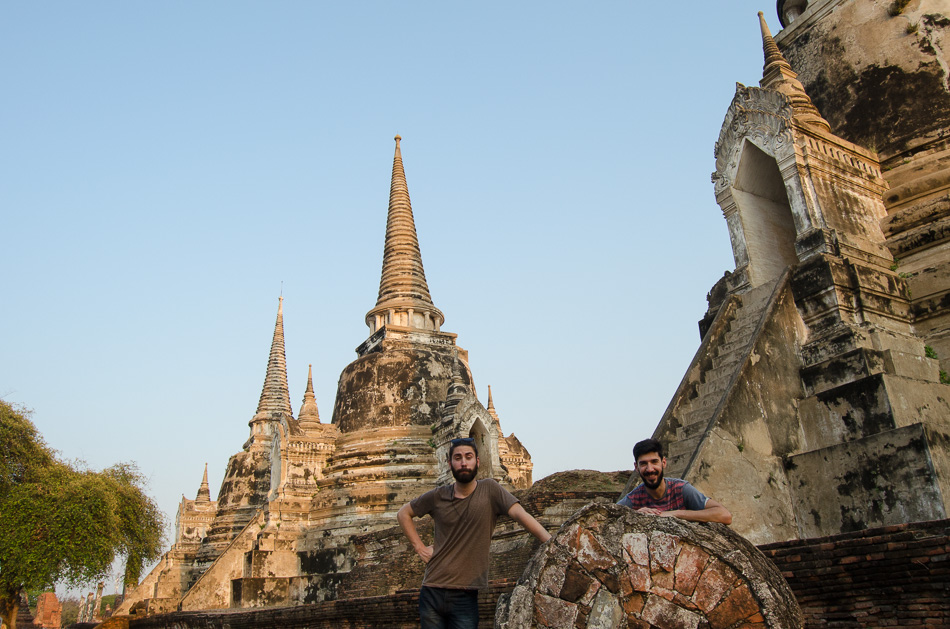
As in any other Buddhist temple, you’ll need to dress appropriately: no daisy dukes, bikini tops, or bare shoulders. Ladies, you should wear something appropriate as well.
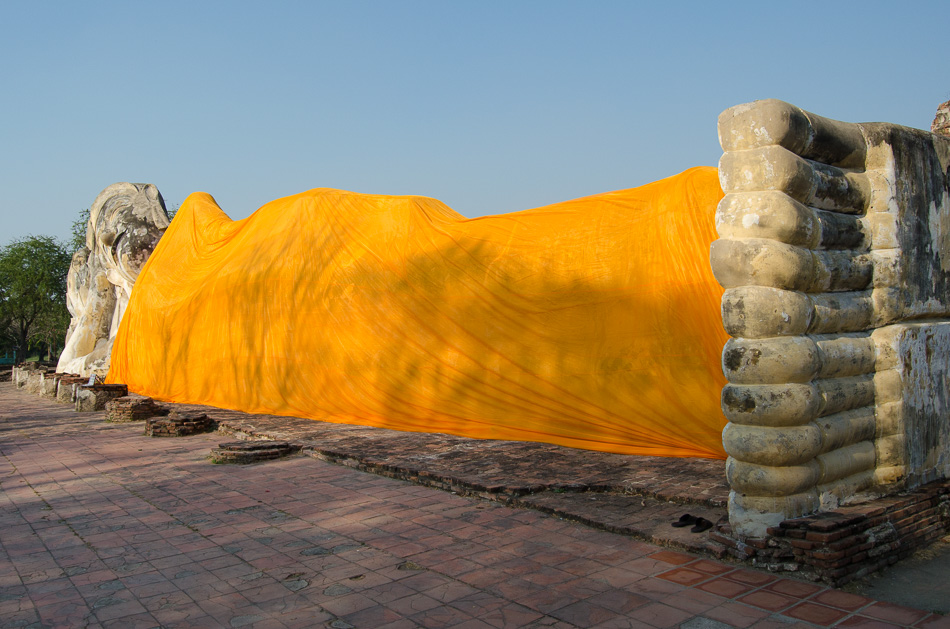
All temples open for visits at 8 AM, some of them close at 4:30 PM, others at 6 PM.
Tip: if you want to enjoy some of the temples for yourself, visit them at launch hours (12:00 PM to 2:30 PM). Wear sunscreen.
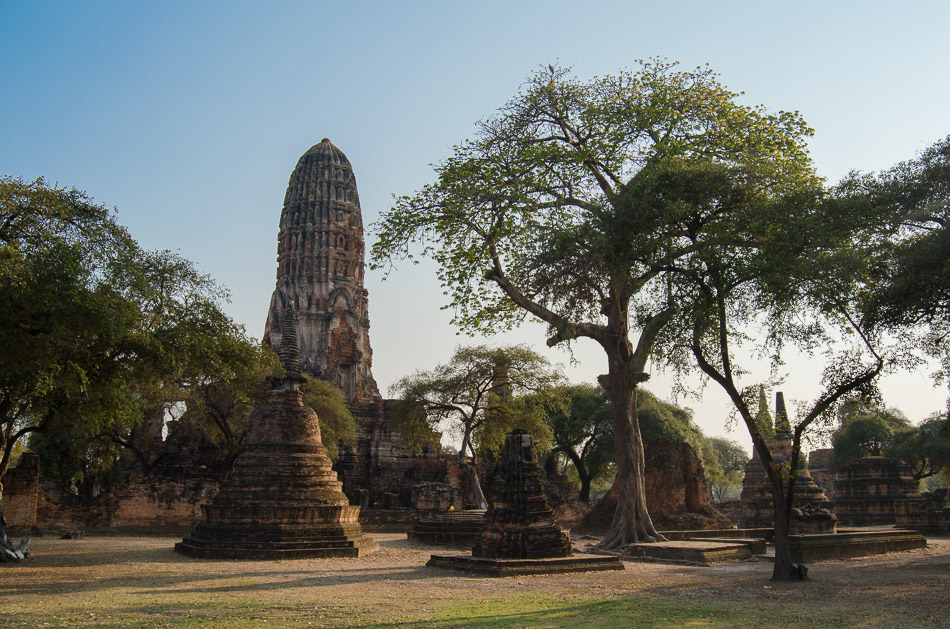
The temples are designed in Khmer style and most of them are in really bad shape, mainly because of the Burmese destruction back in the day: Buddha sculptures were beheaded and many stones were stolen.
Regardless of all that, the ruins of the ancient town of Ayutthaya are impressive!
You can understand their original size and architectural detail in the mockups at the entrances.
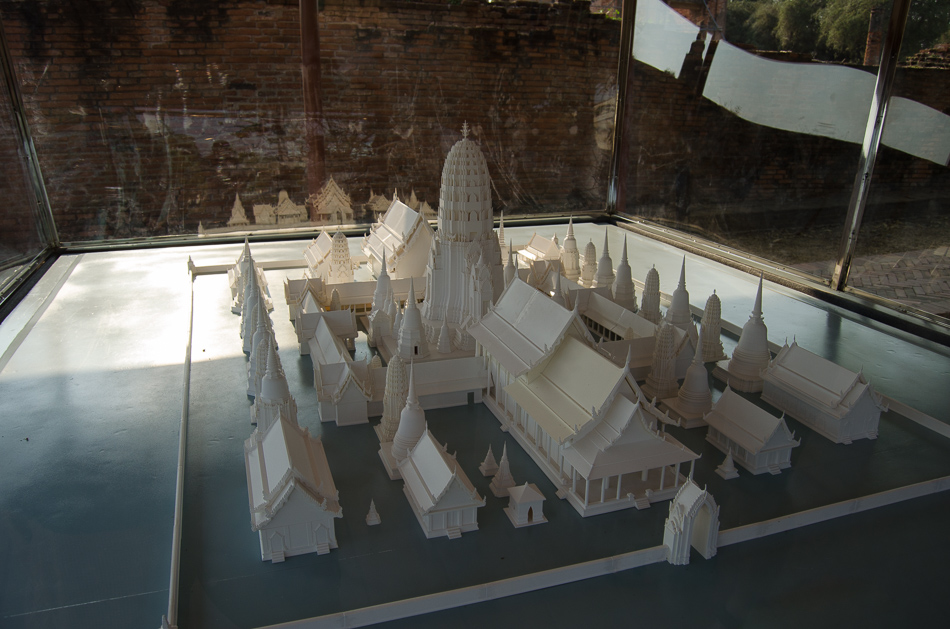
Some of the sites were under conservation and restoration work to repair the damages caused by the floods in recent years.
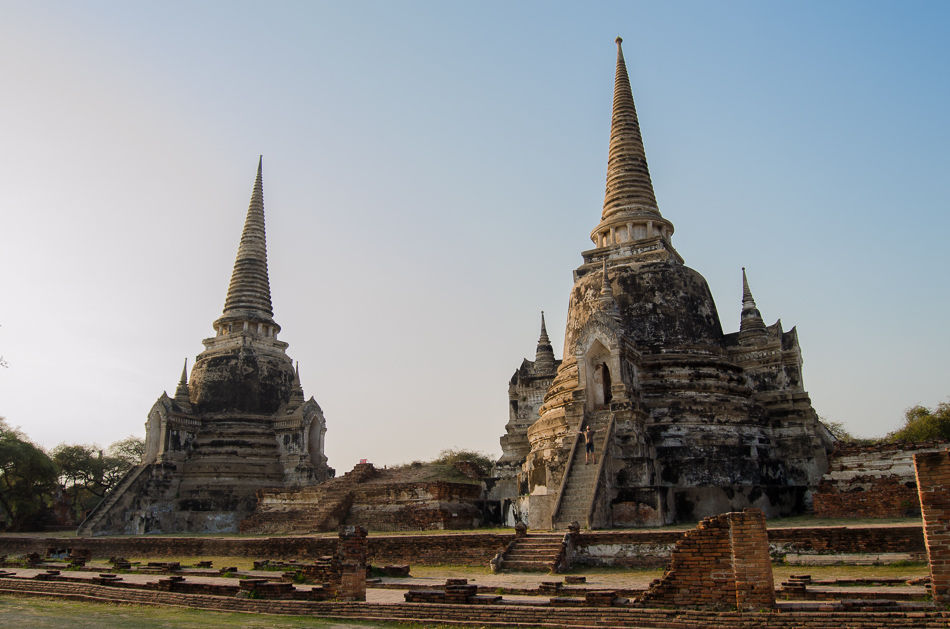
The temples are solid and tower-like, so even though you can climb the stairs on some, you cannot go inside. Also, some stupas are closed to the public. We were only able to visit the stupa of Wat Phu Khao Thong.
In two days we managed to visit:
• Wat Choeng Tha
• Wat Phu Khao Thong
• Wat Na Phra Men
• Wat Lokayasutharam
• Wat Thammikarat
• Wat Phra Si Sanphet
• Wat Chai Wattanaram
• Wat Ratburana
And left a whole lot to see.
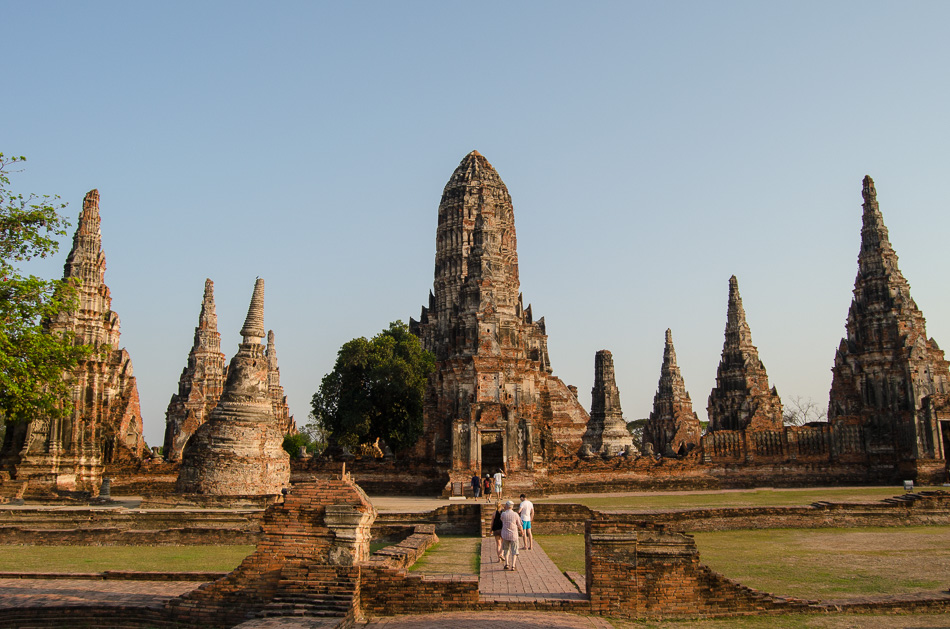
Looking back, we should’ve spent more than 2 days in Ayutthaya. The sunsets at Wat Chaiwatthanaram are incredible and we wouldn’t mind the opportunity to see one more.
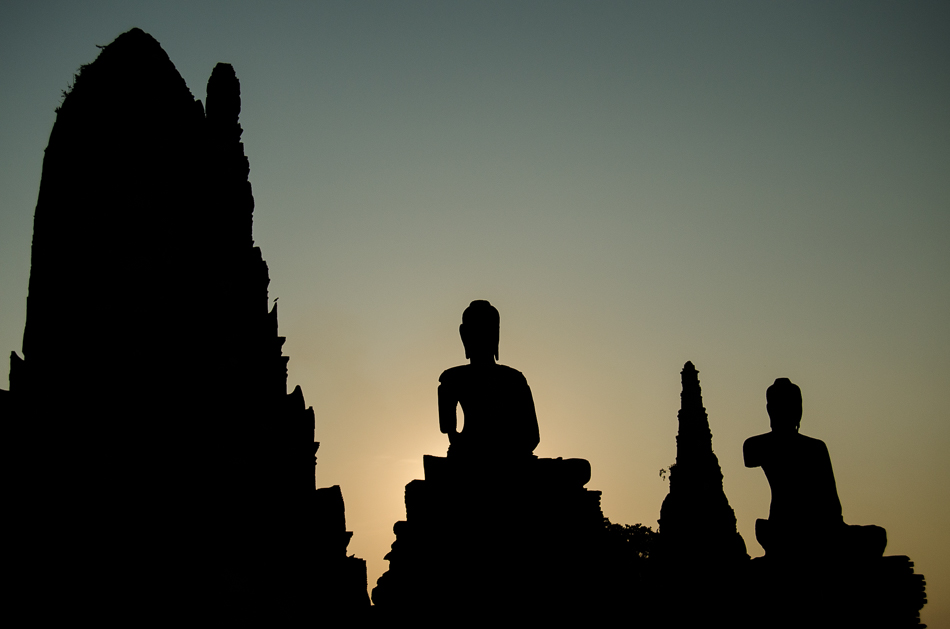
Riding a bicycle around town
The majority of the temples are in the central part of town, so to reach the further temples, we rented 2 bicycles for 40THB each.
P.S- You can find even cheaper bikes if you rent them out of the city center.
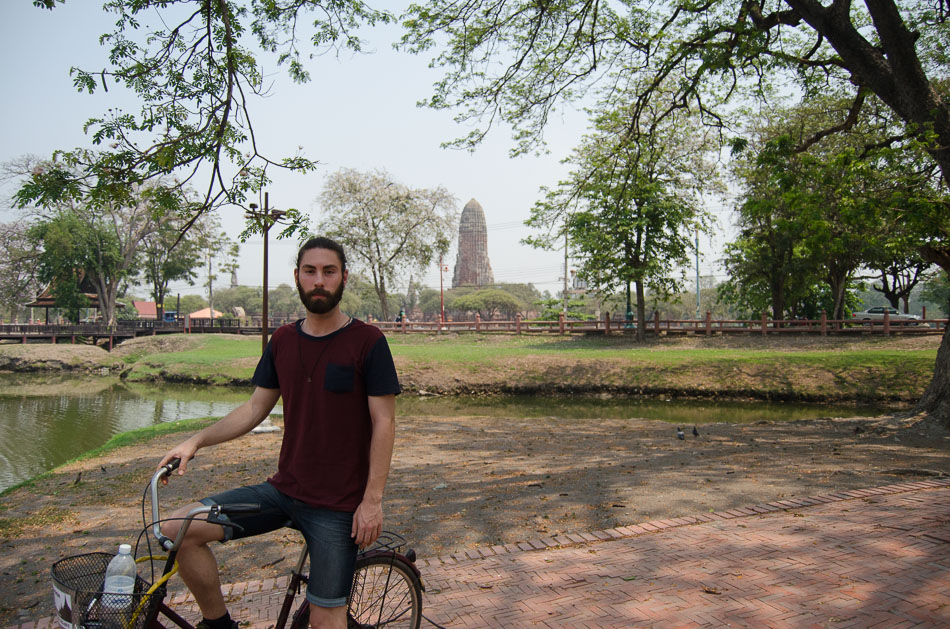
Is fairly easy to rent a bicycle anywhere in Southeast Asia, plus the flat terrains and the great weather makes them the best affordable choice to move around.
Ayutthaya, being way less popular than Bangkok is also less touristy
There is less accommodation to choose from and a bit more expensive than the capital. Restaurants do not abound, especially if you come from the jumble of street food in Bangkok—but prices are quite similar. If you get out of the temple area, you can have a good meal for 35THB.
A post shared by Mario and Nuno | Travel (@helloplanetgravy) on
In our quest to find food, we crashed a local graduation party in an open sports field packed with food stalls and teenagers. We were hungry and new in town. Don’t judge.
While we were waiting in line to get food, some locals approached us and asked to take some photos with them. Maybe the sight of two tall, bearded dudes in the middle of a high school graduation party seemed funny to them.
Speaking of locals
All the interactions we had were kind and genuine without the ulterior motives you can’t help to feel in Bangkok.
Also in several places, we found warnings about stray dogs that like to jump at people. We never had any problems, probably because our legs are too skinny for them to bother.
If you must, use your tourist sword to scare them away — a selfie-stick can be a powerful weapon — use it wisely.
Ayutthaya travel expenses (daily average for 1 person)
Breakfast: € 2,06
Meals: € 1,35
Water: € 0,20
Hotel: € 9€ (Private double room)
Bicycle rent: € 0,64
Train: € 0,58 (Two way trip to Bangkok)
If you have any questions or some extra info everybody can benefit from, please leave it down in the comments!
Bangkok Travel Bible - The Perfect 5 Day Guide (Day 02)
Welcome to day two of our Bangkok travel guide.
In case you didn’t know, Nuno and I created a complete itinerary for Bangkok, divided it into 5 parts, and organized it by days to make it easier to process. Each itinerary is sequentially planned with all locations mapped in the most convenient order. And you can sort the days as you want.
This is day two. ✌️
If you already finished your second day, here’s day one, day three, and day four.
Something to have in mind:
As the day-two itinerary includes the Chatuchak Weekend Market, it’s better if you’re doing it on a Saturday or Sunday. If that’s not possible, don’t sweat it, we got you covered: there are 2 museum visits to fill the hole.
Bangkok Itinerary Map for Day 2
(All spots for day 2 are marked by yellow pins).
Chatuchak Weekend Market
Chatuchak Weekend Market is one of the biggest and most popular markets in Bangkok. Its sheer size and hecticness can put to test the sense of direction of any scout. The market is organized and divided by countless corridors that spread from the central square.
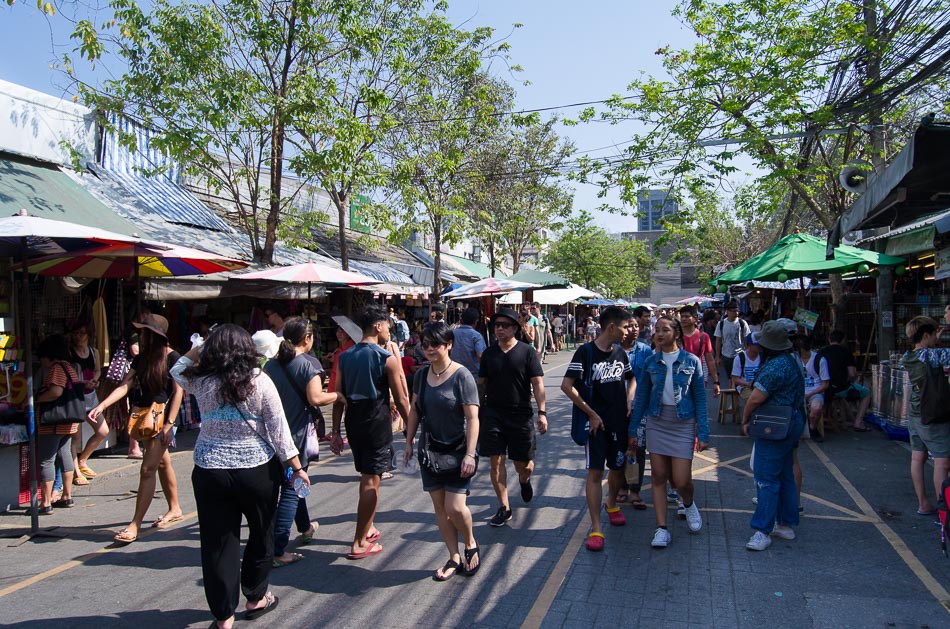

Even though you can find anything here, you will not always find it at the best prices. Regardless, Chatuchak is a great place to visit.
Opening hours
It opens on Saturdays and Sundays from 9 am to 6 pm and on Fridays from 6 pm to 12 am You’ll need at least half a day to see it. We recommend going in the morning and have lunch there.
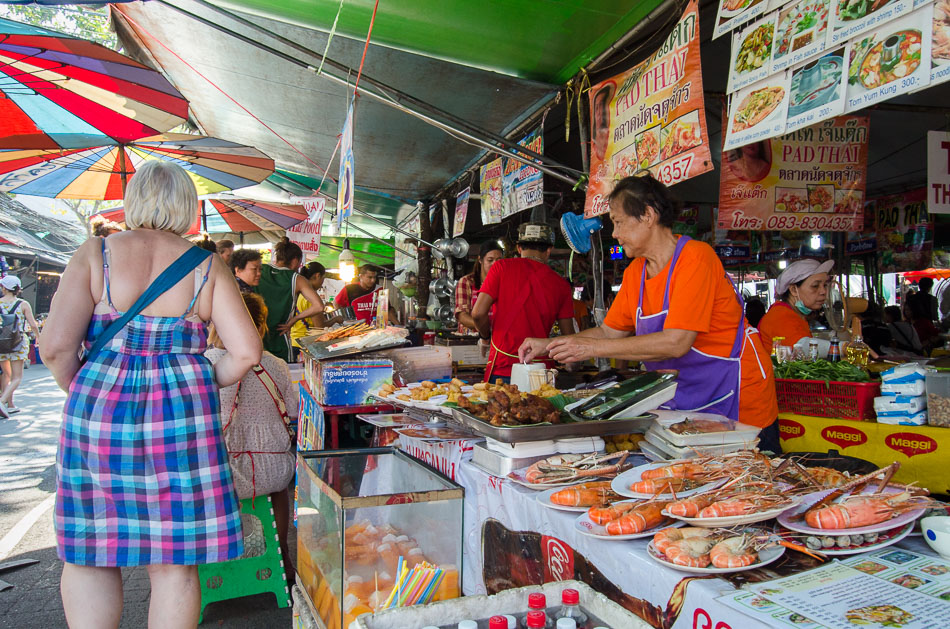
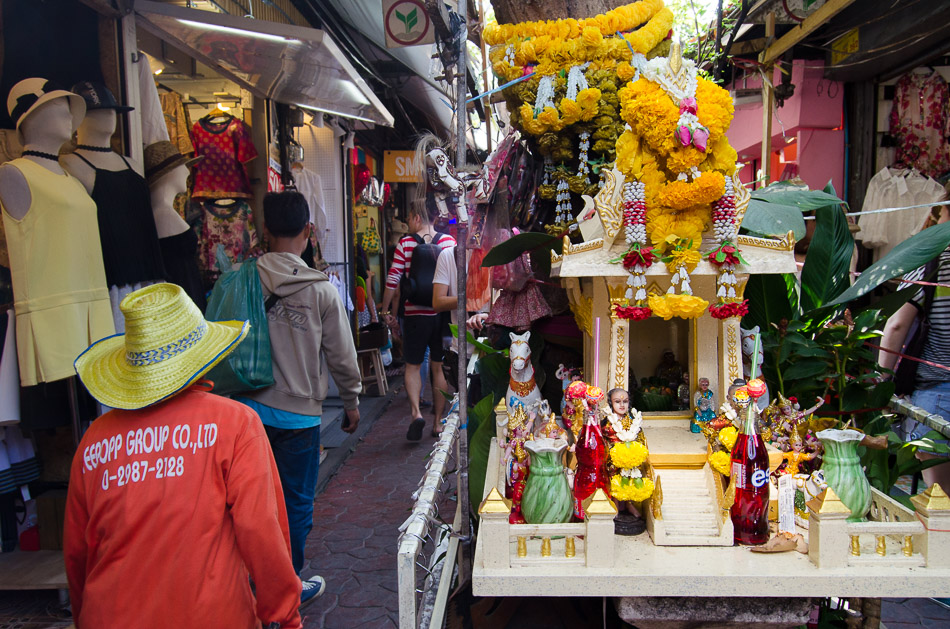
Transport to Bangkok’s Chatuchak Market
🛺 Tuk-tuk
A Tuk-tuk from downtown Bangkok will cost 50 Bahts per person.
🚝 Skytrain
You can take the Skytrain (BTS) to Mo Chit station. Leaving at exit Nº1 you’ll find the market easily. Tickets cost 59 baht.
🚇 MRT
Or the MRT (Bangkok Metropolitan Rapid Transit) and get off at Chatuchak Park, but it’s better if you do so at Kamphaeng Phet Station. Leave the station through exit nº2, and you’ll exit directly into Chatuchak Weekend Market. Tickets cost 42 baht.
Alternative museums for weekdays in the morning
If you’re doing the second day of the itinerary on a weekday, we suggest the following museums as an alternative for the morning:
Bangkok National Museum
A great museum to learn about Thailand’s history from the Sukhothai kingdom up to the present day. You’ll find collections of decorative textiles, weapons, precious stones, gold objects, masks, musical instruments, etc.
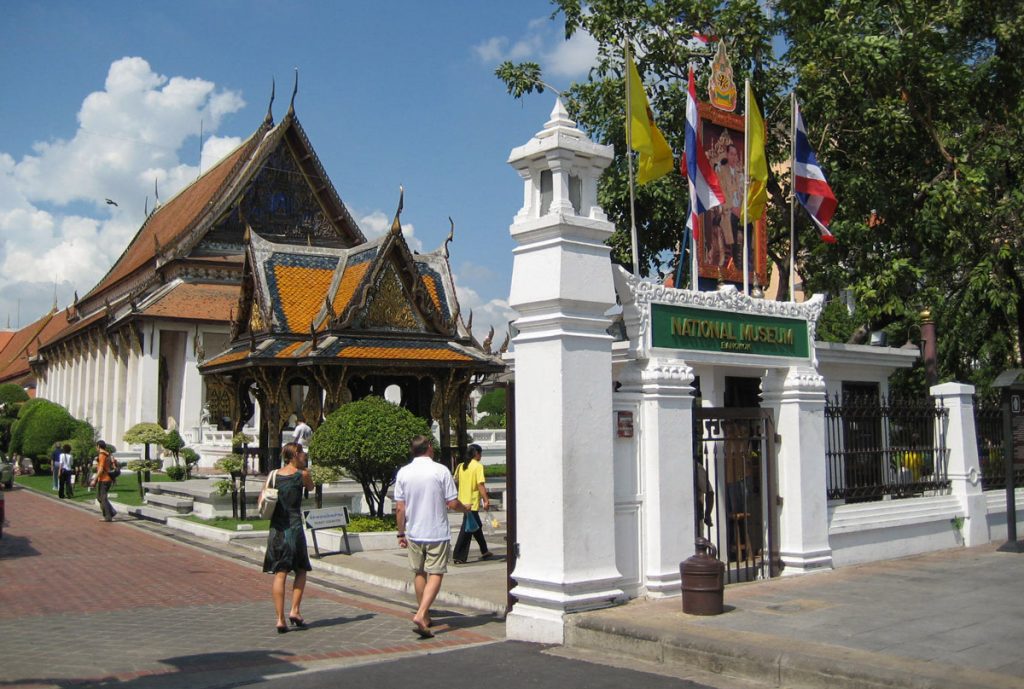
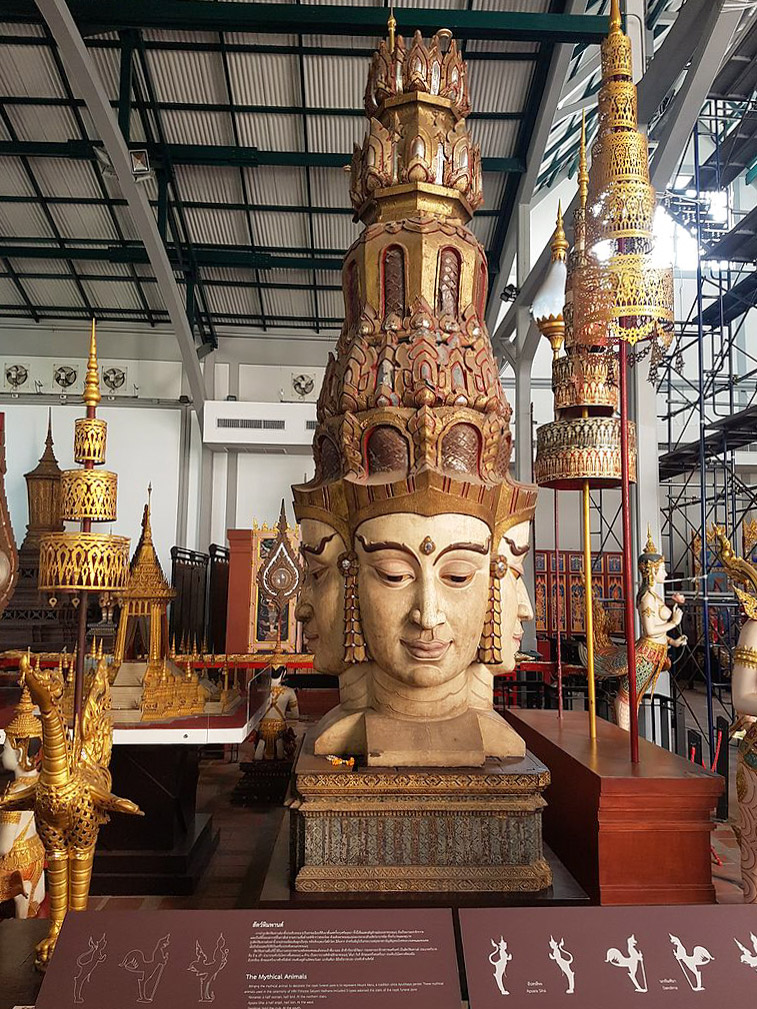
Opening Hours
Opens Wednesday to Sunday from 9 am to 4 pm.
Museum Ticket fees
Tickets cost 200 baht.
For 350 baht you can have a combo ticket that gives you entry to the National Gallery and the National Museum of Royal Barges as well.
🚌 Buses to the National Museum
Nº 3, 6, 9, 15, 19, 30, 32, 33, 39, 43, 47, 53, 59, 60, 65, 70, 80, 82, 91,123, 201 and 203.
To find out which bus is the most convenient for you, go to www.rome2rio/Bangkok and enter your starting point.
Royal Barges Museum
This museum is a boathouse where you get to see up close a collection of the most beautiful barges used by the royalty on special trips and ceremonies from the kingdom of Ayutthaya to the present day.

Location and opening hours
The museum opens daily from 9 am until 5 pm and is located on Khlong Bangkok Noi (near Phra Pin Klao Bridge).
Ticket fees
The entrance fee to the museum is 100 baht plus 100 extra if you want to take pictures, or 200 if you want to make a video.
Transport to the Royal Barges Museum
You can get to the museum by Chao Phraya Express Boat and stop at the Wang Lang Pier (Stop nº10). Ticket fares depend on the distance and start at 9 baht up to 20 baht.
Dusit Palace
In the afternoon you can visit the Dusit Palace, a European-inspired royal palace built by King Rama V. The palace complex consists of several impressive buildings, such as the white marble palace Ananta Samagom Throne Hall, and the Vimanmek Mansion that was converted into a museum.
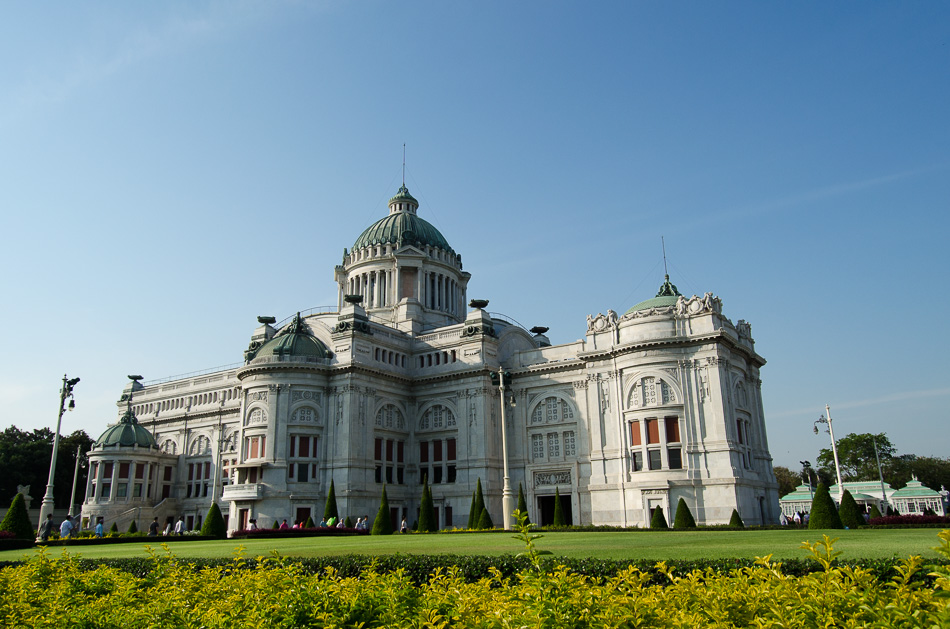
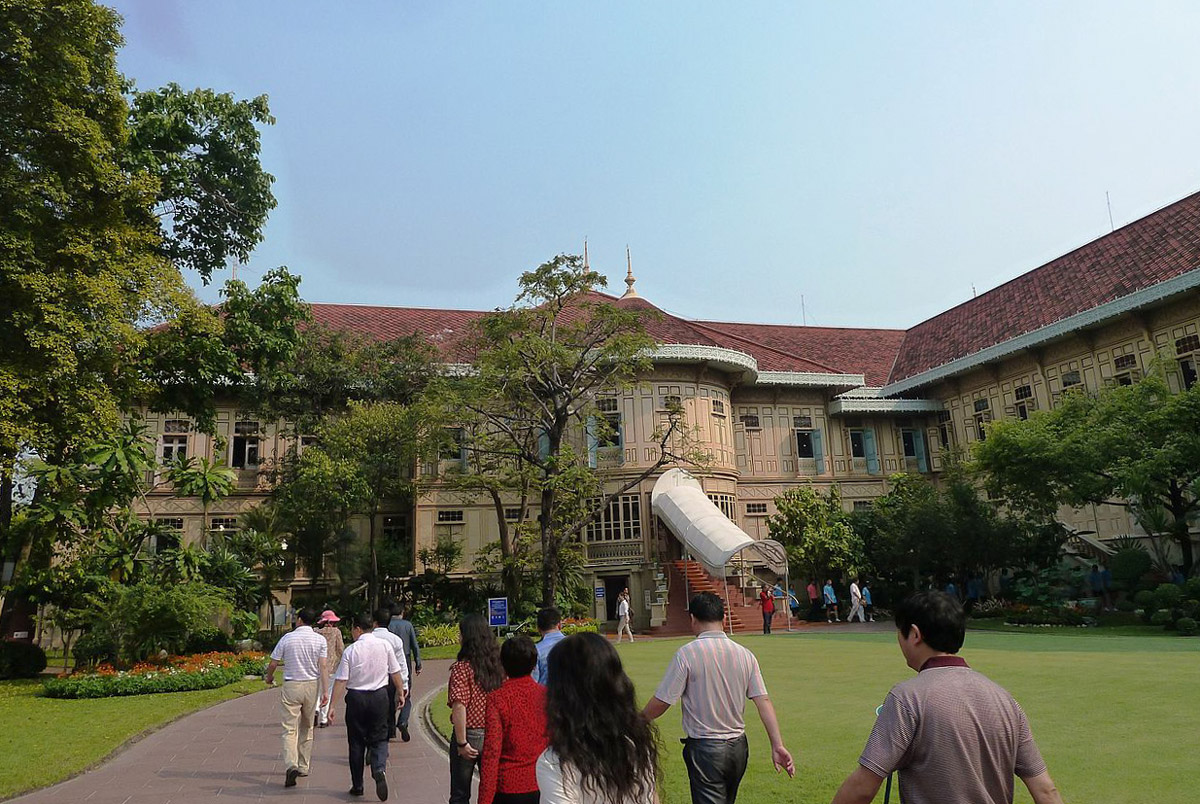
⚠️ Under restoration
There’s a lack of information regarding the completion date of the works.
But we’ll keep you posted as soon as it reopens to the public.
Wat Benchamabophit (Marble Temple)
Visiting Wat Benchamabophit was a magical moment that Nuno and I still talk about today. We arrived at the temple in the late afternoon, just at the perfect time. The complex was almost empty (something very uncommon in Bangkok). The marble floor was warm after a beautiful sunny day and the only thing we could hear were the monks’ prayers echoing through the atrium.
Opening hours
Opens from 8 am to 5 pm and there’s no entry fee.
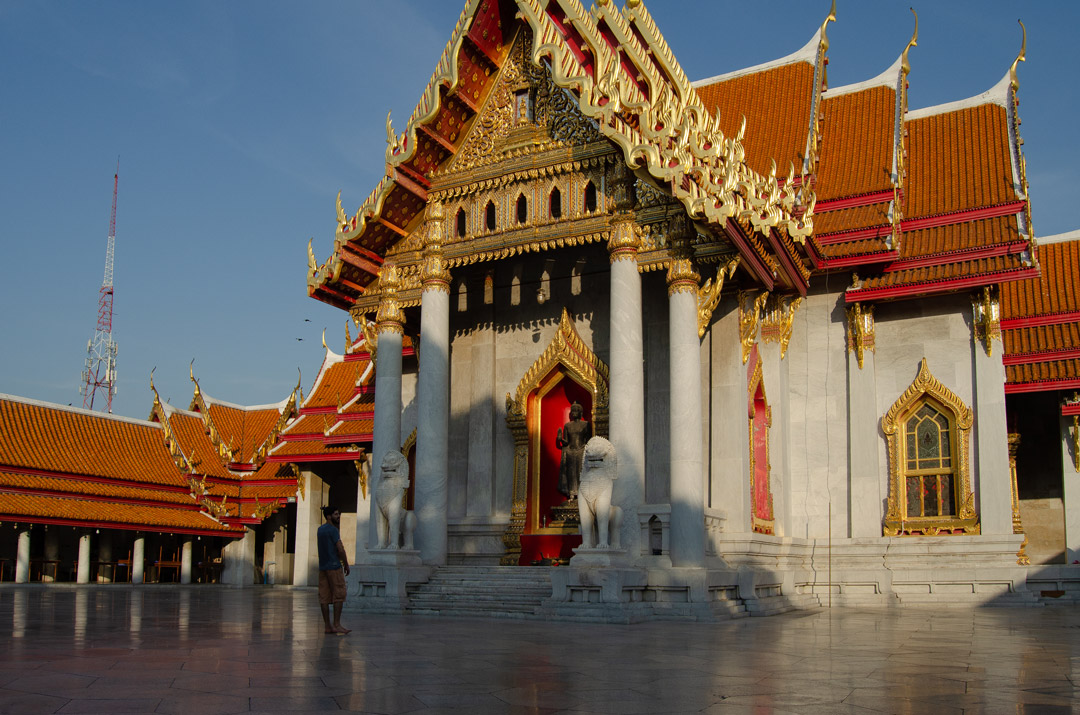
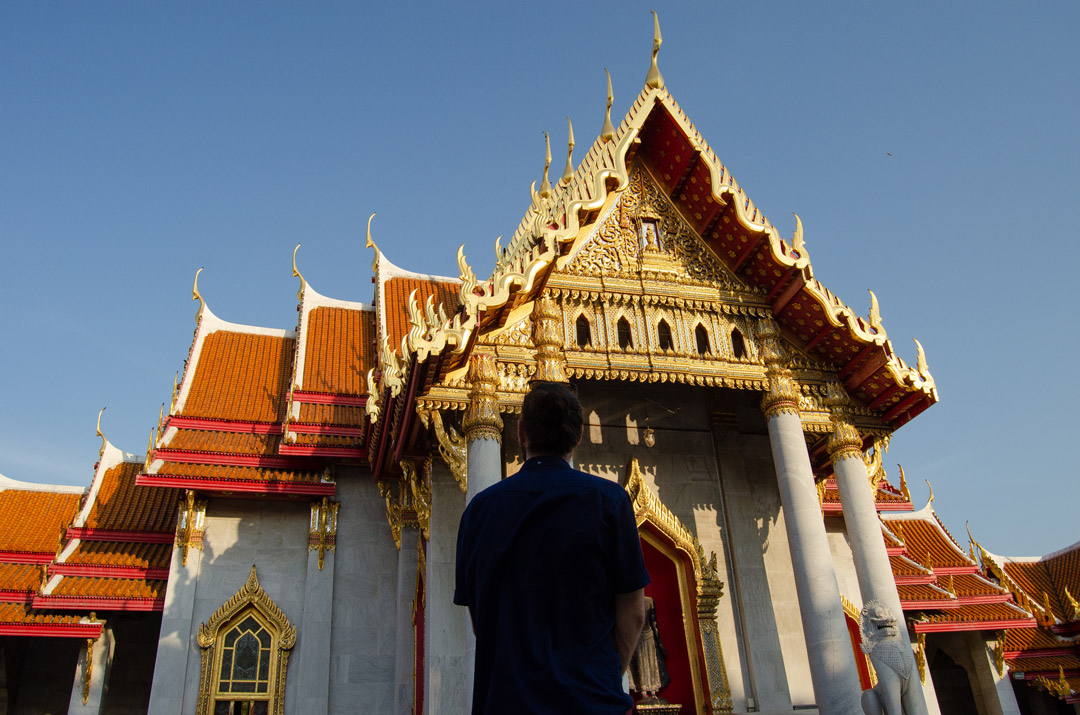
Nang Loeng Market
About a 15 minute walk south of the Marble Temple you can find the Nang Loeng Market – one of the oldest markets in the city. This is a great spot to sample many Thai cuisine specialties.
Have in mind that many stalls close in the late afternoon and some on Sundays.
Wat Intharawihan
Since we arrived in Bangkok, all Tuk-tuks drivers we came across kept insisting on taking us to this temple. So much so that it sparked our interest.
After walking 20 minutes from the Marble Temple, you can also end your day visiting Wat Intharawihan (the big standing Buddha). It stands out from the other temples due to the 32 meter Buddha statue in the atrium.
Opening hours
The temple is open from 8 am until 8 pm and is located on Wisut Kasat Road, at the beginning of the Rama VIII Bridge. There’s no entry fee.
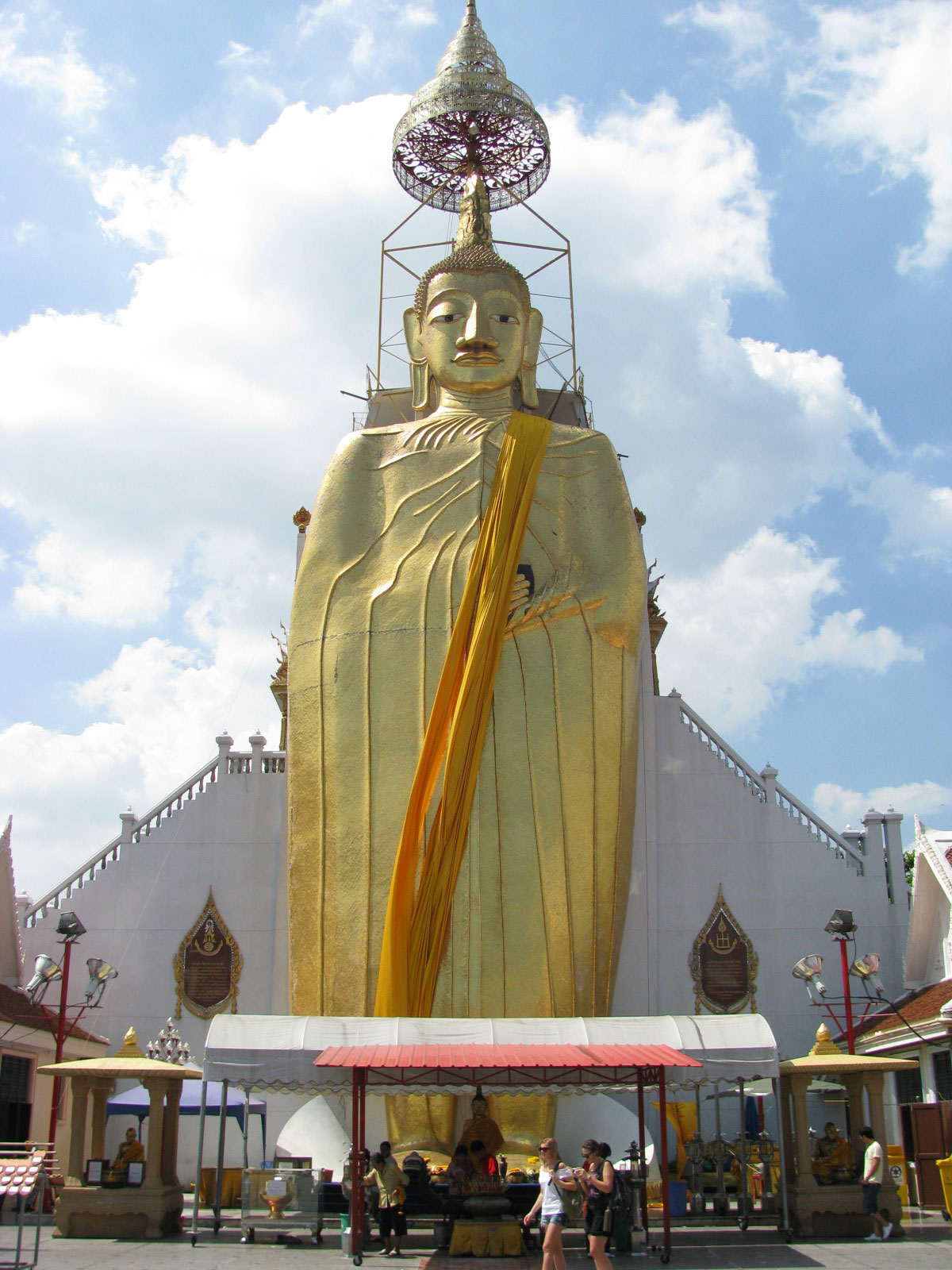

If you want to keep going, check day one, day three, and day four.
Bangkok Travel Bible - The Perfect 5 Day Guide (Day 01)
For some time now, Nuno and I wanted to create an itinerary with all the essentials of Bangkok.
With that in mind, we created a Bangkok Travel Guide, divided it into 5 parts, and organized it by days to make it easier to digest. The order in which you start is up to you, and if you don’t have 5 days to visit Bangkok, just pick the days that best suit your traveler profile.
Each day of the itinerary is sequentially planned with all locations mapped in the most convenient order for you. We’ve considered the time it’ll take you to visit each site, as well as moving within the city from point A to point B. Oh, and we’ve also included launch breaks and suggestions of places to eat. It’s all covered.
Welcome to day one. Let’s do this! ✊
(And if you’ve already finished your first day, here’s the day two, day three, and day four).
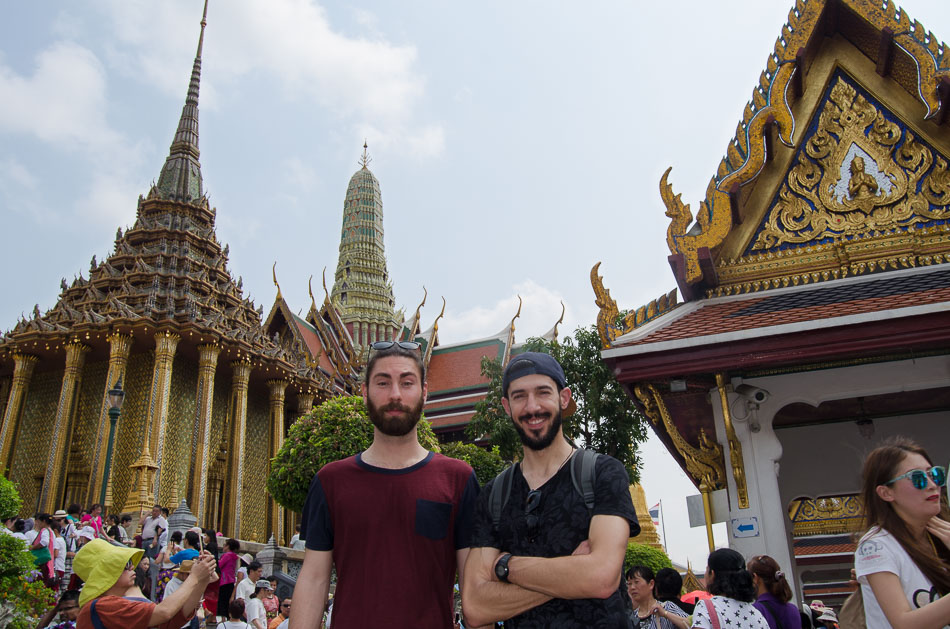
Bangkok Itinerary Map for Day 1 | The temple day
(All spots for day 2 are marked by dark blue pins).
Grand Palace and Wat Phra Keaw
Entrance fee
Tickets cost 500 baht.
If you don’t want to waste time in queues, buy your tickets online at www.royalgrandpalace.th/buy-ticket
Opening hours
The Grand Palace opening hours are 8:30 to 15:30.
We encourage you to wake up early and to be there in the first hour of the morning. Being a very popular site, be prepared to encounter a lot of people at the entrance — and we’re not just talking about tourists. Swindlers love to hang right outside the palace like vultures flying over a carcass. We still remember being approached several times by people telling us the palace was closed for foreigners that day (lie), or that we had to buy special clothes otherwise we wouldn’t be allowed in (half-truth).
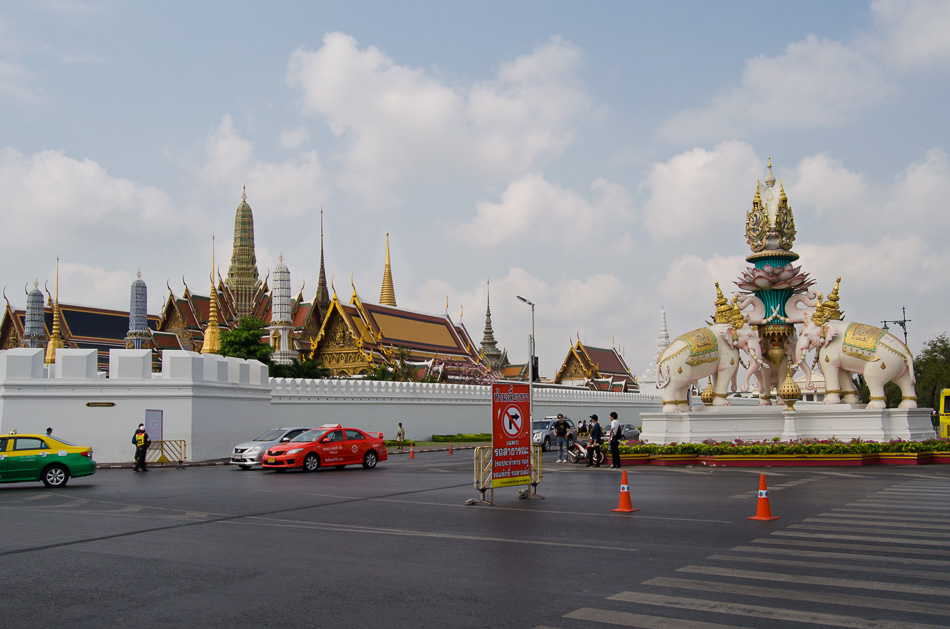
As the Grand Palace and Wat Phra Keaw are considered sacred, all visitors must dress according to the stipulated rules: trousers or long shorts, and no sleeveless t-shirts. If the staff members consider you’re revealing more than you should, you’ll be guided to a booth near the entrance that will lend you the appropriate cover-up. The lending service is included in the ticket price.
⏲️ A proper visit will take you at least 2 hours.
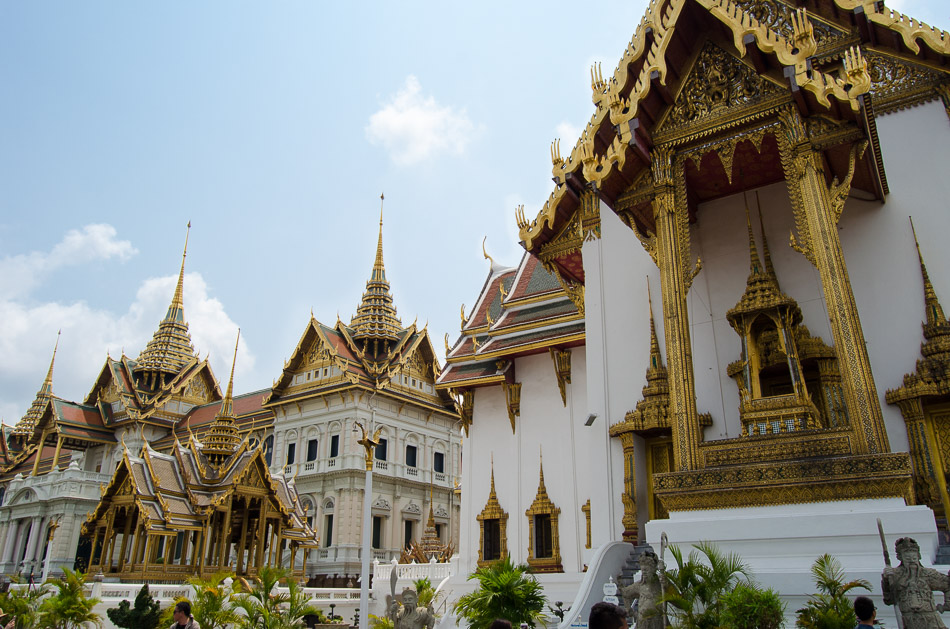
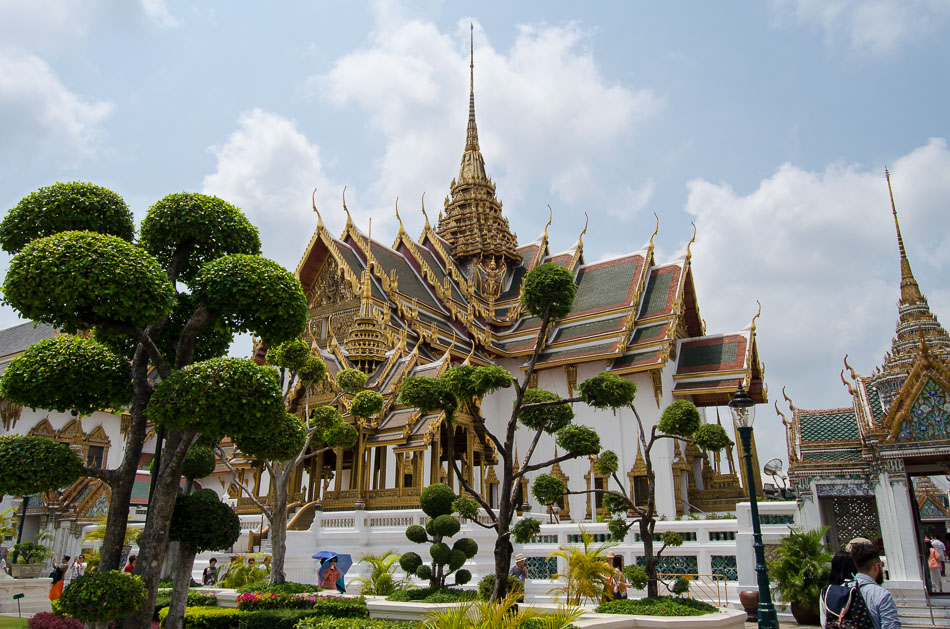
Lak Mueang
Near Wat Phra Kaew is a shrine called Lak Mueang that represents the guardian spirit of the city. Inside is the foundation pillar raised in 1782 when King Rama I established Bangkok as the capital of Thailand.
Thai people come here regularly to leave offerings and to pray. Traditional Thai dances are performed daily and are free to watch.
Lak Mueang is open from 6:30 until 18:30.
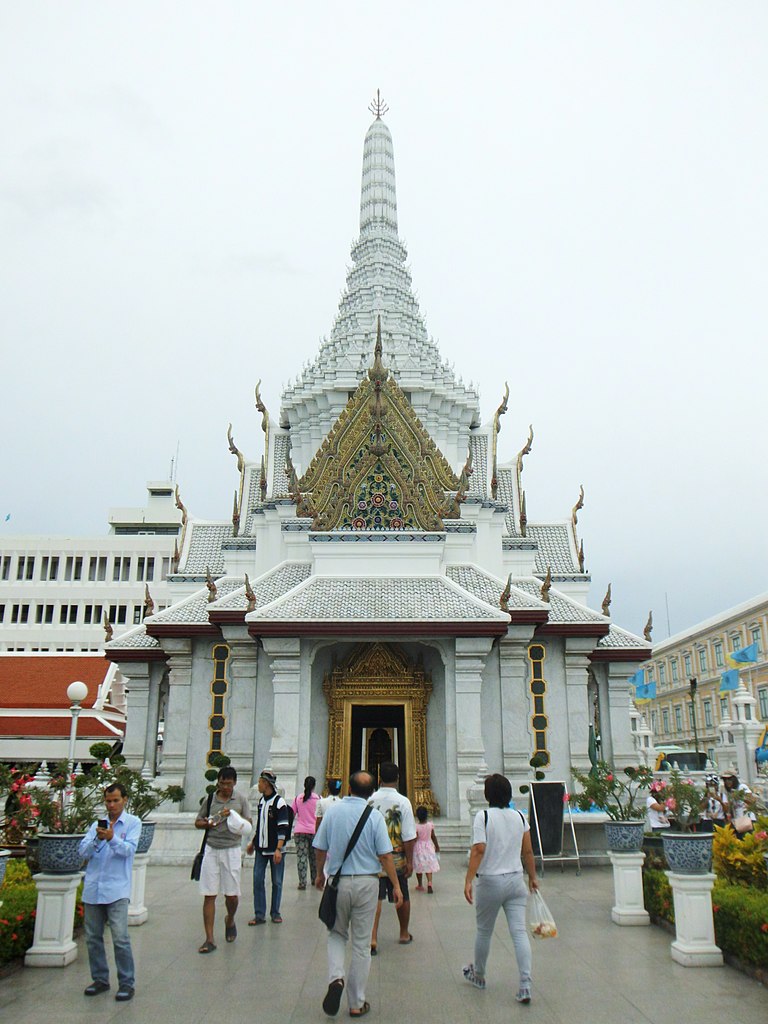
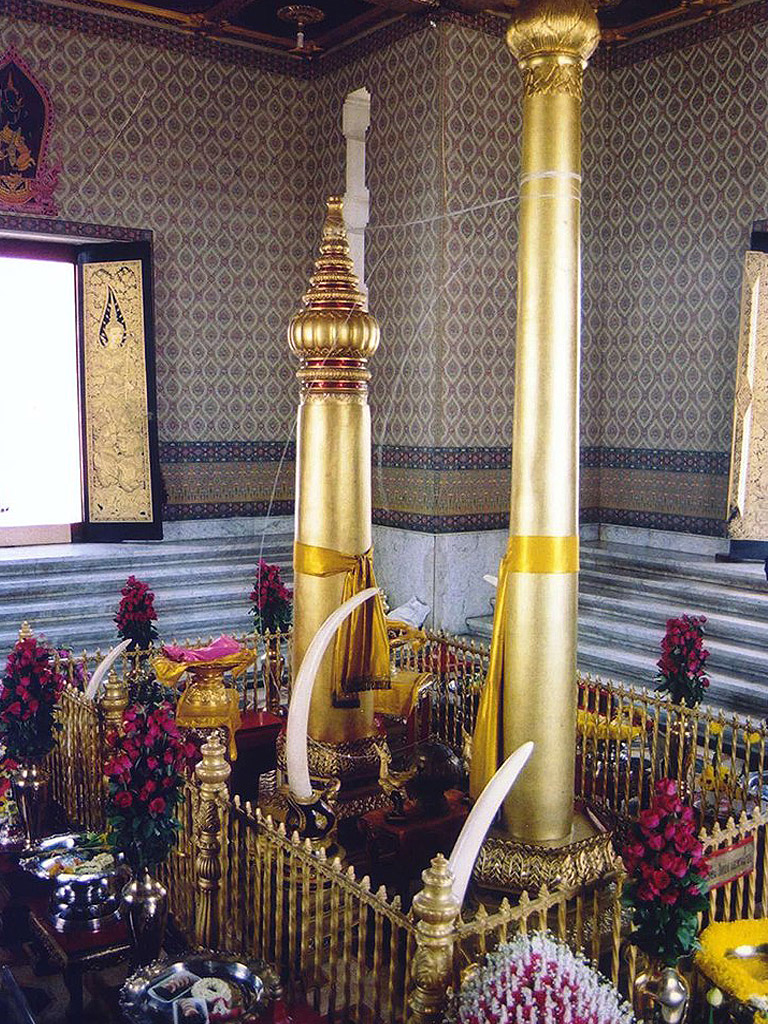
Wat Ratchabophit
With a typical Thai exterior reminiscent of the Grand Palace, this temple has an interior with clear European influences similar to a gothic cathedral. Here, are also stored the ashes of several members of Thai royalty.
It’s open from 9:00 to 18:00 and free to enter.
Wat Ratchapradit
A very beautiful temple close to Wat Ratchabophit that stands out for its Khmer-influenced prang structures — like the ones you can find in the Angkor Thom Temple in Cambodia.
Opens from 9:00 to 19:00 and admission is free.
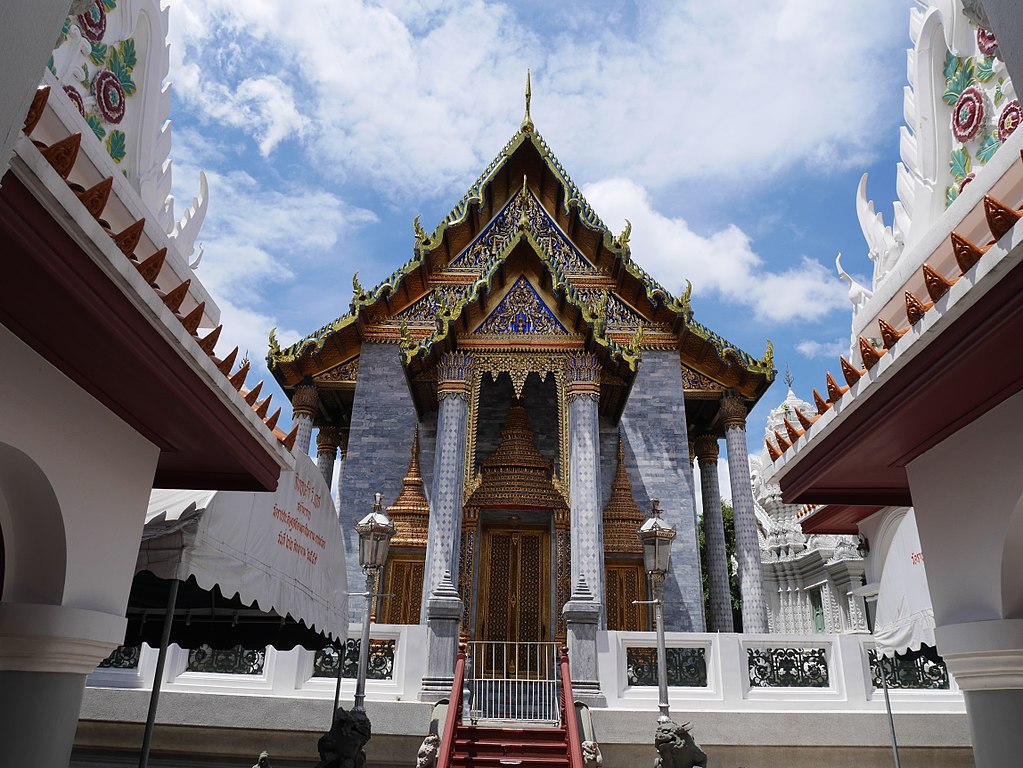
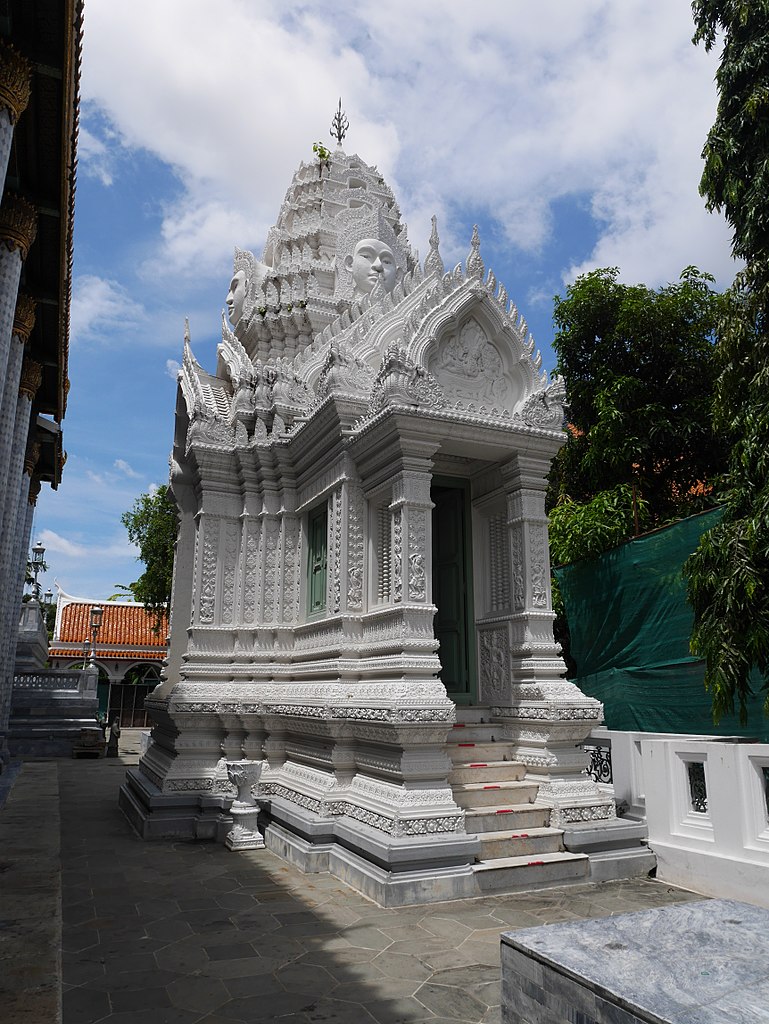
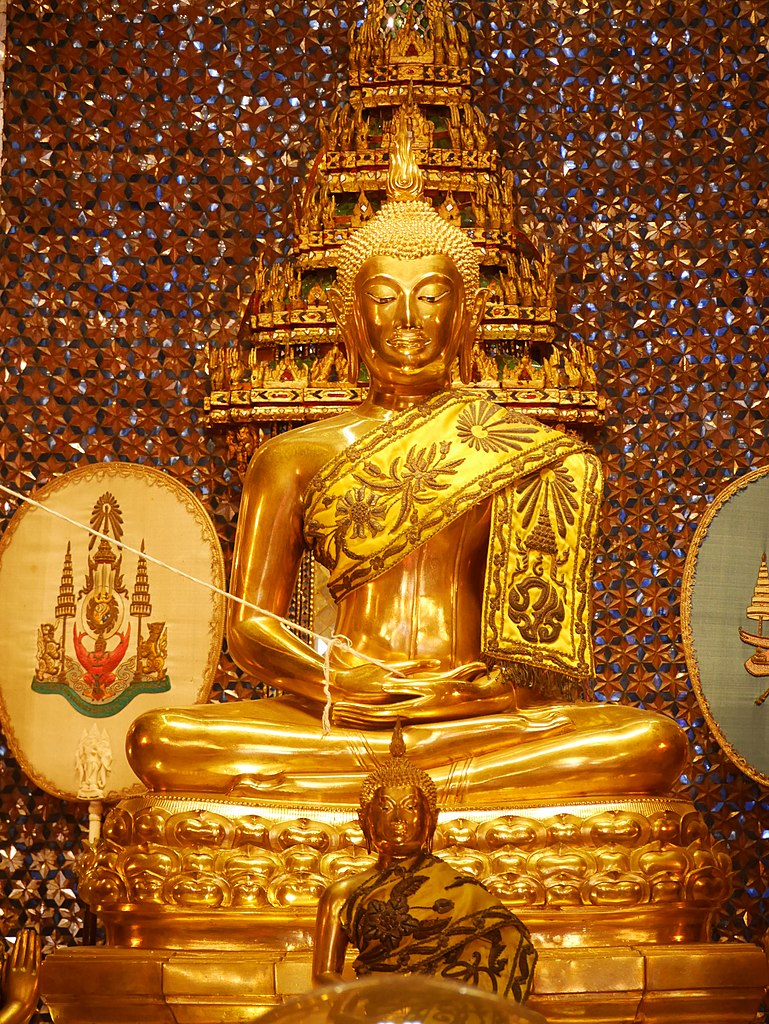
Wat Pho
By now, you’ve probably seen countless pictures of a humongous golden reclining Buddha somewhere in Thailand. Well, here’s where it is: Wat Pho Temple, in Bangkok.
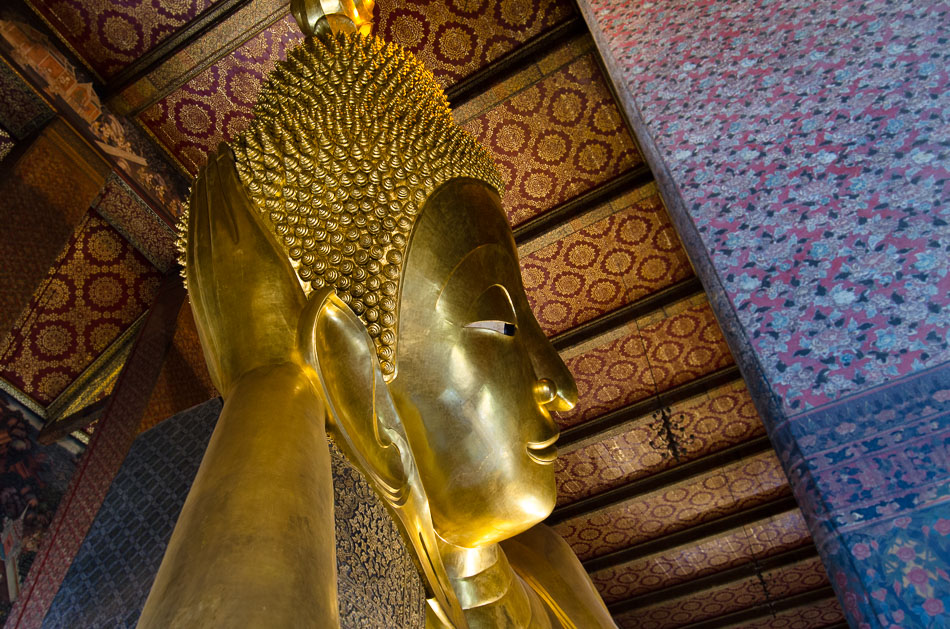
Wat Pho is just a 10-minute walk away from the Grand Palace.
It’s open from 8:00 to 17:00 and tickets cost 100 baht. However, don’t think you’re only paying to see the famous Buddha. The temple grounds and gardens are beautiful.
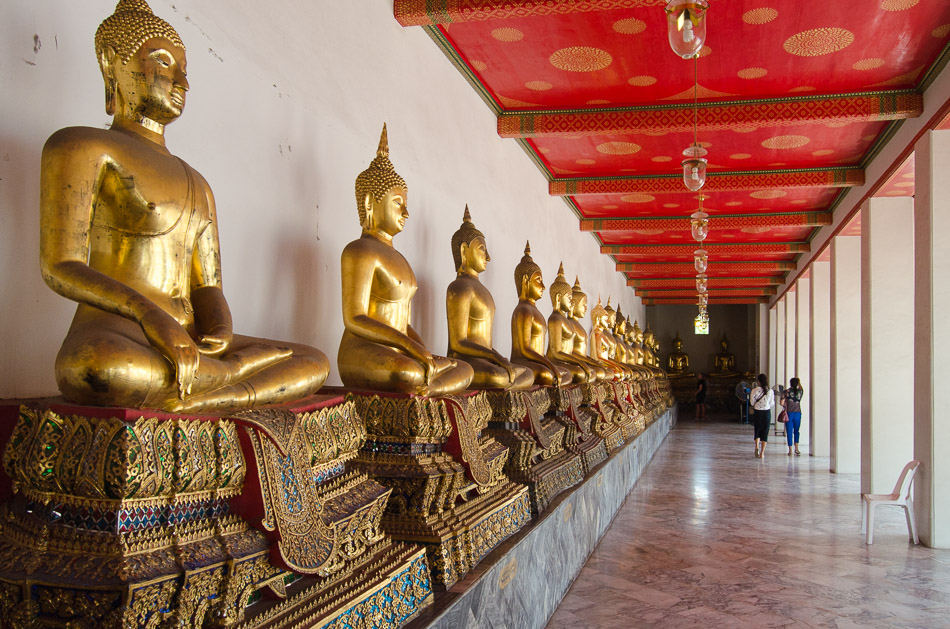
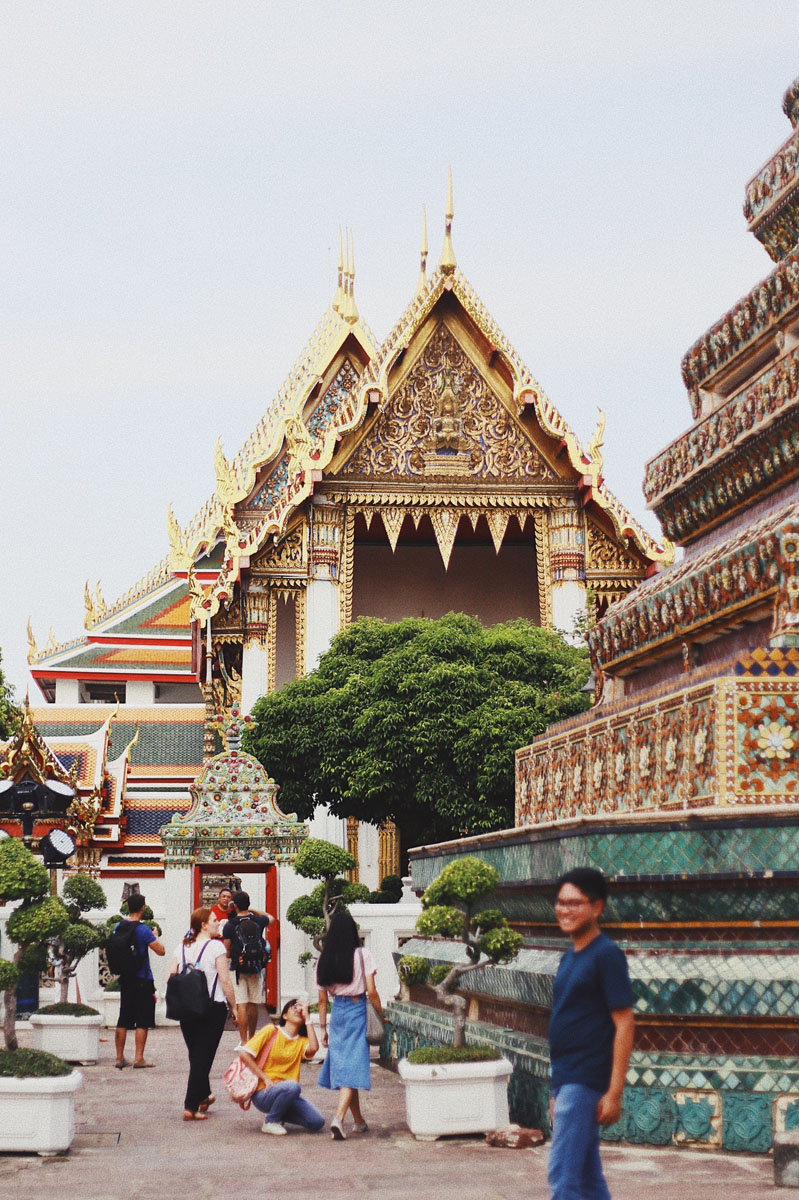
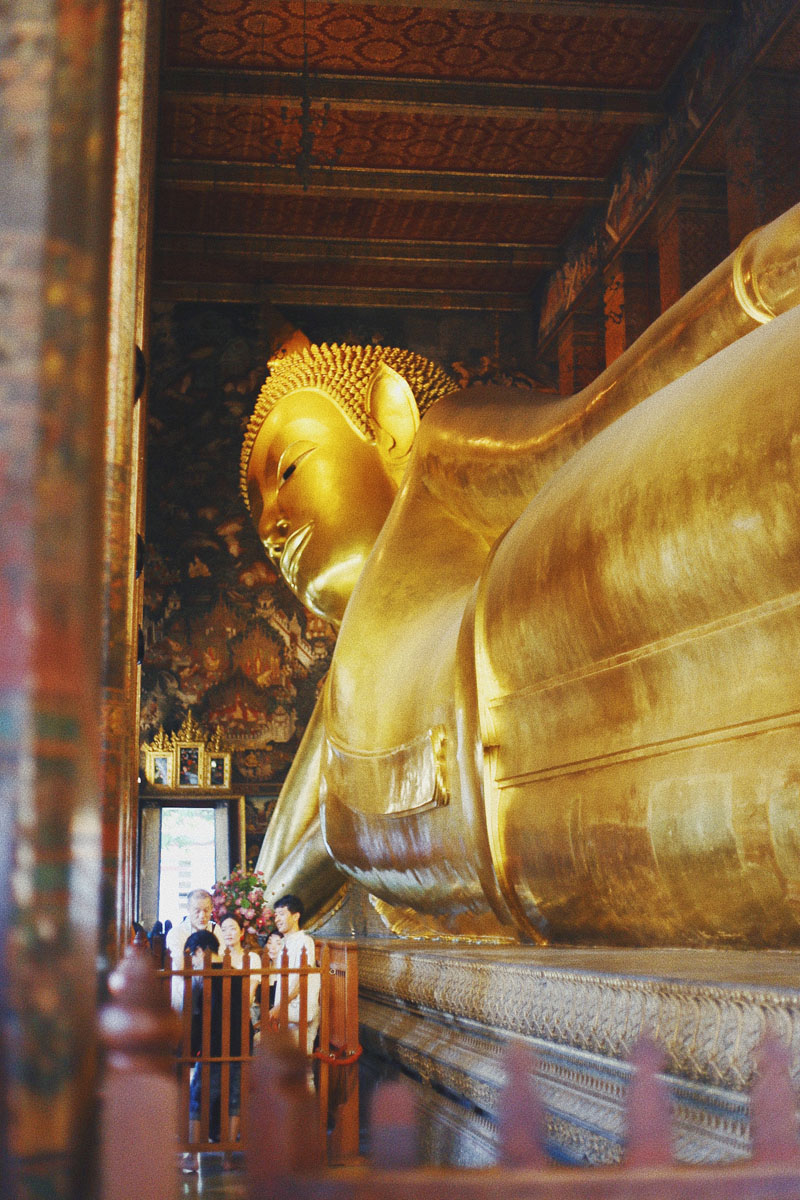
Wat Pho is also one of the best schools of Traditional Thai medicine and massage, so if you’re interested in a quality massage here’s your chance! These are the prices:
Traditional Thai massage
• 420 Baht for 1 hour
• 260 Baht for 30 minutes
Foot Massage
• 420 Baht for 1 hour
• 280 Baht for 30 minutes
For more information on what to expect from a Thai massage at Wat Pho visit: www.thaizer.com/getting-a-thai-massage-at-wat-pho
Lunch Break
If you started the day early as we suggested, it’s probably lunchtime by now and you’re likely to be hungry.
Grab lunch in the square right behind Wat Pho by the Tha Tian Pier. There are plenty of street food stalls to choose from. After lunch, you can catch the ferry to Wat Arun right there at the pier.
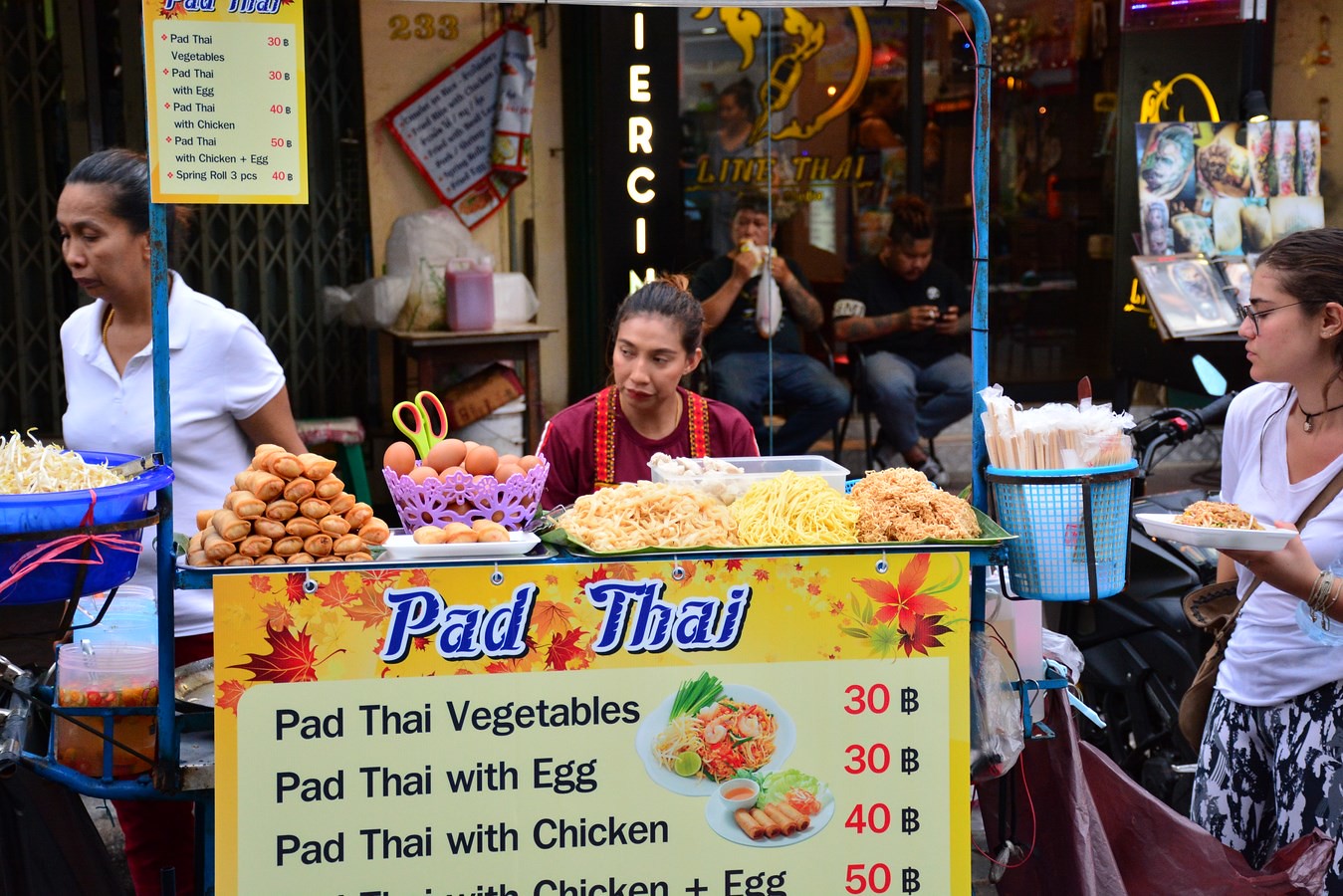
Wat Arun
Open from 8:30 to 17:30.
The admission fee is 50 baht.
Being one of the most visited temples in Bangkok, stopping by Wat Arun after lunch is a smart move. Here’s why: since the internet decided that Wat Arun was a popular spot to watch the sunset, many tourists started to cross the river in the late afternoon. That’s why we assigned the visit to Wat Arun after lunch because we know it would be a particularly quiet time in the day.
Tip: If you’re not following the sequence in this itinerary, early mornings are also a good time to visit.
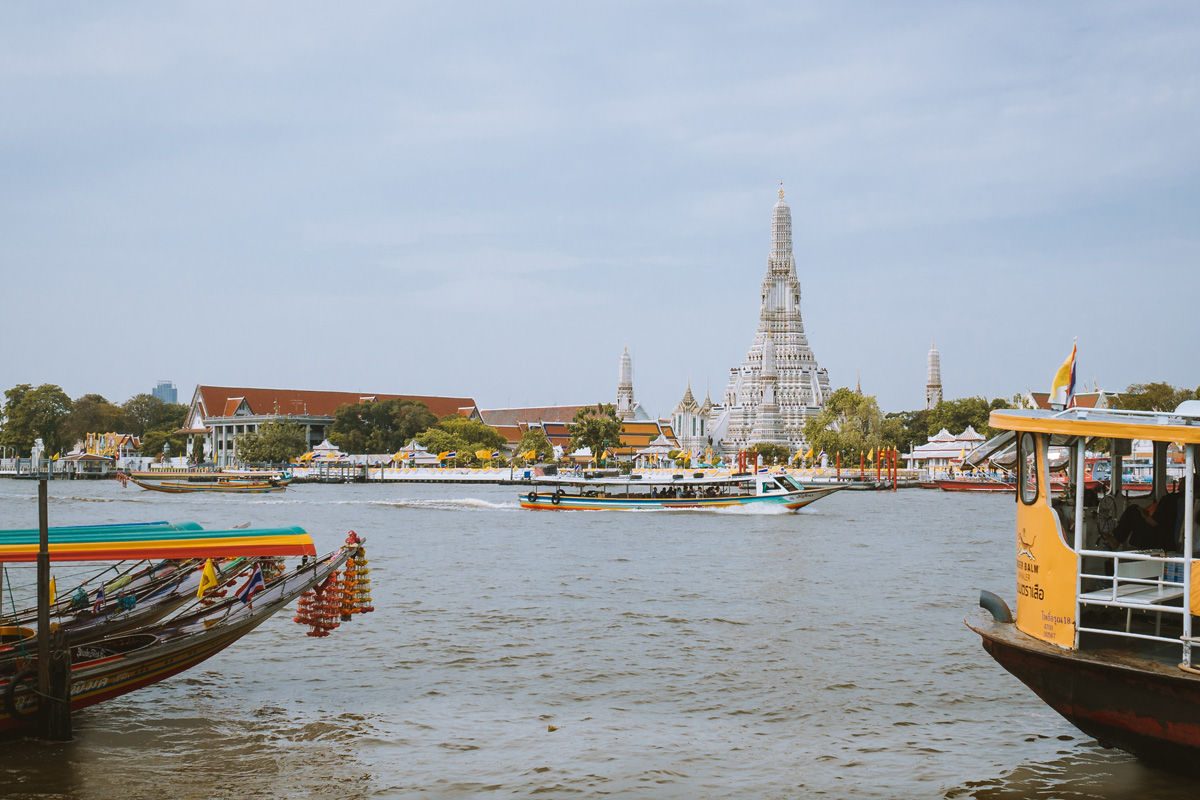
Climbing Wat Arun’s central prang will give you a privileged panoramic view of the river and the old part of the city. The last time we visited it, the prang was under restoration, so send us some pictures if you can.
Crossing the Chao Praya River to Wat Arun
To get to Wat Arun (on the other side of the river) you have to take the ferry departing from Tha Tien Express Boat Pier every 10 minutes or so. The trip takes around 5 minutes and gets you right by the temple for a 5 Baht fare.
2 extra sites close to Wat Arun (to visit if the day is going as planned)
1. Santa Cruz Church and the Kudeejeen neighborhood
Santa Cruz Church is one of Bangkok’s oldest Catholic churches, built to cater to the religious needs of the Portuguese community that lived in this part of town.
For 200 years, the peaceful communities of Catholics, Buddhists, and Muslims that settled around the church co-created a unique multicultural neighborhood (Kudeejeen) that is definitely worth exploring.
If you’re interested in a bit more history on the Portugal – Siam relations, read: www.tour-legacies.com/santa-cruz-church.html
2. Wat Prayoon
This temple stands out for its epic 80 meters high Chedi, the red iron fences made by ancient weapons, and the surrounding turtle pond and rock garden.
The peaceful temple grounds have many benches near the pond for you to relax. However, if you’re not into contemplative rest, visit the Buddha Images Museum. It has thousands of amulets, images, and artifacts that were found inside the base of the Chedi upon its restoration.
Wat Prayoon is open from 9:00 until 18:00 and there’s no entrance fee.
Bangkok’s Bonus Visit of the day
Artist’s House (Baan Silapin)
It’s the farthest place on the map, but worth a visit if you have time to spare.
Open from 10:00 to 18:00, this 200-year-old Thai wooden house it’s a creative space located along with one of the main canals of the Chao Praya River.
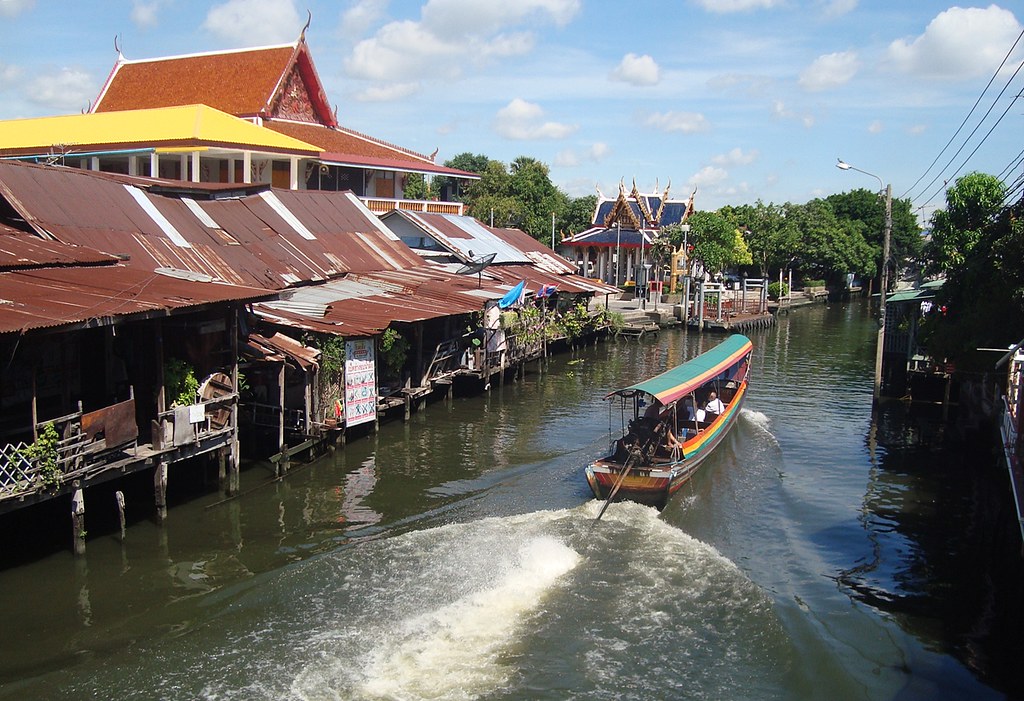
It’s a great place to chill after a hectic day in Bangkok. So grab a coffee, enjoy a traditional Thai meal by the river, or watch the free daily Thai puppet shot at 14:00.
The easiest way to get here is by taxi, but if you want to save some money (and don’t mind walking for a little bit) some buses can get you close-by.
Buses to the Artist’s House
From the city center 🚌
Hop onto the bus nº 68 and get off at the stop Wat Tha Phra. From here you’ll have to walk an extra 20 minutes.
From Wat Arun 🚌
If you’re at Wat Arun, take bus nº 710 to Bang Wa BTS station. Then, get off at Petchkasem 14 Tha Phra Intersection. From there walk 20 minutes north. See map above.
An evening on Rambuttri Alley
Rambuttri it’s a chilled and bohemian street enclosed with cool bars, lighted trees, and a mellow vibe that’ll make you want to hang out for the evening — especially after a full day.
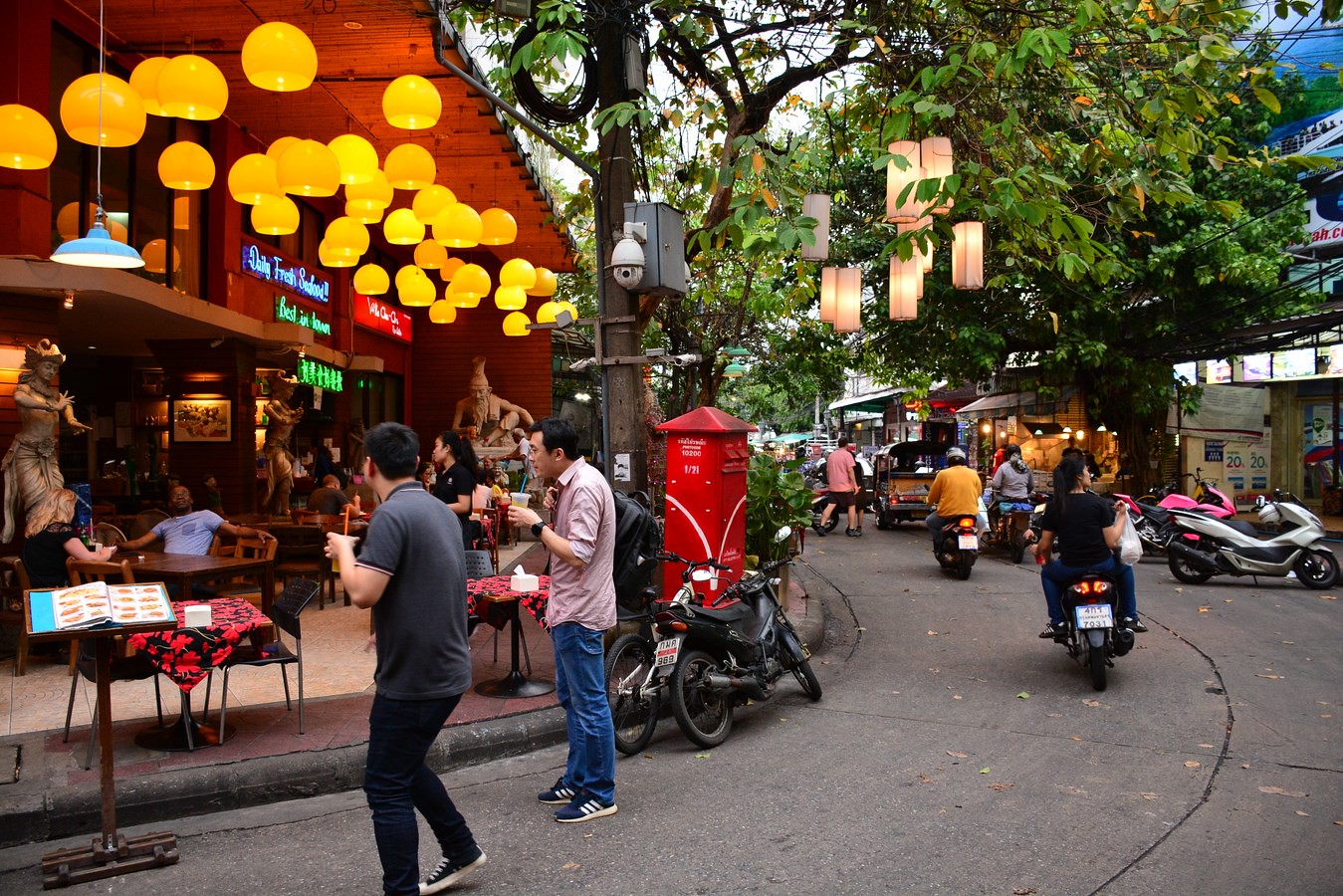
If you want a super affordable meal, we suggest any food stall along Rambuttri Alley for dinner, drinks, and dessert. However, if for some reason you feel a little iffy about food stalls, most bar terraces will serve meals, just expect a more touristy price.
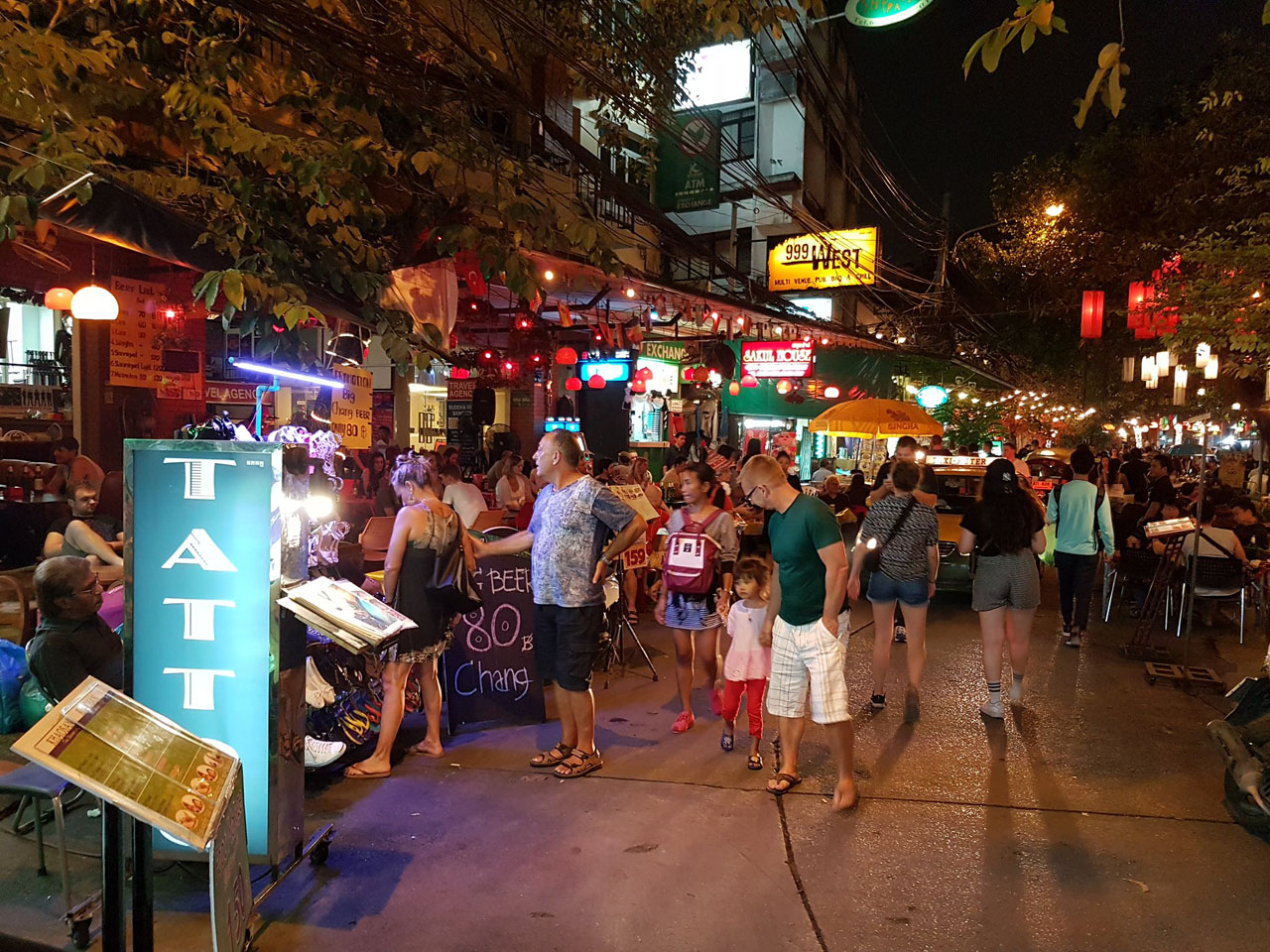
Not tired yet?
If you don’t feel like slowing down just yet or manage to thrive around chaotic energy, parallel to Rambuttri Alley is the infamous Kao San Road. There’s plenty of loud music, vodka buckets, and food vendors selling fried insects in their push-carts. Why not try some?
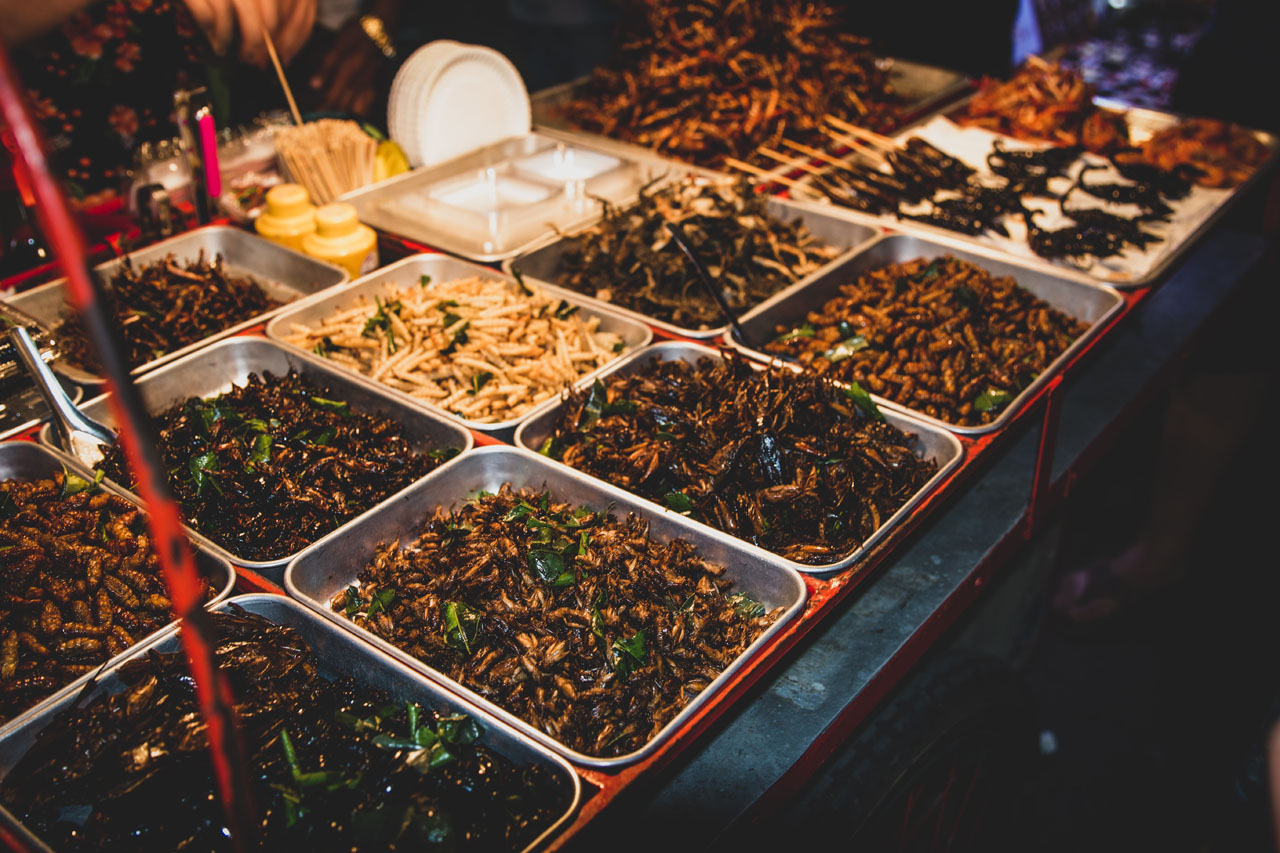
If you finished your first day, here’s day two, day three, and day four.
Quick Guide to Chiang Rai Night Markets
Chiang Rai night markets may not be as big as the ones in Chiang Mai, but what they lack in size they make up for in organization and in the laid-back character you’d expect from smaller-town bazaars.
So if you’re looking for things to do, great places to eat, and information on Chiang Rai’s nightlife, keep reading.
What to Expect from a Thai Night Market
– Northern Thai food and drinks
– Handcrafted products
– Thai massages
– Clothing
– Thai dancing shows
– Folk concerts
– And a good time
Thai people love night markets, and they do so for a reason: it’s too hot to be shopping during the day. For us foreigners, the night markets are more than a place to shop for souvenirs. They’re communal places to go for entertainment, music, and good food — we’re talking about Thailand after all!
Chiang Rai Saturday Night Market
Open every Saturday from 04:30 PM to 00:30 AM.
Located on Thana Lai Road, right in the city center.
Every Saturday by mid-afternoon, Thana Lai Road closes to traffic and opens up for people to wander through the stalls. After a bit of browsing, you’ll find the quality work of local artisans standing out from the generic bric-a-brac.
However, if you’re not planning on buying anything else due to your luggage being full, there’s an abundance of Thai snacks and desserts to fill your empty stomach.
If you go there to eat, we recommend an early dinner — by 8:00 PM the place will be jammed packed with people and the queues for buying food get quite long. Having said that, this is also the time when the market starts to come alive.
But besides the great food, there are other attractions in Chiang Rai Saturday Night Market. A good visual cue is: if the Chinese lanterns are lit, entertainers and musicians are performing.
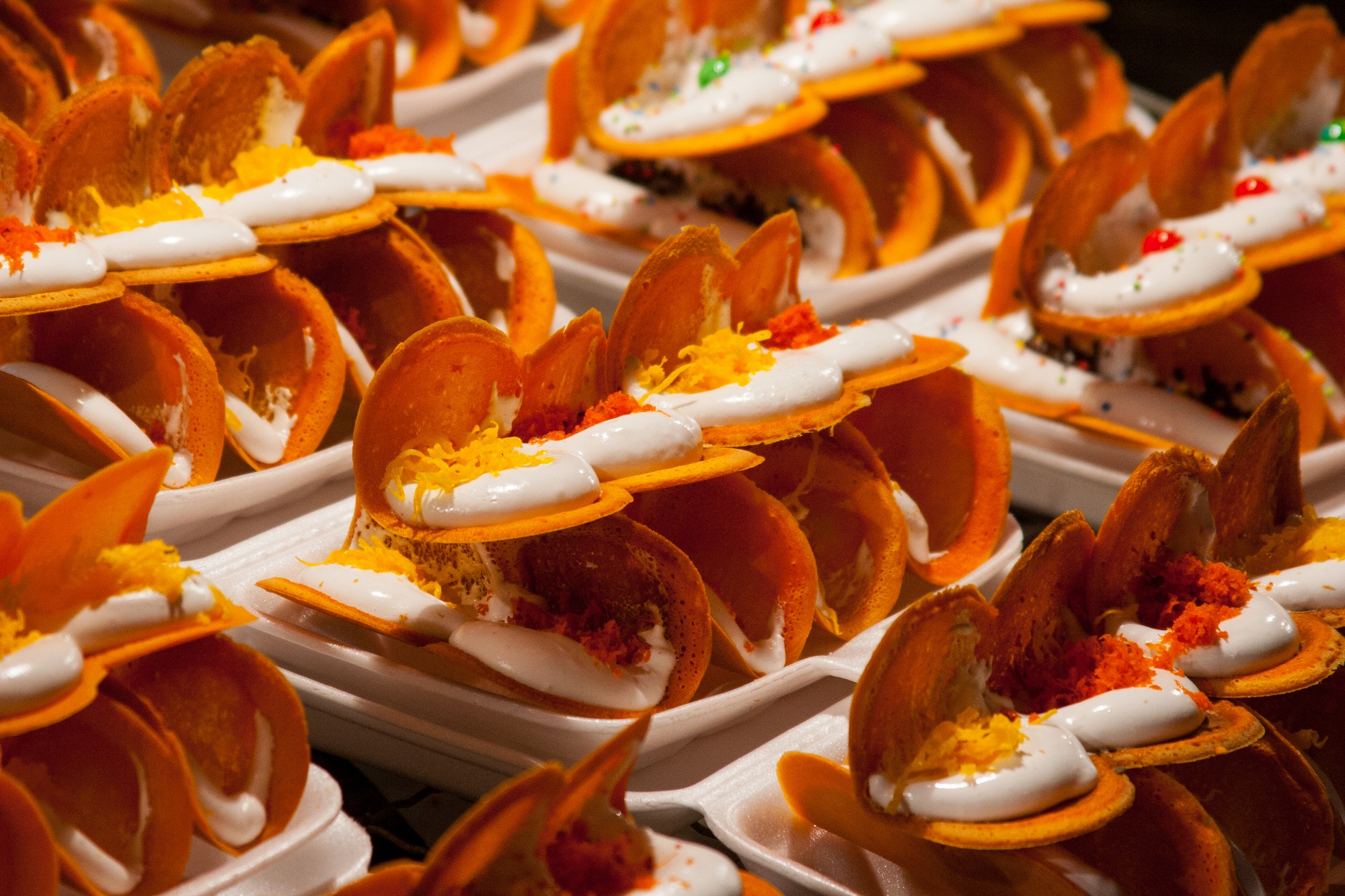
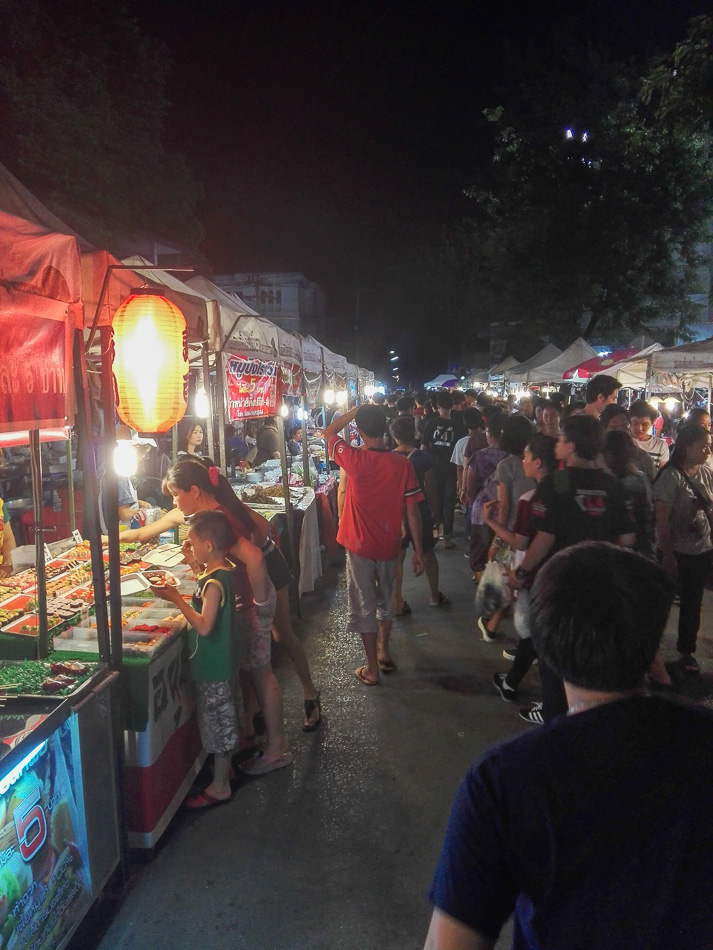
Tip: Around here, if you’re a tourist you’ll have to bargain. It’s very likely that sellers doubled the price just for you.
Sunday Happy Street (Snag Khon Noil)
Open Sundays from 5:00 PM to 11:00 PM.
Located on Sankhongnoi Road near the Chiang Rai Hospital. Just a 10-minute walk from the Night Bazaar.
The Sunday Happy Street in Chiang Rai is worth visiting for its family-friendly atmosphere. The eating spots on this one are a great way to relax, mingle with locals, and enjoy typical northern Thai cuisine.
The Sunday street market is smaller than the one on Saturdays, however, shops along Sankhongnoi Road open their doors so it all evens out in the end
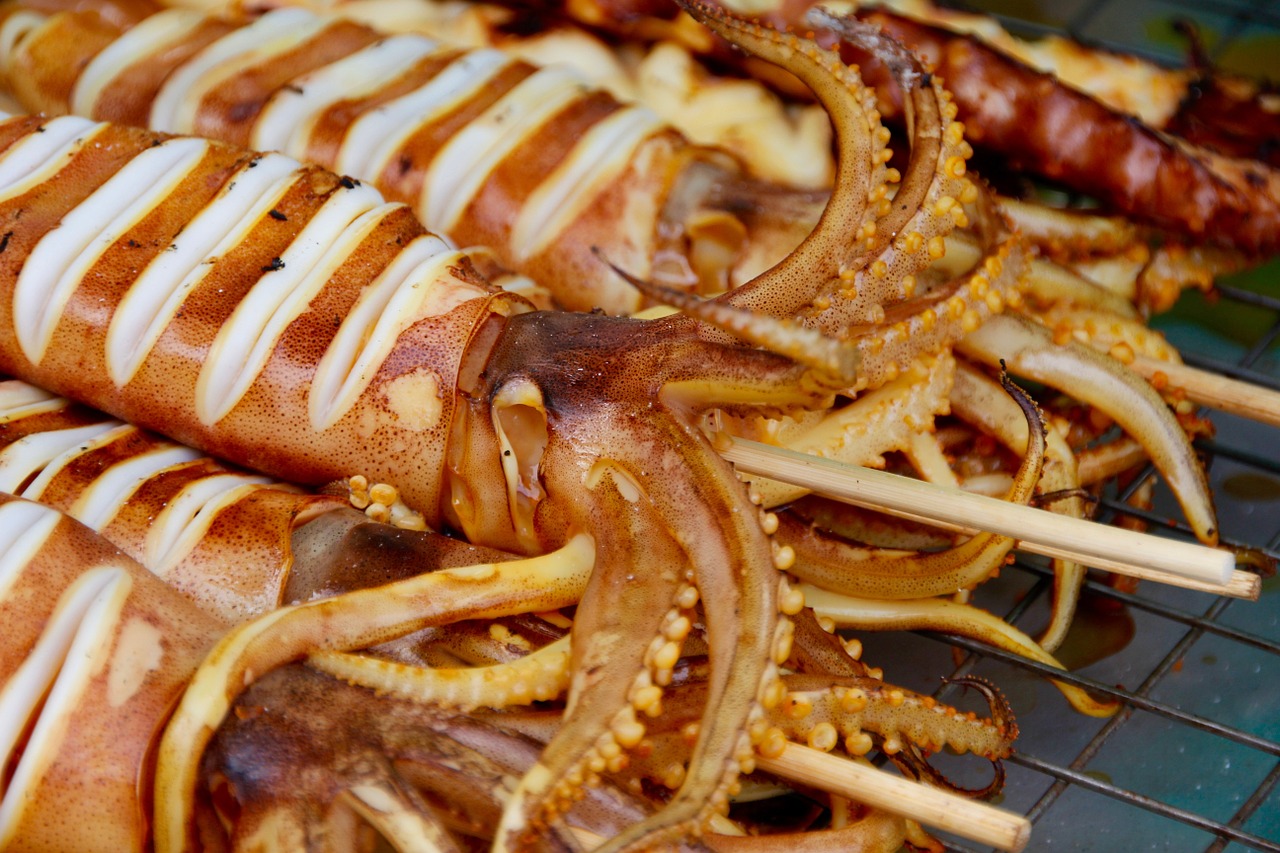
Chiang Rai Night Bazaar
Open daily from 6:00 PM to 11:00 PM.
Located near the Chiang Rai Bus Terminal 1, off Phaholyothin Road.
We found the Night Bazaar to be more touristy than the weekend markets. And not necessarily by the number of tourists walking around, but for the type of products being sold — the same overpriced knick-knacks repeated on every stall (but vendors were never pushy though).
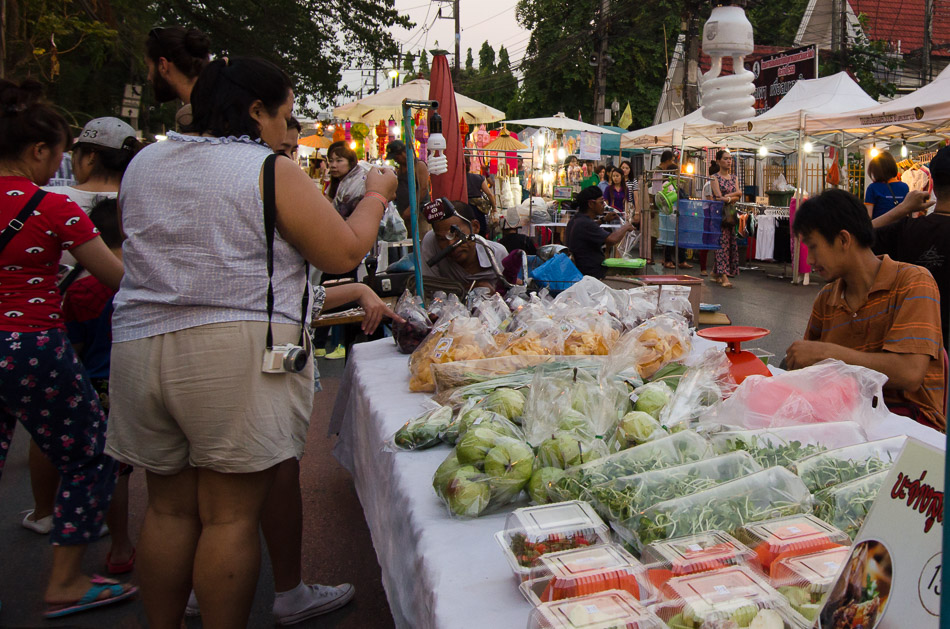
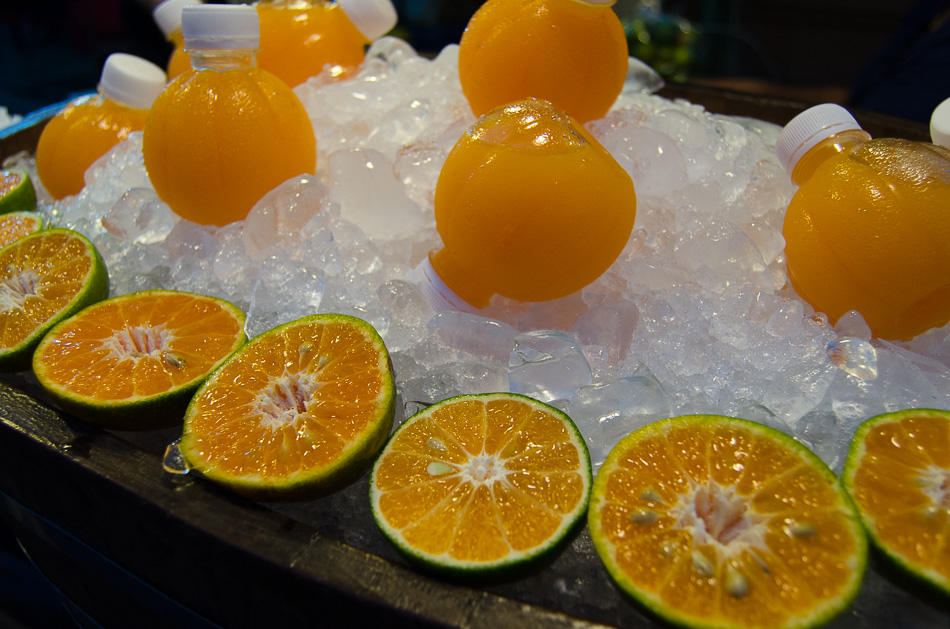
Most locals hang out near the food and beer area. Next to it is a temple yard with benches and tables where they eat, socialize, and watch the artists perform. When the crowd is familiar with the music, they’ll get up and dance, and everyone is invited to join.
The Chiang Rai Municipal Market Food Court
Open from 7:00 PM to 11:00 PM.
Located near the Night Bazaar is a tin-roofed Municipal Market.
It’s basically a food court with stalls all around the perimeter selling fried treats, and hot pots. In the center are hundreds of chairs and tables to eat on, and a stage where local entertainers perform while you munch a crispy deep-fried whatever.
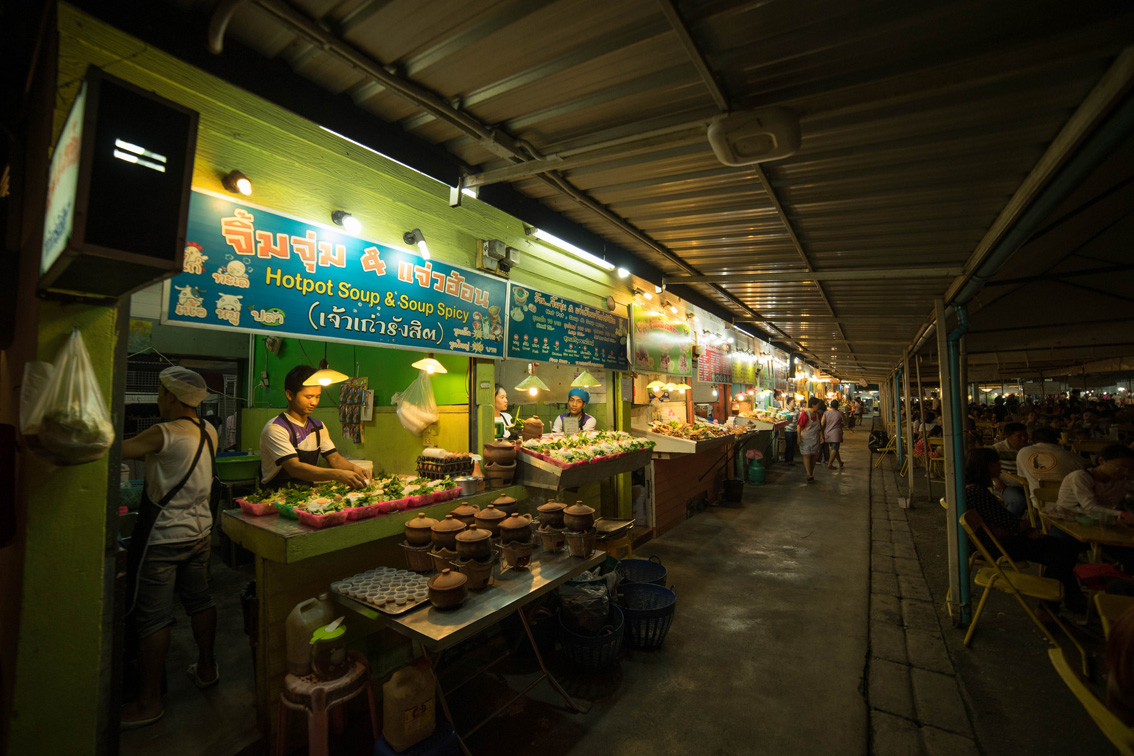
Photo by Marvin Wan
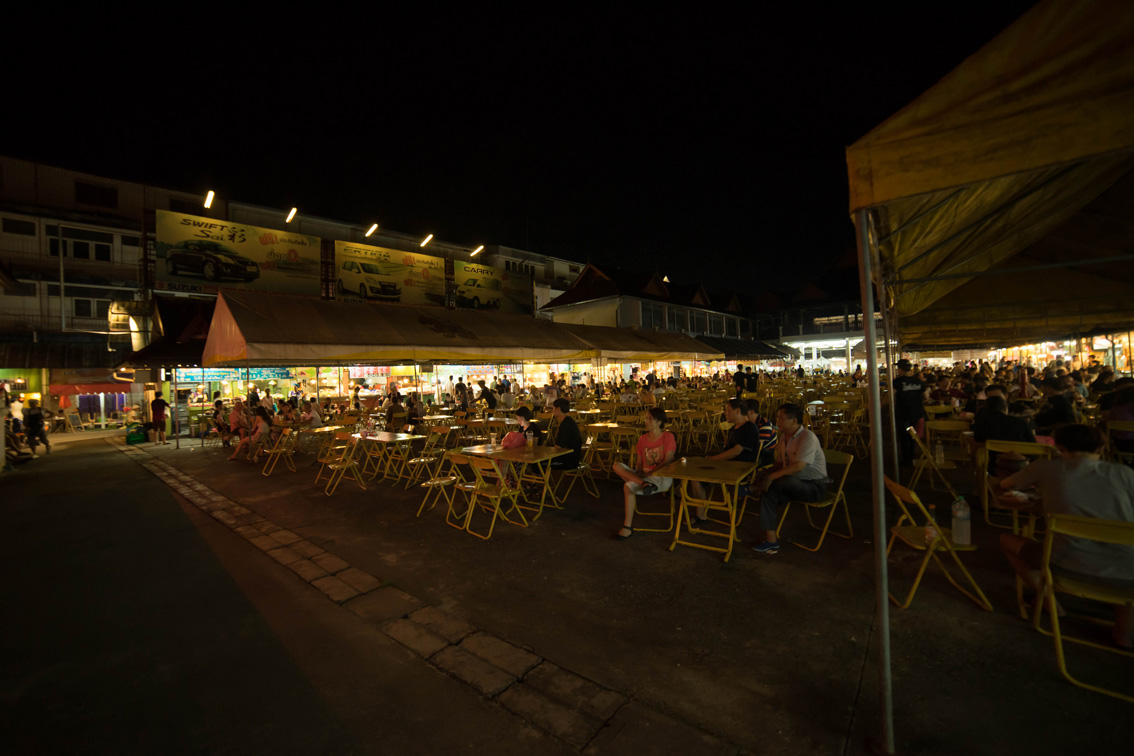
Image by Marvin Wan
Kaad Luang (The Big Wet Market)
Open daily from 5:00 PM to 00:00 A.M
Located on Uttarakit Road, three blocks north of the Clock Tower.
During the day Chiang Rai Kaad Luang is a regular bazaar, but as the sun begins to set, it transforms into a street food paradise.

Vendors hit the streets and set up their stalls around the main building. In almost no time, the entire street block is occupied by a myriad of fresh fruit and pick-up meal options: from fresh seafood to desserts.
If you don’t know where to begin, let the scents guide you.
Are you traveling in northern Thailand? Check out the 6 Best Markets in Chiang Mai.
Cover photo by Maxim B.
Taking the public bus to the White temple
The White Temple (Wat Rong Khun) is located 13km from Chiang Rai center, so you’re going to need some sort of transportation to get there. The distance and busy roads don’t make the bicycle a viable option, and the 300 TBH charged by taxis and songthaews is a bit too much.
That makes the public bus the cheapest alternative and more convenient transport.
Catching the Public Bus to the White Temple
We walked to Chiang Rai Bus Terminal 1 (in the city center, near the night bazaar) to find a bus that could take us to our destination. As we arrived at the bus station, we came across a rickety old blue bus with a tarpaulin saying “White Temple” on it.
…Well, that was easy!
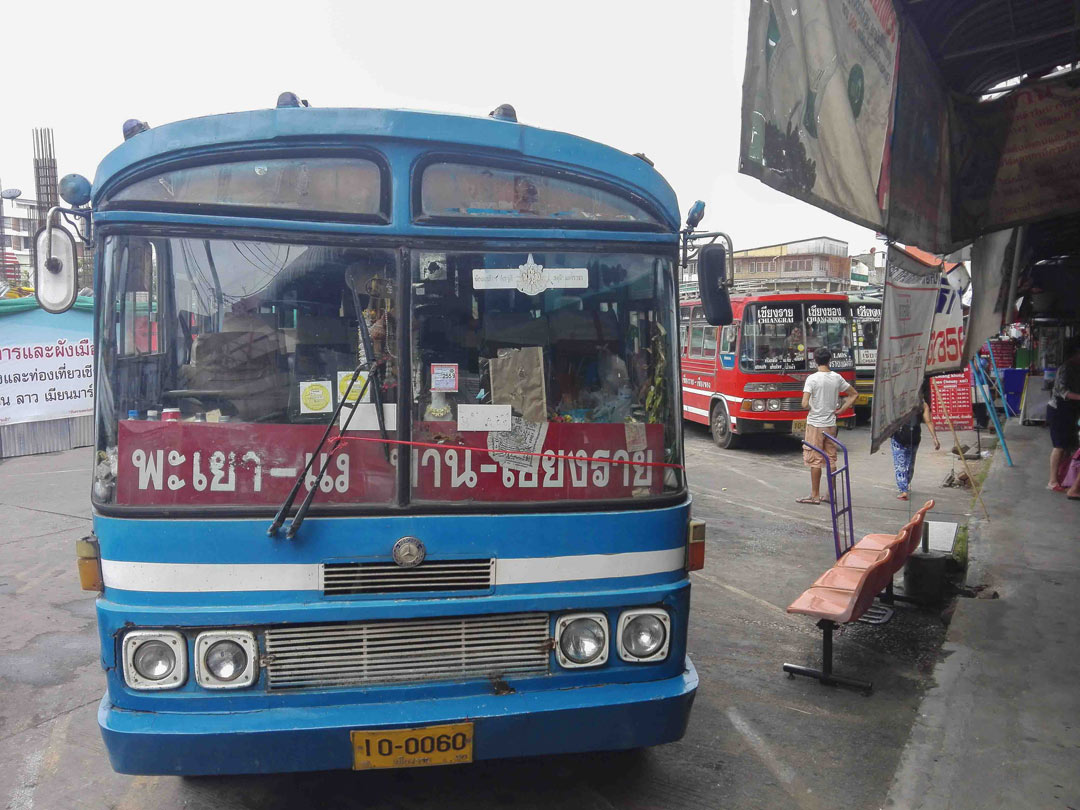
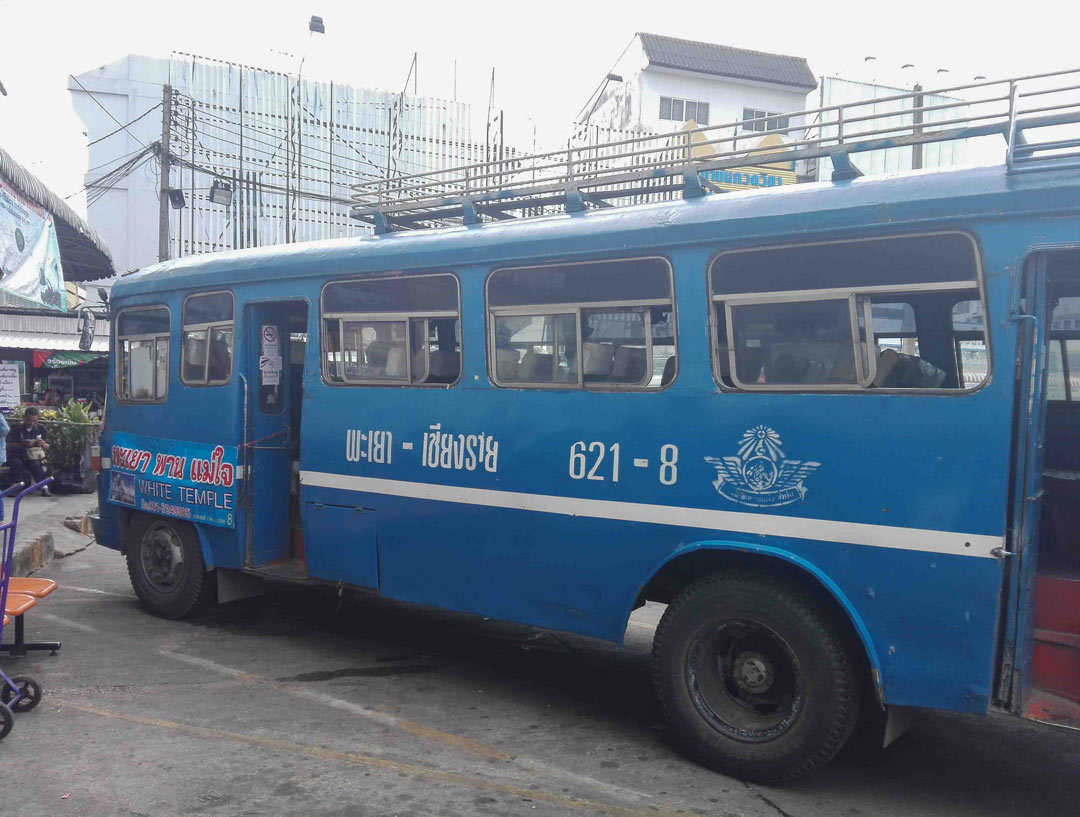
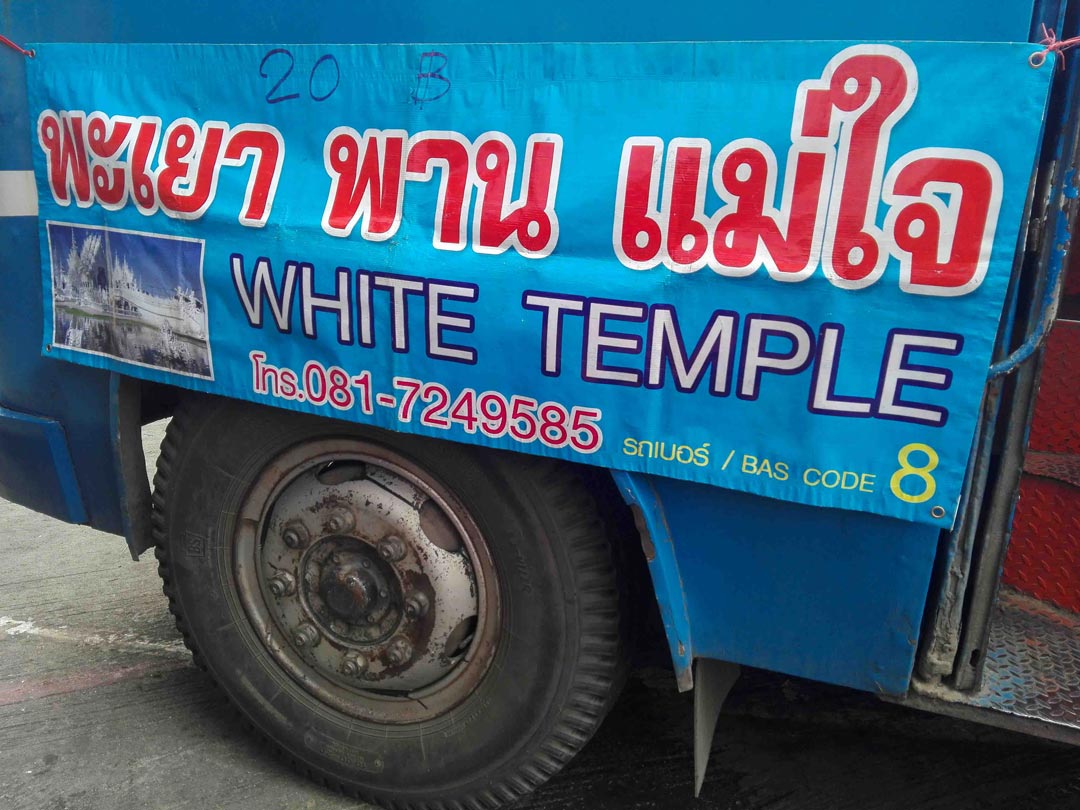
The big banner and the ticket revisor kept confirming that was the “only bus to the White Temple” which made us a bit suspicious. But after seeing several locals buy the ticket at the station kiosk and getting on the bus, we took a chance and did the same.
Bus timetable to the White Temple (2020)
Mornings: 06:15 – 07:10 – 08:10 – 09:10.
From 10:00 AM to 2:00 PM there’s a bus every 30 minutes.
Afternoons: 14:35 – 15:10 – 15:45 – 16:20 – 17:00
Cost: 20 Baht, one-way trip.
Duration: 20 minutes.
The bus was old and worn out but filled with character, and definitely worth the trip! From the weird proportions and rickety noises to the dashboard decorations made of Buddhist memorabilia, and every happy meal toy under the sun.
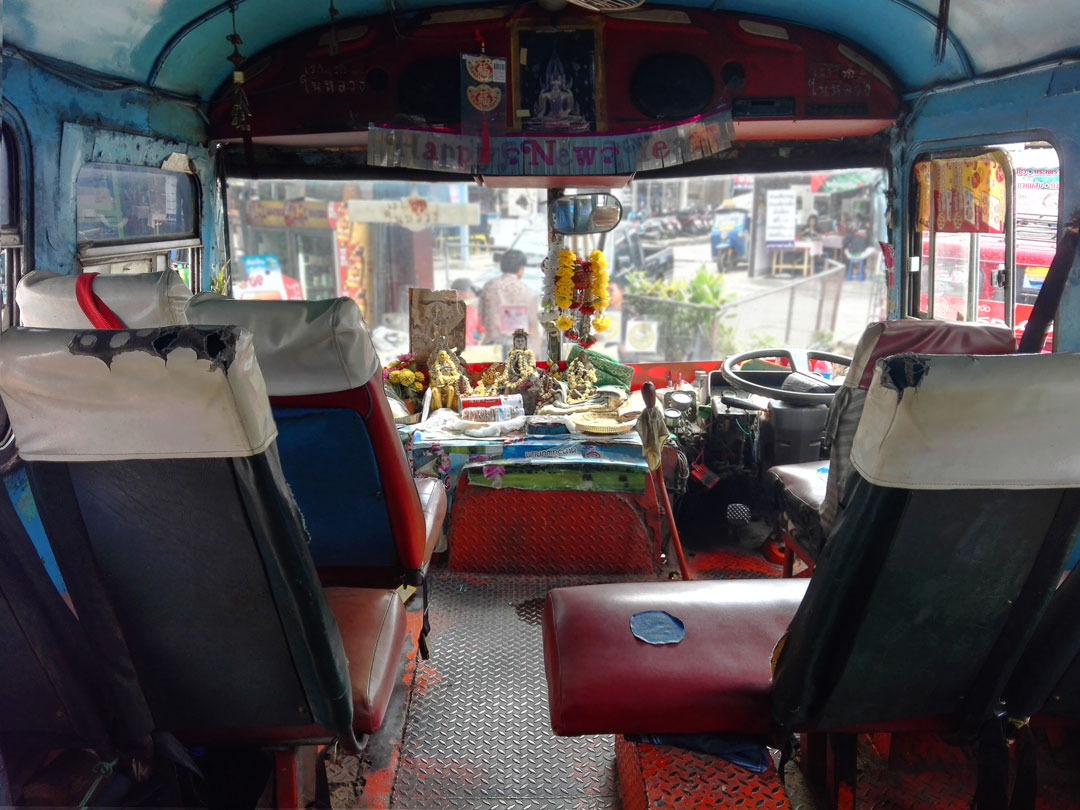
The revisor lady from before proved to be quite helpful by waving at us at the nearest bus stop to the White Temple: a generic spot just off Highway 1 (Phahonyothin Road), that we wouldn’t be able to identify on our own.
On the opposite side of the road, a few meters ahead were the grounds of the Wat Rong Khun.
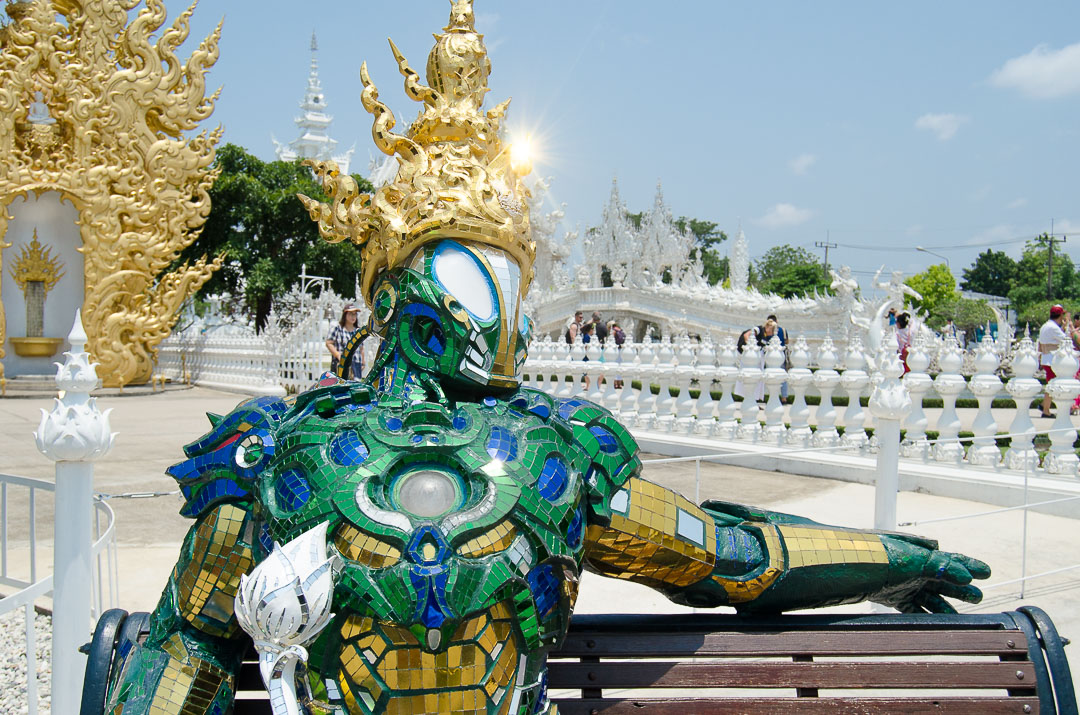
White Temple info
Opening hours: from 8:00 AM to 6:00 PM, closes at mid-day for an hour.
Entrance fee: Foreigners pay 100 Baht. Admission for Thai nationals is free.
Dress code: shoulders and knees must be covered, and as always, shoes must be taken off before entering the main temple.
You’ll need at a minimum, an hour for the visit.
Understanding the Art and History of the White Temple (Wat Rong Khun)
If you’re traveling around Thailand and are tired of visiting temples by now, suck it up and don’t miss this one — it’s one of Chiang Rai’s most visited attractions for a reason!
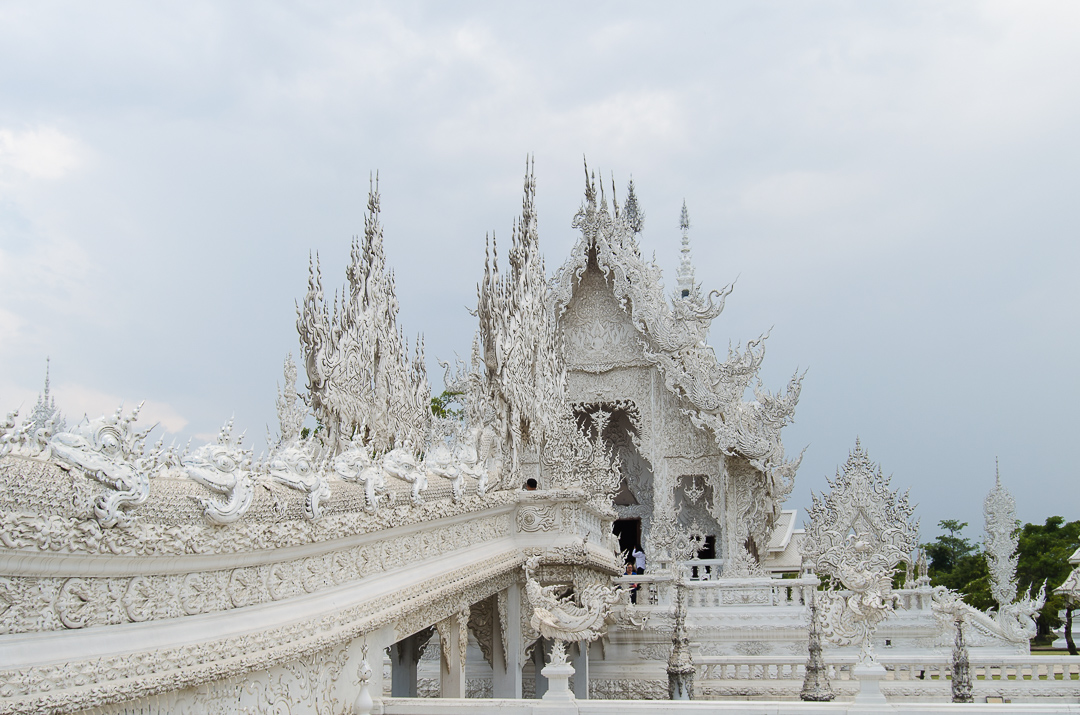
The lavishly decorated temple is unlike anything we saw around Thailand. Every element was consciously designed by the artist Chalermchai Kositpipat and is full of symbolism.
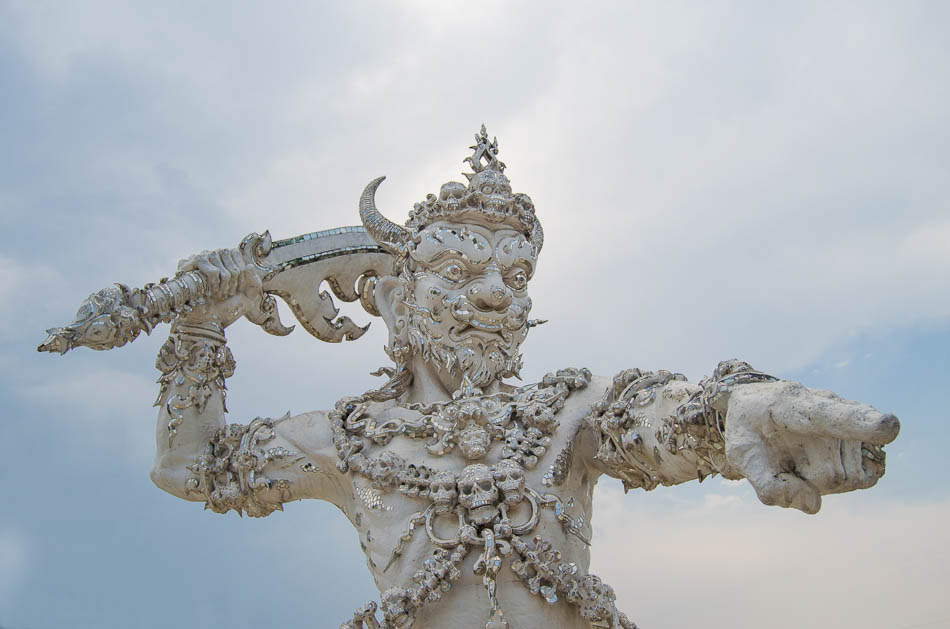
On the bridge leading to the temple, you’ll find depictions of the anger, suffering, and worldly temptations that you’ll have to leave behind to find happiness.
View this post on InstagramA post shared by Mario and Nuno | Travel (@helloplanetgravy) on
The temple is white to represent the purity of the Buddha, and the glistening intricate mirror work embedded on the plaster is there to reflect his wisdom to the world.
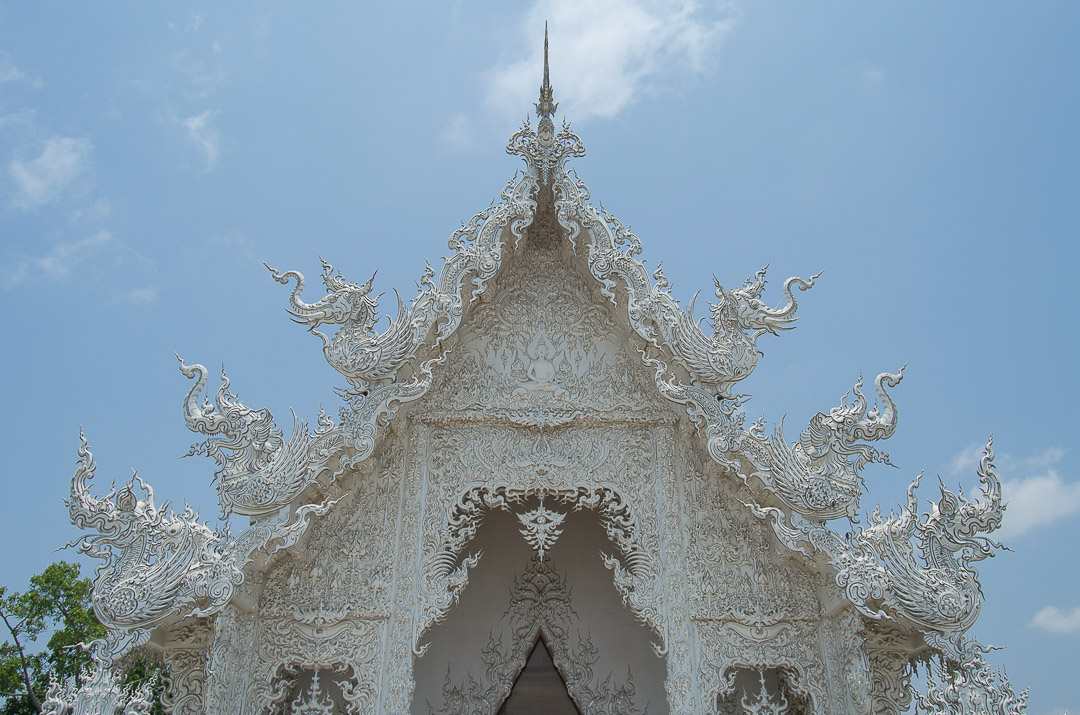
The interior of the main temple is all gold (and much smaller than it appears to be). On the back walls are paintings of pop culture reference like Hello Kitty, Spider-Man, the Terminator, and George W. Bush. These represent life without faith, they’re the false heroes incapable of saving the world from war and destruction.
On the walls in the front, where the altar is, you’ll see paintings of humans flying freely through the clouds. These represent the people who followed Buddha’s teachings and achieved peace. Sorry for the lack of pictures, but taking photos is not allowed in the main building.
The site grounds
On the outside of the temple is a canopy of prayer plates and by walking under it you’ll reach the meditation hall, the famous golden restroom, the art gallery, and the museum.
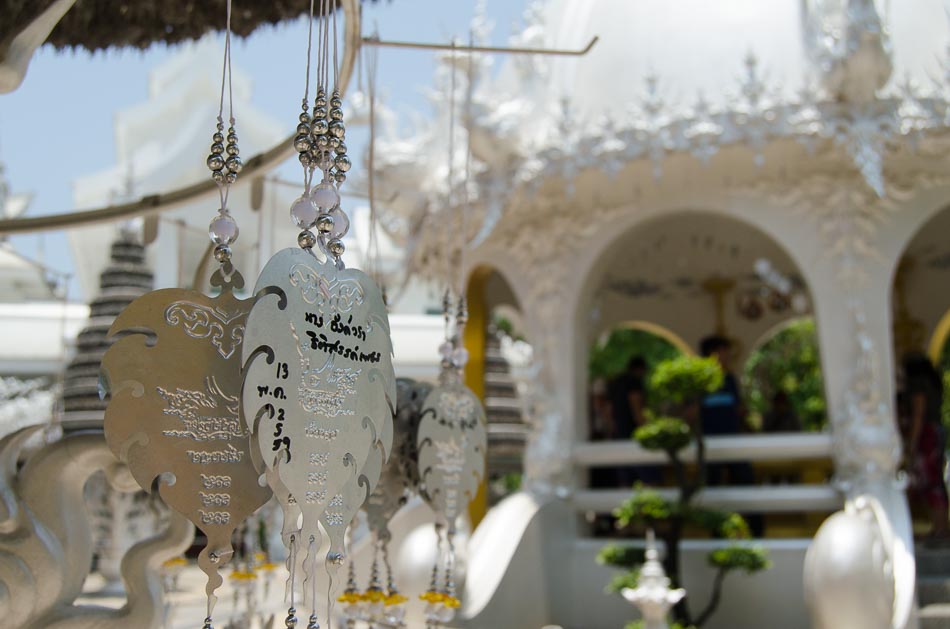

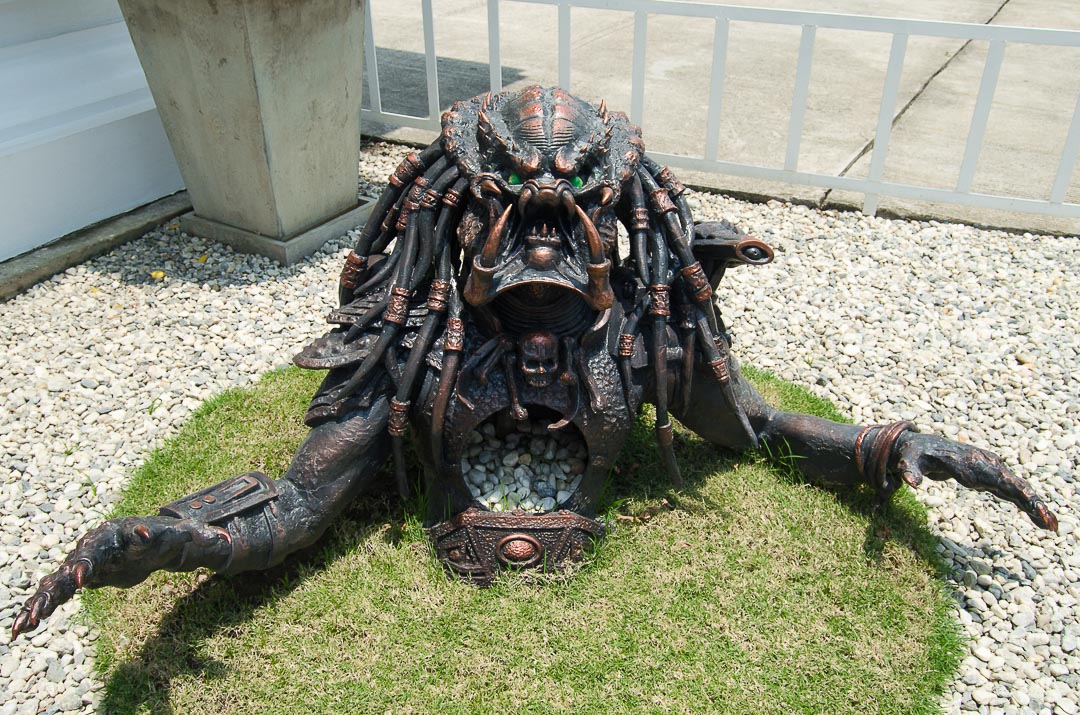
The museum is dedicated to the works of Chalermchai Kositpipat: many of his works are a satirical commentary on international politics and the destruction of the planet.
The temple site is still under construction and expanding. Only by 2070, the artist complete vision will be finished.
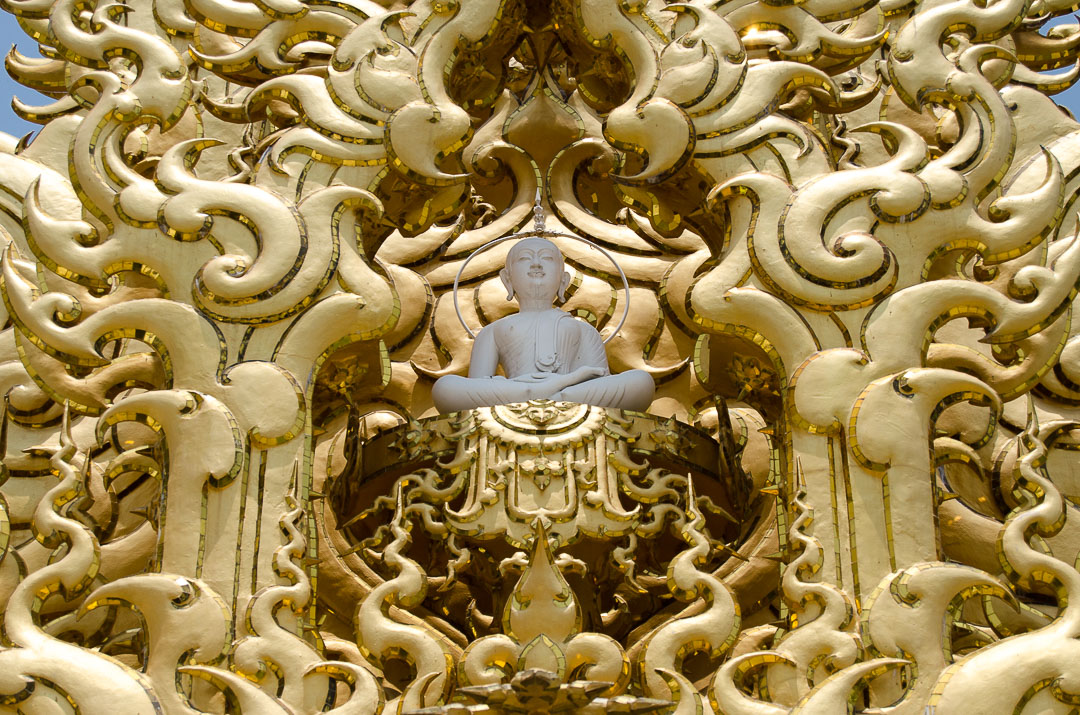

In front of Wat Rong Khun is a small area with cafes, restaurants, and shops.
About the Artist Chalermchai Kositpipat
Bus back to Chiang Rai
Head back towards the highway where you got off the bus and find a wooden pergola/ bus stop on the opposite side. Hail to the first bus you see (every half hour-ish). The trip back is a further 20 THB.
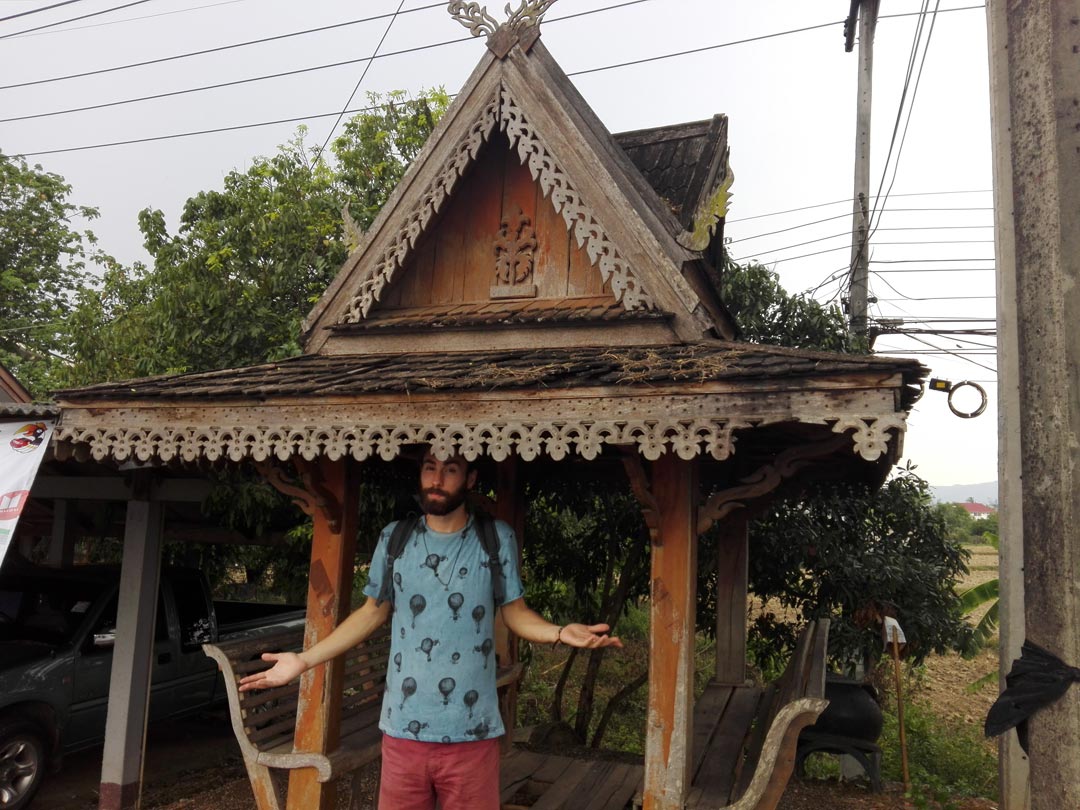
If you have any questions or new info to share about buses to the White Temple, leave it in the comments below.
The 6 Best Markets in Chiang Mai (from Popular to Obscure)
For many centuries, Chiang Mai had an important role in Thai commercial relations with China and the Burmese Kingdom. And these days, considering the number of open-air markets scattered all over town, we could say that trading heritage is still alive. Consequently and to honor that tradition, we’re showing you 6 of the best markets in Chiang Mai.
We aimed for diversity here: there are 3 popular markets, and 3 alternative shopping experiences (the type of market where you won’t find temple pants).
1. Chiang Mai night bazaar
Open: every day, from 6 PM to 10:30 PM.
Location: the intersection of Tha Pae and Chang Klang Roads.
The Chiang Mai Night Bazaar is one of the oldest evening markets in Thailand. These days is known as the best spot to buy fake designer goods: from shoes and clothing to fake Rolex and sunglasses.
Have in mind that around here, tourist are the main targets of the vendors so prices will be marked up at least 20%. Get ready to bargain!
But Nuno and I share the opinion that the real cultural experience is in the food and drinks area — especially if you like to eat al fresco. There are an array of stalls selling every street food you can imagine, sweet Thai snacks (like banana roti, mango and sticky rice, fruit smoothies), western style restaurants, and bars. All next to a gardened area perfect to socialize and watch the street artist perform.
2. Sunday Night Market (or Walking Street Market)
Open: every Sunday, all year round, from 4 P.M to 00.00 A.M.
Location: mainly on Ratchadamnoen Road in the center of the walled city, but keeps spreading down many side streets as it gets bigger every year.
Every Sunday afternoon, Ratchadamnoen Road closes to traffic allowing you to walk around without the constant fear of cars. However, that doesn’t mean you’ll experience a relaxed atmosphere.
The Sunday Night Market is the most popular shopping spot in Chiang Mai (both for locals and for tourists) and it can get a bit overwhelming.
Yet, unlike other popular Asian markets, the products on display stand out for its quality and craftsmanship once you filter out the generic bric-a-brac. That’s why it can be the perfect place to purchase souvenirs: you’ll find work from local artisans at great prices.
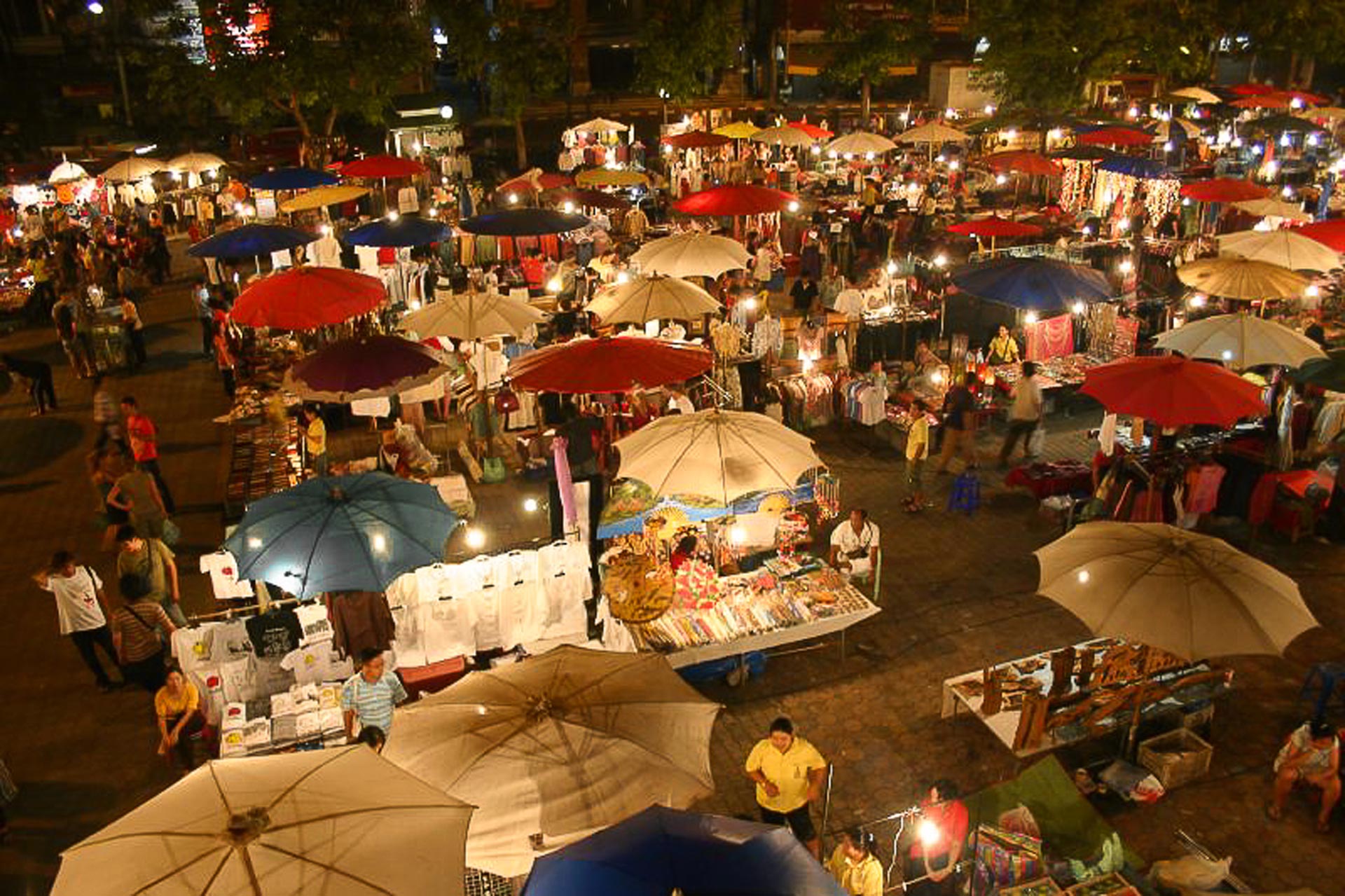
But if you’re more interested in the food and entertainment, there’s plenty of that as well. Multiple areas are dedicated to food, so ensure your stomach is empty before arrival. The shows, street entertainers, and musicians start performing after dark on the stages featured either side of the main road.
3. Warorot Market (Kaad Luang) Central Market
Open daily from 06 A.M to 7 P.M.
Located: at the Chang Moi Road, north of Nawarat Bridge near the west side of the River Ping.
Warorot Market (or Kad Luang as locals call it), is less touristy and confined to and around a three storey building, and the goods are organized by floors:
Ground floor: produce and food, particularly Northern Thai dishes such as grilled sausages, sweet curries, crispy pork skin.
Second and third floors: clothing and personal care products.
Alleys around Warorot Market: textiles, hill tribe handicraft, and the beautiful flower market Ton Lamyai.
Here’s where Thais do their shopping: from fresh produce to fireworks, and that’s why a visit to Warorot can be an immersive experience into the local way of life.
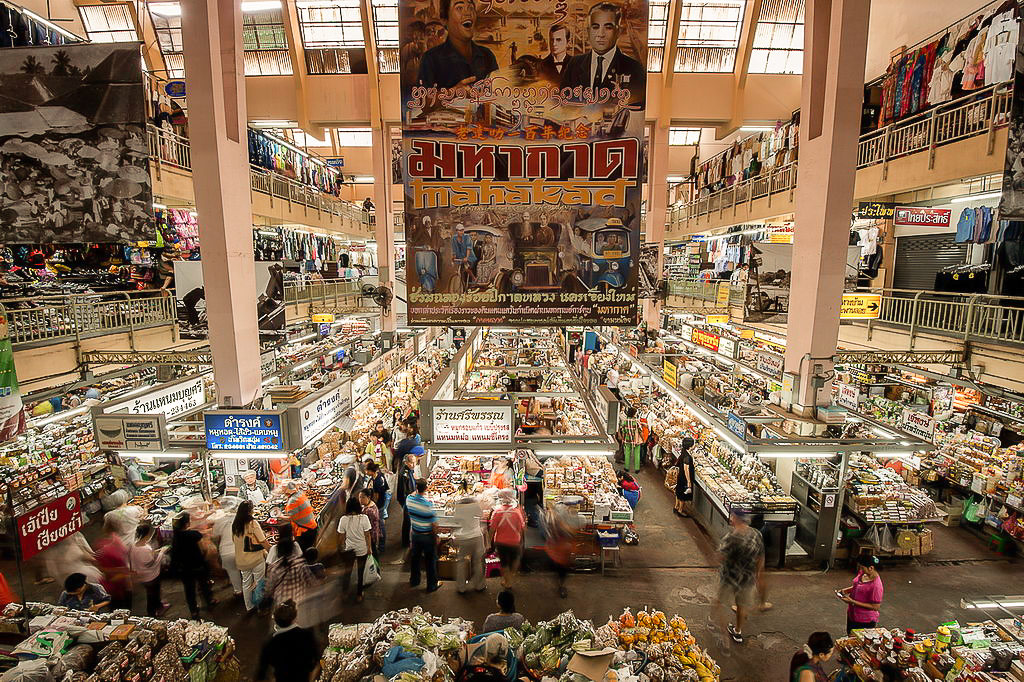
Plus, and as you might expect from a non-touristy place, prices are much cheaper so there’s no need to bargain for a discount.
4. Flower Market (Ton Lamyai)
Open 24 hours a day, Mondays to Sundays.
Best time to visit: early mornings.
Location: Thanon Praisani, next to Warorot Market, along the River Ping.
If you’re an early bird looking for a pleasurable market experience in Chiang Mai, head up to Ton Lamyai. This vibrant bazaar specialized in flowers is a beautiful way to start your day.
Piles, bouquets, and garlands of fresh blossoms arrive from farms around Chiang Mai in the early hours of the morning, adorning Ton Lamyai with exotic colors and the fragrance of a thousand flowers (so make sure to take an antihistamine before).
5. The Amulet Market (Kad Kham Tieng)
Open: Thursdays from 7 A.M to 2 P.M
Location: north of the Old City off the Superhighway behind Tesco Superstore.
Kad Kham Tieng is one of the most intriguing bazaars in Chiang Mai and the in-spot for all superstitious people. As most Thais believe that good luck, protection, and fortune can be influenced by wearing ‘charged’ amulets, the inventory around here is quite strange:
• Eyebrow hairs from special monks
• Incense ashes
• Monk blood
• Scarves with magic spells
• Pollen
• Old opium pipes
And thousands of other options — all spiritually charged by ceremonial chanting.
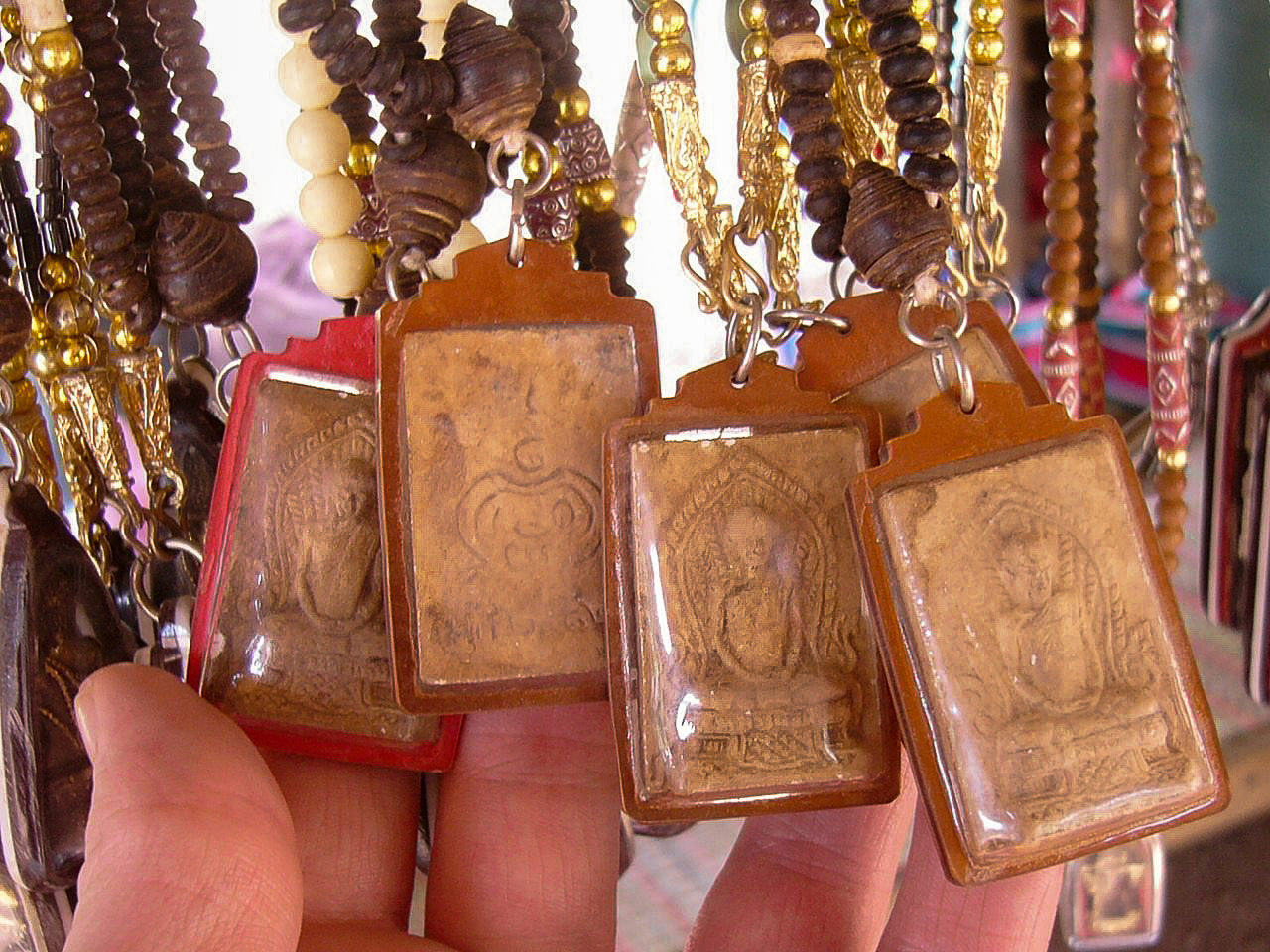
The amulet prices can go all the way up to 10 million bahts when considering its rarity, the monk that performed the ceremony, and the temple that ceremony was held.
Kad Kham Tieng may not a very large market, but it is a unique spot to spend your Thursday mornings in.
6. Jing Jai Organic market
Open: Wednesdays, Saturdays from 6 AM to 9 AM and Sundays from 6 AM 12 PM.
Location: 45 Assadathon Road, Chiang Mai
For the health conscious people wanting to move away from the touristy markets, Jing Jai is the best option. On Wednesdays, Saturdays, and Sunday mornings the market complex becomes a source for everything organic and locally grown: food, vegetables, fruits, and fresh pressed juices.
On Mondays, Tuesdays, and Fridays from 10 AM to 18 PM, you’ll still find a similarly relaxed atmosphere in the area, but there’s no Organic market. There are coffee shops and restaurants to sit back, and a few vendors selling second-hand furniture and antiques. In the evenings, the surrounding area comes to life with a myriad of outdoor Thai-style bars.
If we missed your favorite local market, feel free to shoot us a note in the comments!
The lineup for Chiang Mai Festivals (Year round Program)
Brahmanic, Buddhist, and Lanna heritages endowed Chiang Mai with a plentiful array of cultural expressions. Over time (and thanks to a community with artistic aptitude), traditions evolved into festivals and celebrations that won the hearts of Thais and the interest of the world.
Planning a visit to Chiang Mai? Festivals spread out year round, so there might be one coinciding with your visit. Check the program below:
January. Bo Sang Umbrella & Handicrafts Festival
When:
Every year on the third weekend of January, for 3 days.
Where:
Bo Sang, a village 9 km southeast of Chiang Mai.
How to get Bo Sang:
By songthaew or by bus (White Bus). You can catch either near the river by Warorot Market. The trip takes 25 minutes and should cost roughly 20 THB.
Bo Sang is home to skilled craftspeople in the making of rice paper fans, lanterns, and umbrellas. During the festival, the village streets and alleys are illuminated by lanterns, while hundreds of paper parasols decorate the outside of houses and shops.
It all gets particularly magical after the sun sets, so take the time to go for a night stroll and visit the umbrella making shops.
What to expect:
• Old school carnival games,
• Umbrella making workshops,
• Umbrella painting competition (locals compete to win the year’s most beautiful umbrella),
• Concerts,
• Lanna style dancing performances,
• Parades (2:00 PM)
• Northern Thai food festival,
• A local beauty pageant.
February. The Chiang Mai Flower Festival
When:
On the first weekend of February (1, 2, and 3 of February 2019)
Where:
The key spot is Nong Buak Haad public park.
The Flower Parade goes through Nawarat bridge to Thapae road, Kotchasarn Road, Changlor Road and Arak Road.
Running for over 40 years, the Chiang Mai Flower Festival is a 3-day celebration that showcases Chiang Mai’s unique flowers and plants (all in full bloom at the beginning of February).
What to expect:
• Rare flowers exhibitions,
• Dancers and entertainers,
• Musical performances,
• Plenty of Thai food and drinks,
• Miss Flower contest,
• The Flower Parade.
Photo by Devon Sampson
On Saturday morning (starting at 8 A.M), the long-awaited Flower Parade goes out to the streets. Floats are decorated with millions of natural flowers and accompanied by dancers in traditional costumes.
The floats are considered the highlight of the event. For many months in advance, thousands of locals participate in the building of the floats, making them items of great pride to the community.
As many Thais travel to Chiang Mai for the festivities, streets are not the only place that gets packed with people — so do accommodations. Make your reservations in advance!
Where:
Lanna Rock Garden in Hang Dong, south of Chiang Mai.
When:
February 2, 3, and 4.
Ticket price:
850THB (1-day ticket)
1.500THB (2-day ticket)
1.900THB (3-day ticket)
You can camp there for free if you take your own tent.
Jai Thep is a family-friendly festival created by a collective of artists, and defined as a “3-day celebration of art, music, and magic”.
Along the enclosure of the event are 4 stages occupied by bands and DJs from Thailand and the international scene.
Music genres:
• House
• Drum’n’bass
• Psytrance.
• Electro-chill
You’ll find hundreds of art installations and a great number of creative workshops that’ll suit adults and children.
For more information on Jai Thep go to www.jaithepfestival.com
April. Songkran the Water Festival
When:
April 13th, 14th and 15th 2018.
Where:
All over the city center, but the key celebration spots are near the Tha Pae Gate.
Marking the new solar year, the high energy ceremonies last for 3 days, and they’re the perfect time to let the child in you come out and play. The most popular custom of Songkran is the water fights all over town.
Have in mind that what to us Westerners seems like a good laugh, represents to Thai people the purification of the body and soul. Songkran is a beloved symbolic tradition, therefore some etiquette is required:
• Don’t take your shirt off, no matter how soaked or how hot it is that day
• No bikinis and no short-shorts.
• Don’t through water to monks, babies, and the elderly.
Tip:
Being the most anticipated public holiday for Thais, expats, and backpackers, book your accommodation early.
November. Yee Peng and Loi Krathong Festivals
When:
during the full moon of November, so the date is subject to change. If you write “Loy Krathong” on to Google, you’ll get the correct date for that year.
For 2018 the dates are November 21, 22 and 23.
Where:
Tha Pae gate, particularly between the Nawarat and Iron Bridges.
Loi Krathong or Festival of lights is celebrated for 3 days, once a year. Most ceremonies take place in the evening on various venues throughout Chiang Mai.
What to expect:
• Lantern procession,
• A beauty pageant,
• Parades,
• Boat races on the Mae Ping river,
• Krathong making competitions,
• Lantern release
• Krathong launch
The day before Loi Krathong takes place the Yee Peng ceremony. People decorate their houses, temples, and streets with paper lanterns of many shapes and colors.
At night the paper lanterns are lit and tossed into the air, carrying a wish for good fortune in the new year.
Simultaneously, on the Mae Ping river are released hundreds of krathong (baskets made of banana leaves, adorned with incense and candles), to honor the Water Spirit.
The krathong symbolizes letting go of all sins and misfortunes of the previous year.
Extra
For on and off festivals and upcoming events, check the website: City Now!- Chiang Mai.
Cover photo by Rodney Ee
Public bus to the bizarre Black House (Baan Dam) in Chiang Rai
If you want to save some money and don’t mind walking for a bit, the public bus is the cheapest option to get to The Black House (Baan Dam) in Chiang Rai.
Still, if you’re looking for an untroubled ride all the up to the gates of Baan Dam, there are some alternatives at the bottom of the post.
Catching the Green Bus
Go to the Chiang Rai old Bus Station (in the city center, near the night bazaar) and find the green bus going to Mae Sai usually parked on Platform 5.
Timetable: green buses departure every 15 to 30 minutes, or when the bus gets full.
Bus ticket price: 20 Baht one-way trip.
Duration: around 20 minutes.
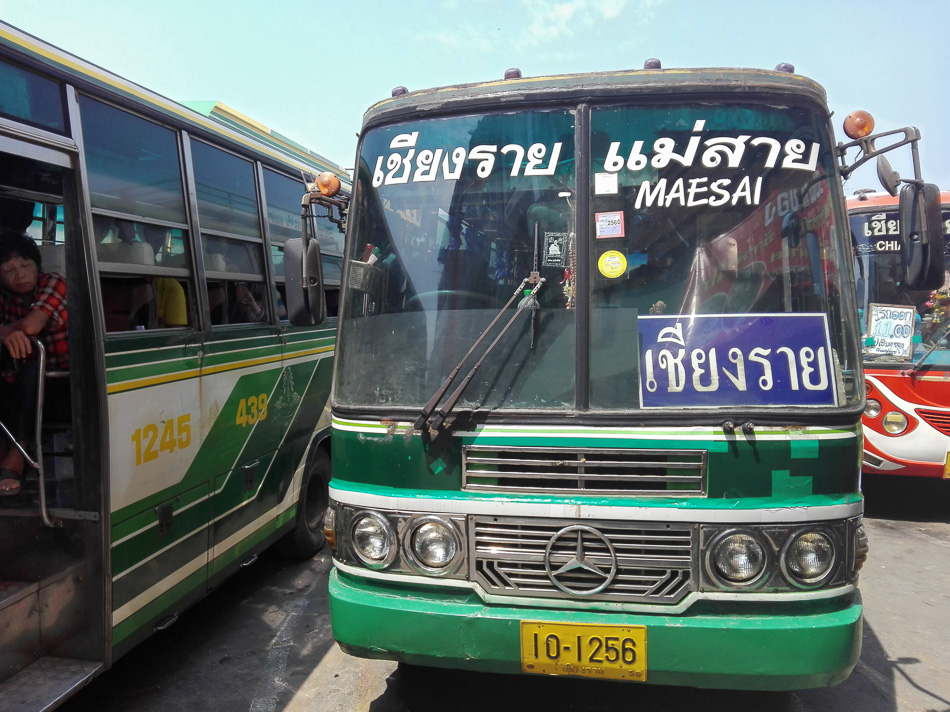
When you buy your ticket inside the bus, let the driver and ticket holder know that you’re going to the Black House so they can signal you at the drop-off point. When you leave the bus you’ll have 2 route options:
The route to the back entrance (the shortest) Updated Nov. 2018
Right next to the drop-off spot is the correct lane to walk on. After walking 50 meters, The Black House buildings will become visible to your left.
Turn left at the wooden-gazeebo-looking-sign indicating Soi 13 and walk a further 10 minutes. This path will take you through some houses and up to a small clearing where you’ll see the back entrance of The Black House.
Heads up: visitors are now charged a fee to enter the park but you can’t buy a ticket at the rear entrance (yet). So even though this route works, you’ll end up being escorted by a guard to the main entrance to buy your ticket — and that can be annoying to him because it’s not his fault that we’re lazy.
Route to the front entrance
Alternatively, instead of turning left on Soi 13, keep walking straight on the paved road for approximately 400 meters and then turn left into a small Soi that takes you to the front entrance of Baan Dam. Check the map below.
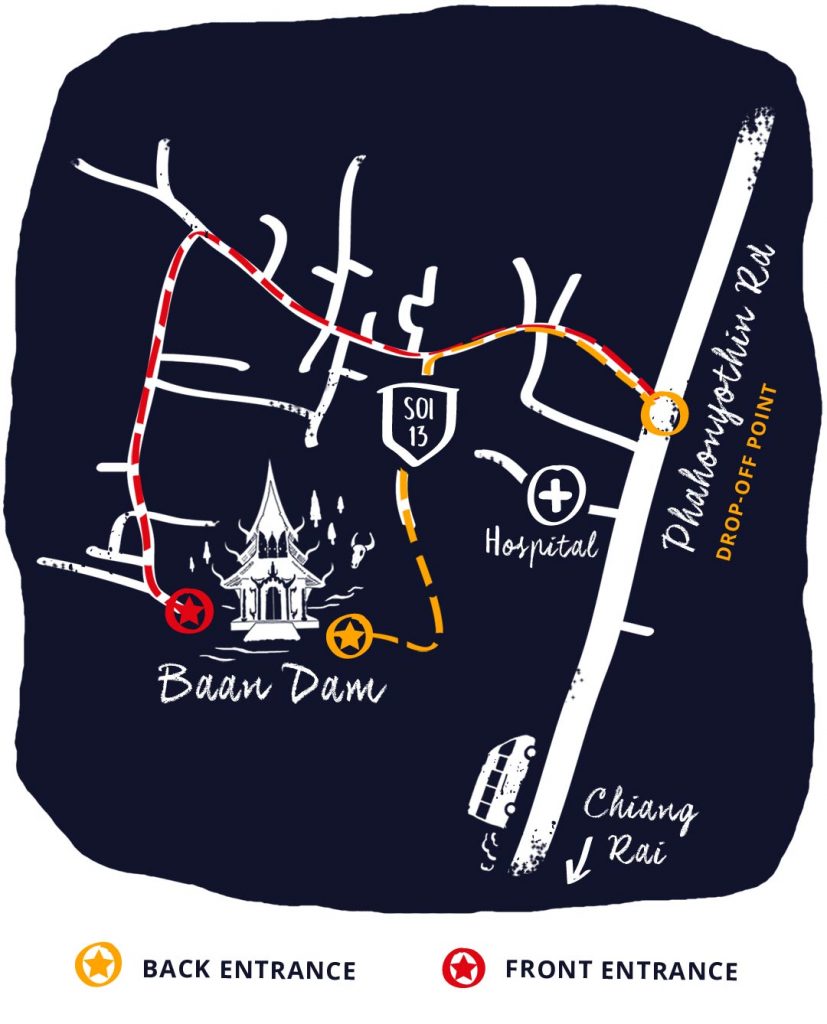
Baan Dam – The Black House
Opening hours: opens daily (weekends included), from 09:00 AM to 5:00 PM.
Closes for lunch from 12:00 PM to 1:00 PM.
Entrance fee: 80 Baht.
In a 100 acres parkland in the Ban Du district, north of Chiang Rai, Thai artist Thawan Duchanee spent 25 years creating Baan Dam (the Black House).
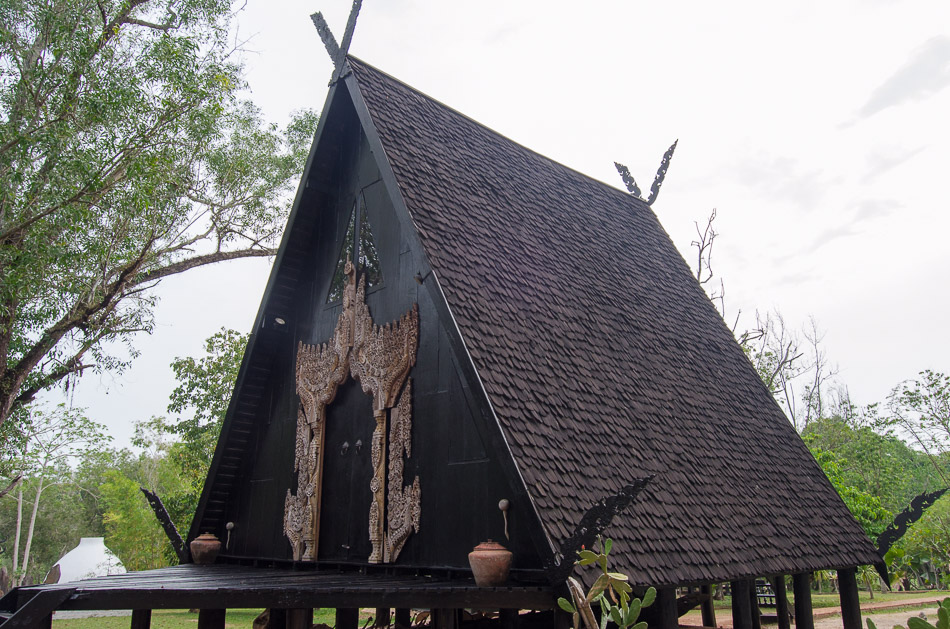

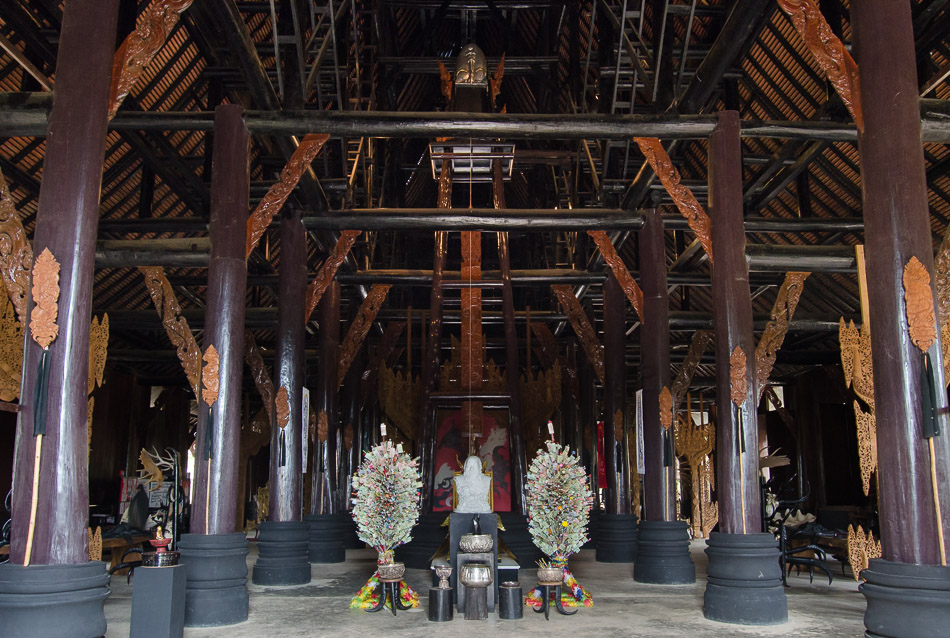

There are 40 buildings spread around the park along with art pieces and installations. Most buildings are made of black wood and decorated with macabre elements like bones, animal skins, pelts, and dead animal parts.
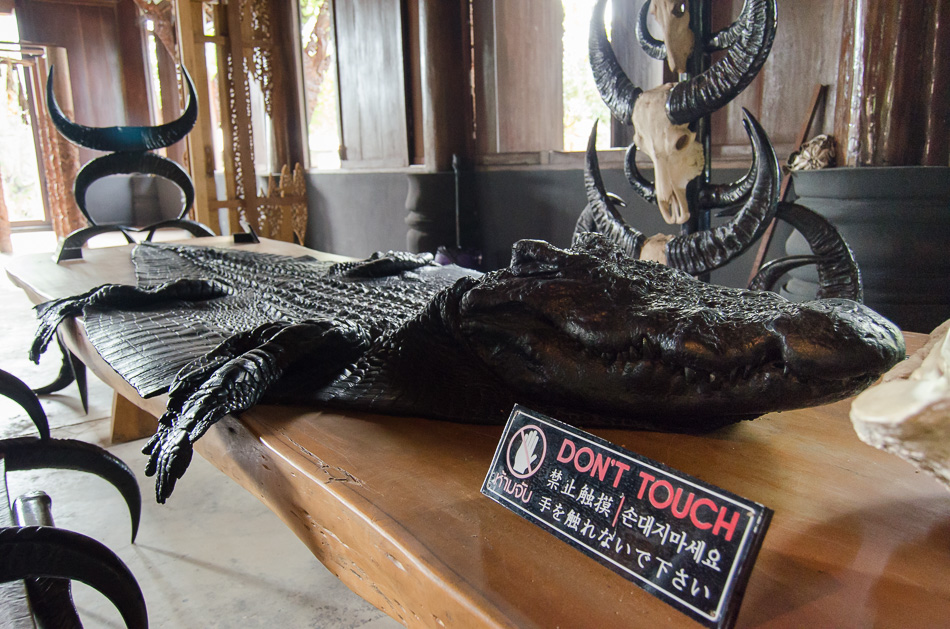
Duchanee’s art mixes traditional northern Thai design with Balinese, Burmese and African influences—and it’s all open to interpretation.
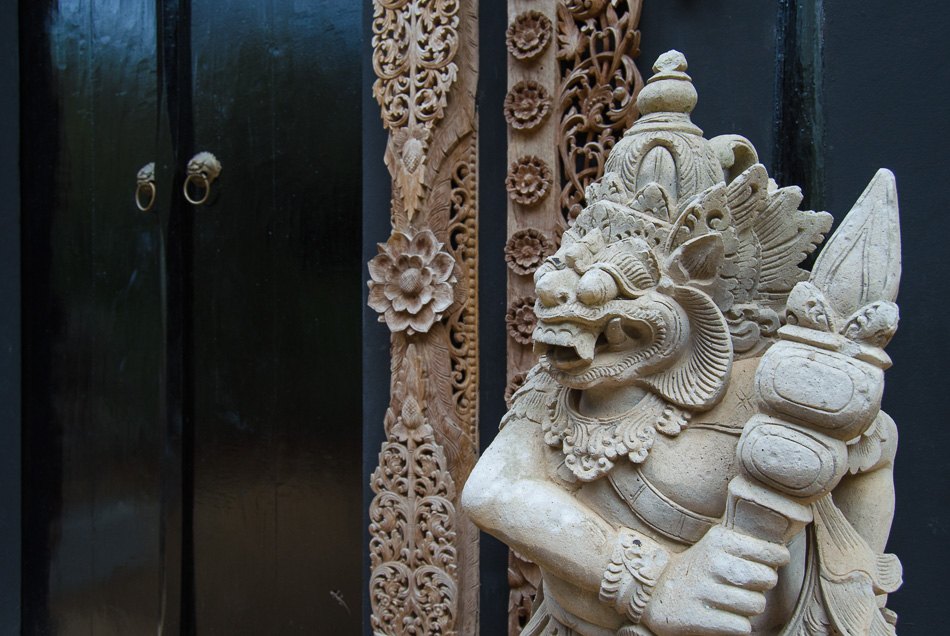
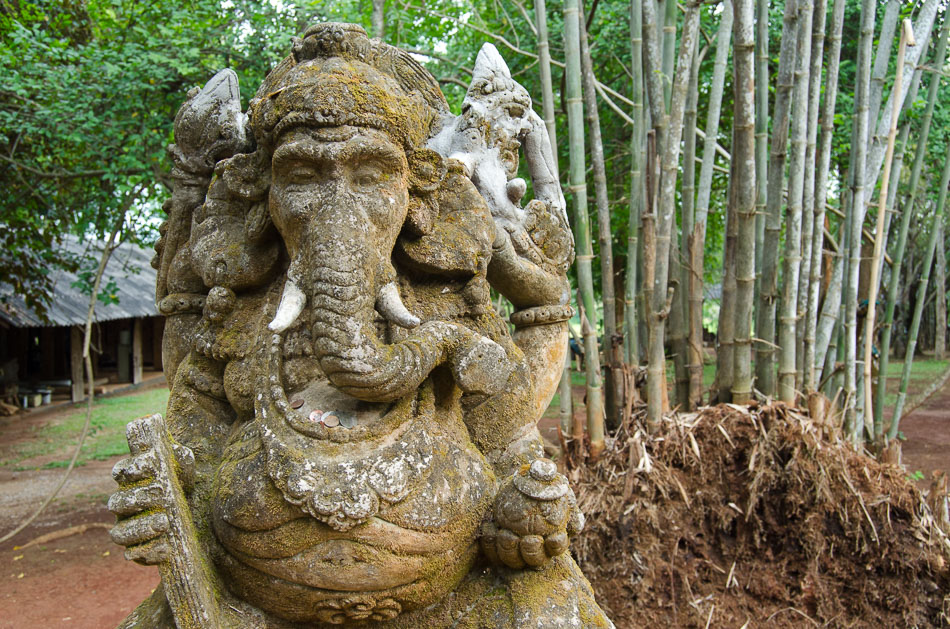
Some people see it as a commentary on Buddhist philosophies, while others state that his intention was to remind us of the darkness inside ourselves, and the imminent death of all things.
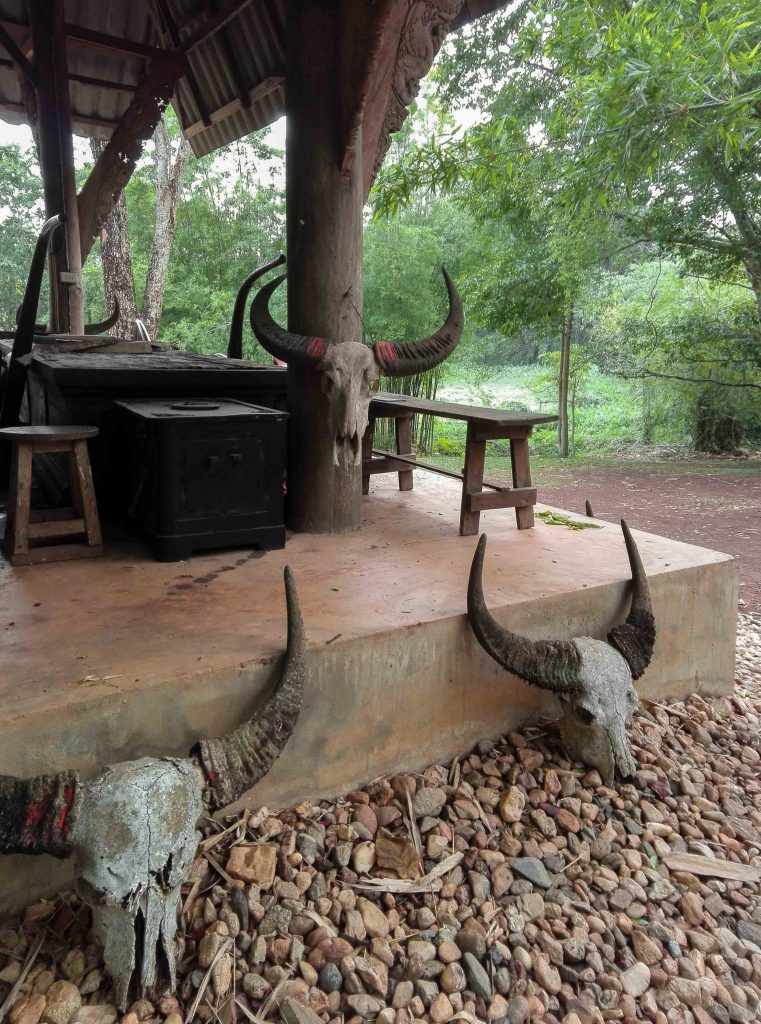
There’s a palpable, creepy vibe as you stroll around the park, but also a subversive sense of humor. It’s like the artist was trying to tell us: “Don’t take life too seriously, we’re all going to die”.
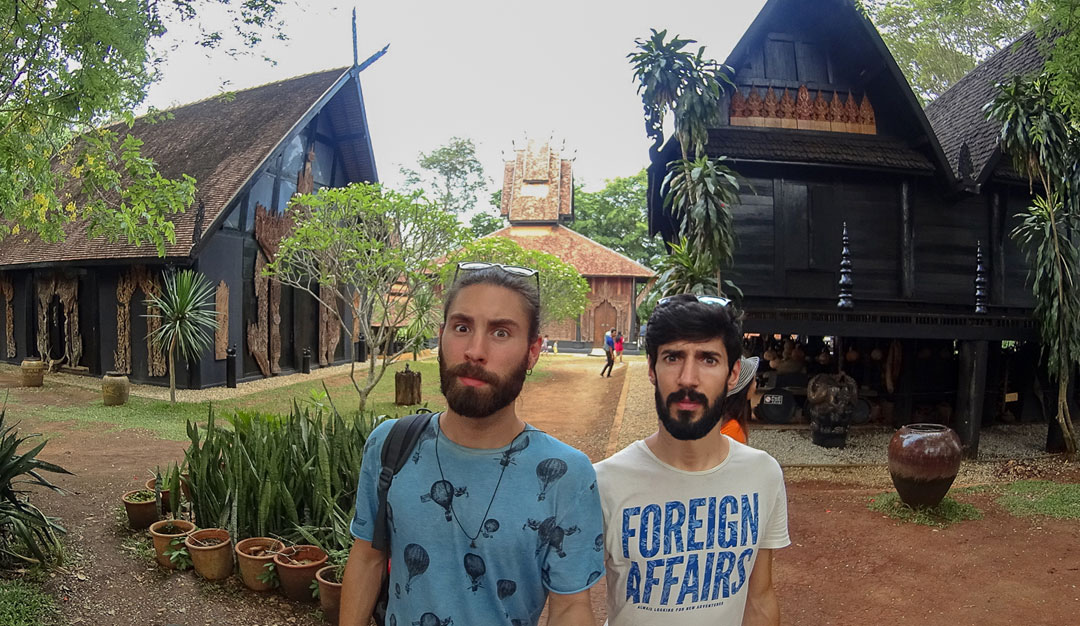
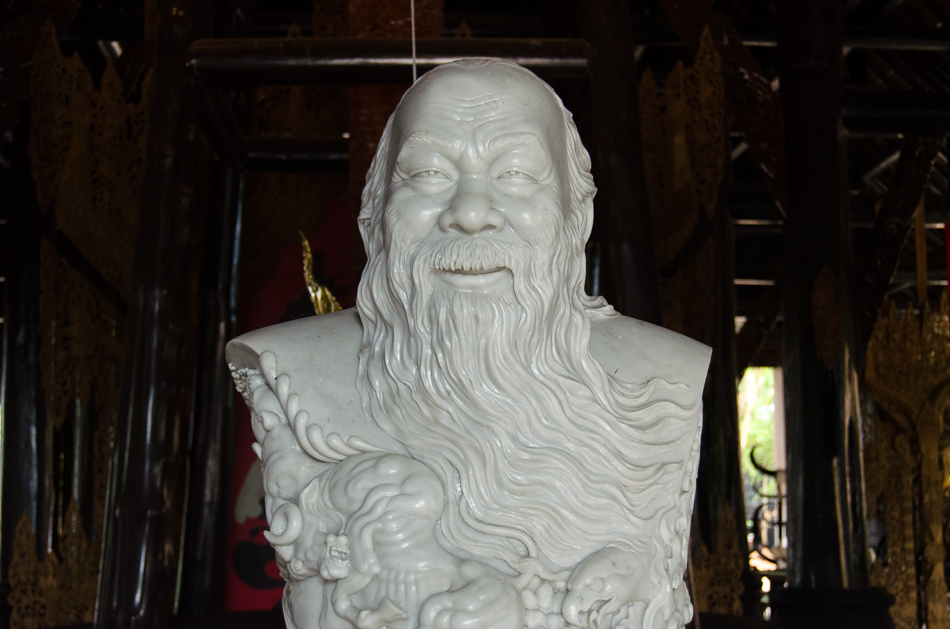
Portrait sculpture of Thawan Duchanee (1939-2014)
Back to Chiang Rai Bus Terminal
Head back towards the highway where you got off the bus and hail to any bus you see going in Chiang Rai direction — either the green ones you came in or the grey mini-buses. Have in mind that there’s no bus stop there.
The trip back to Chiang Rai is a further 20 THB.
Transportation alternatives
Hire a songthaew in Chiang Rai for about 300 Baht for the round trip. They’ll try to charge you more, so be ready to negotiate.
Any travel agency in Chiang Rai sells organized tours to Baam Dam that often include a visit to Wat Rong Khun. Prices will vary from agency to agency, so look around for the best deal.
Have in mind that departure and arrival times will be scheduled to fit everything on a tour. So you will be rushed.
Can we ask for a favor?
It’s likely that a ticket office will open in the back entrance. So if you try the rear entrance route, let us know if you were able to buy your tickets there — it’ll help other travelers.
Thanks in advance!
